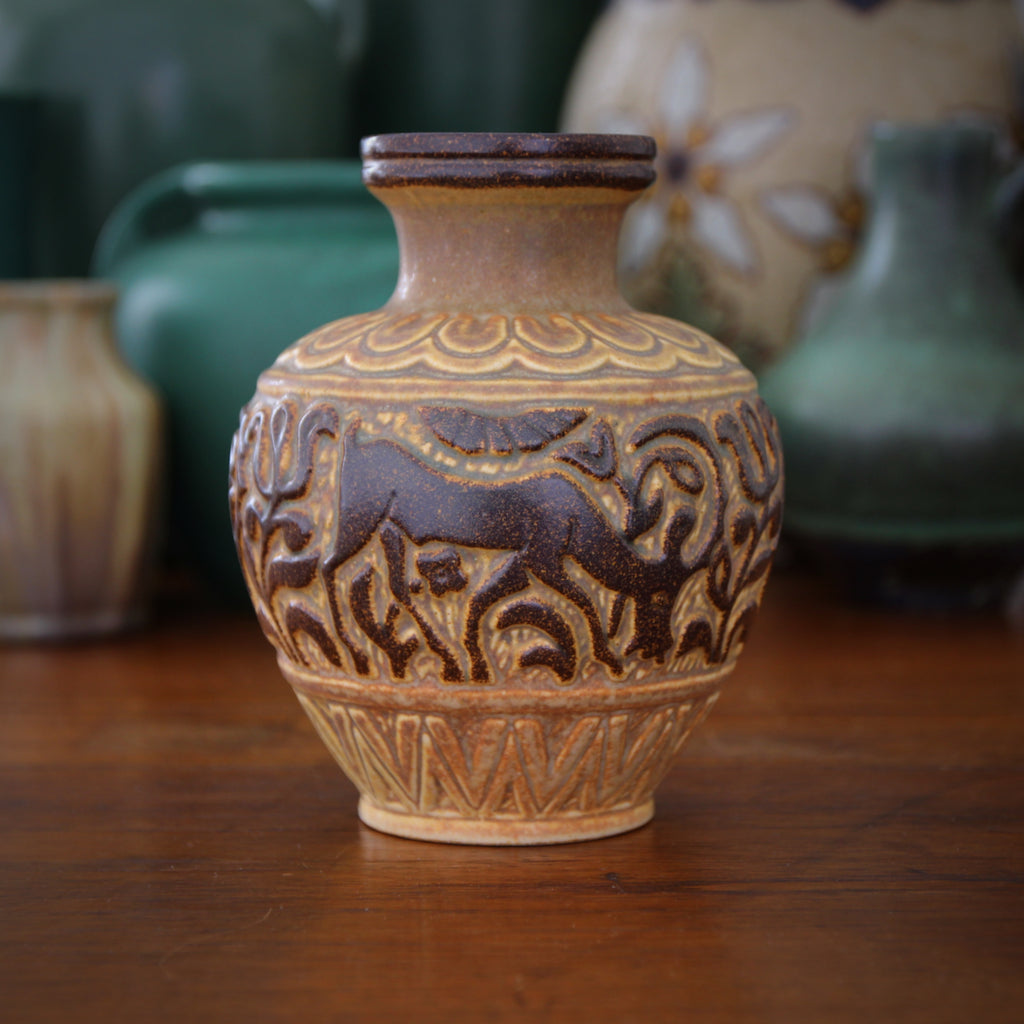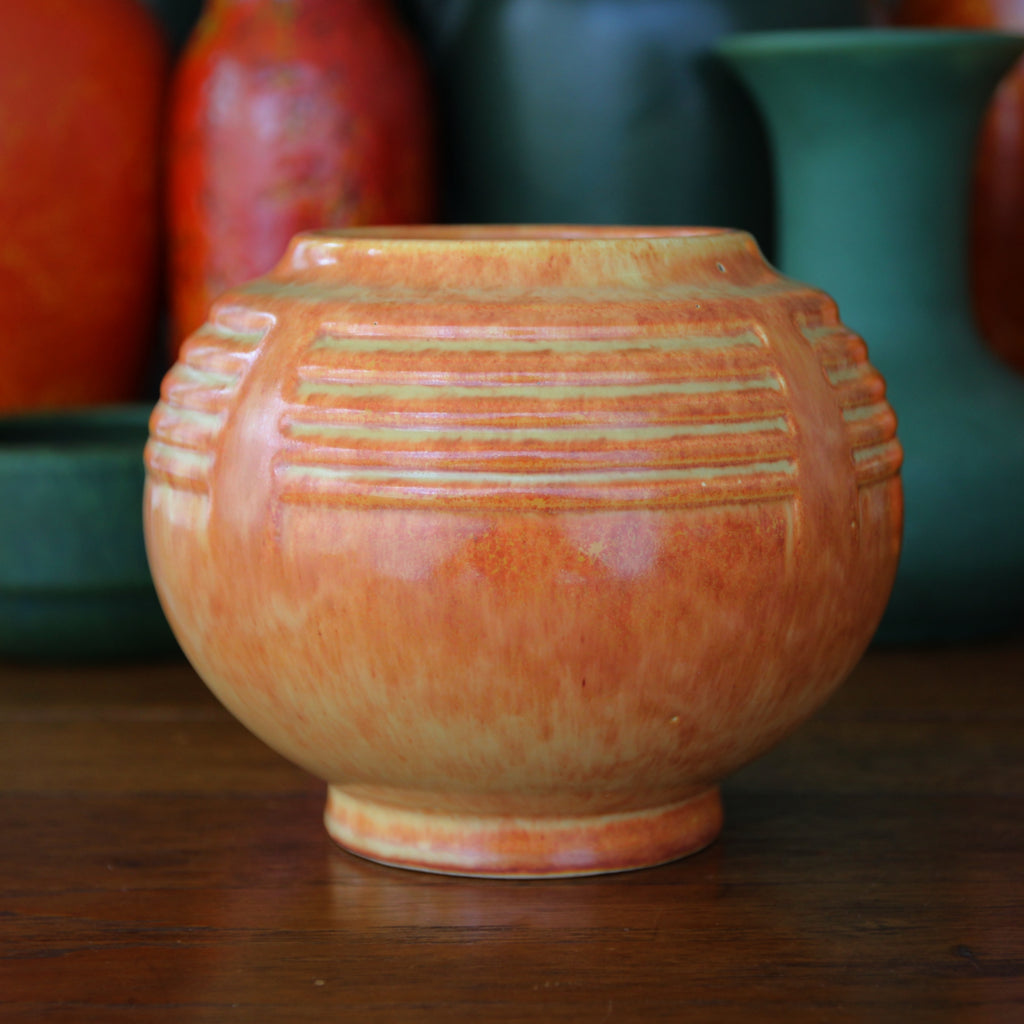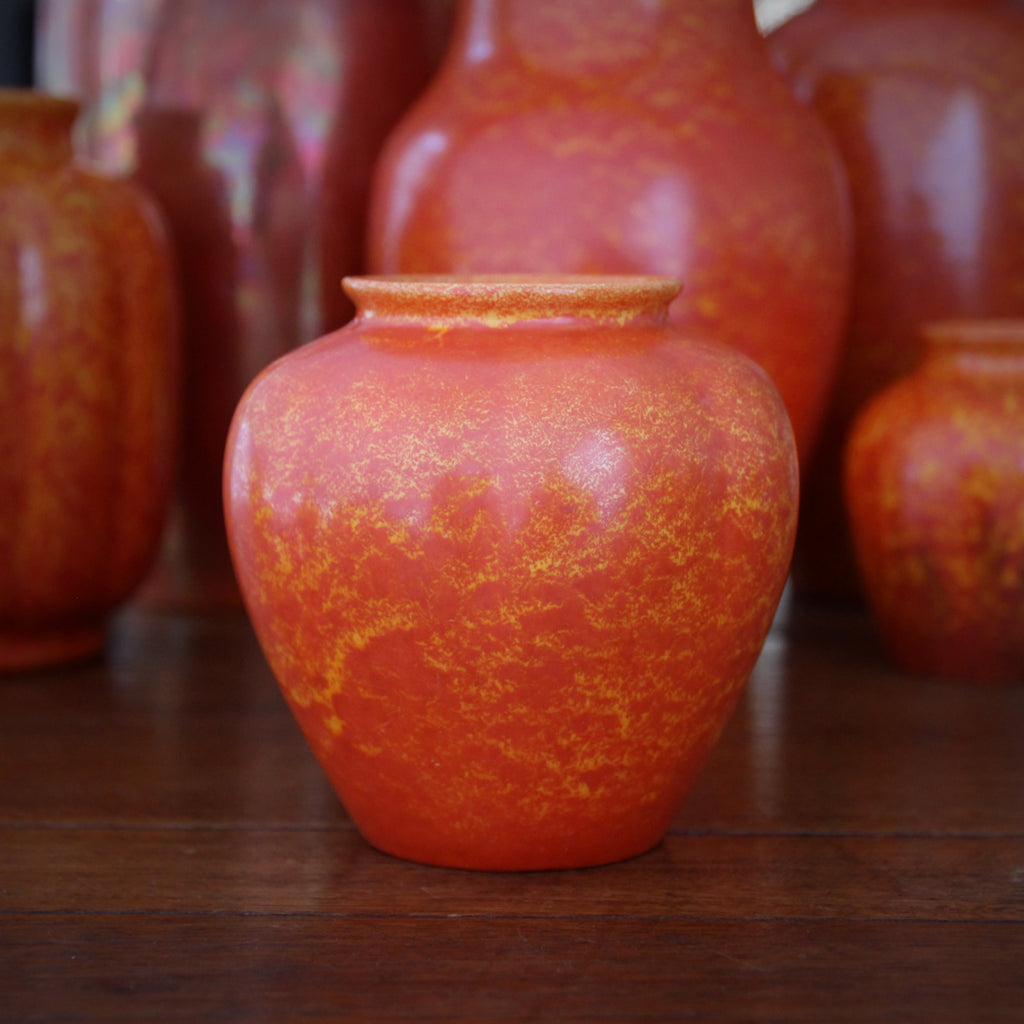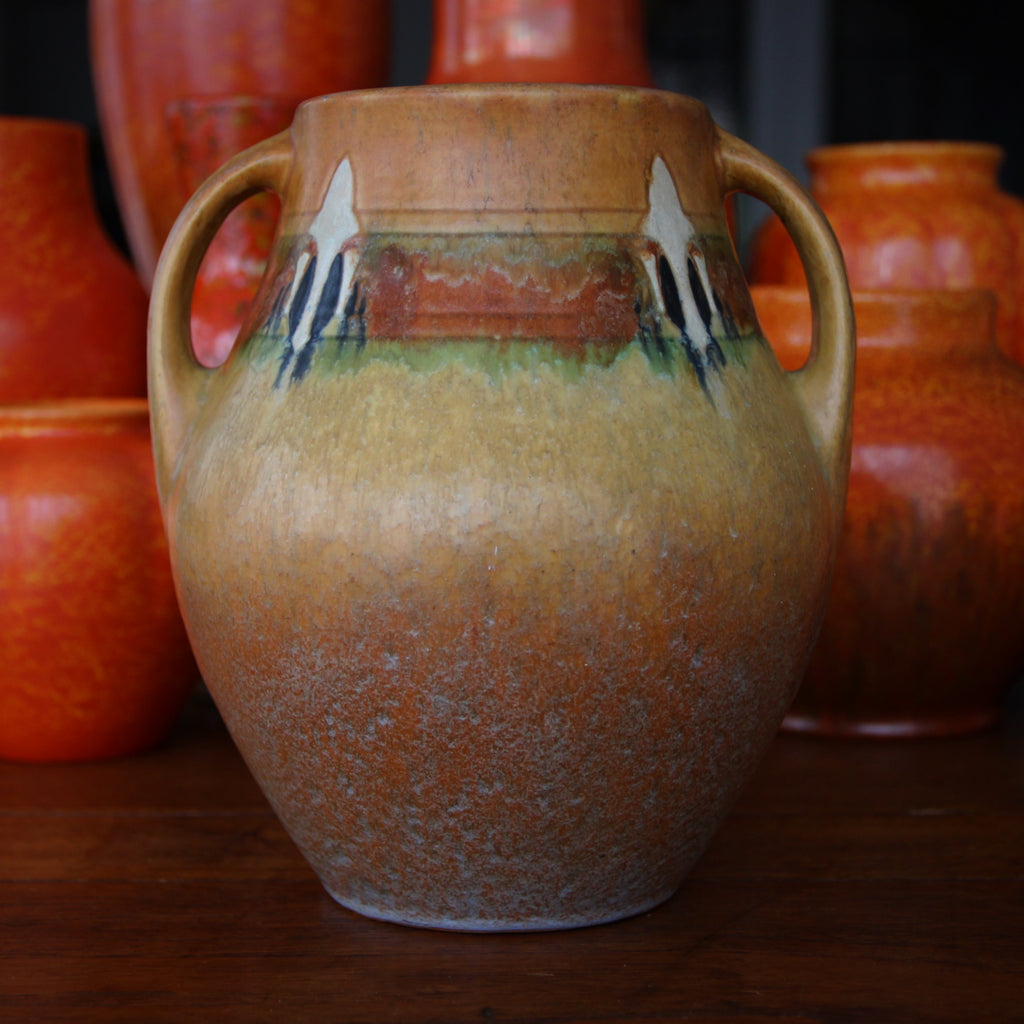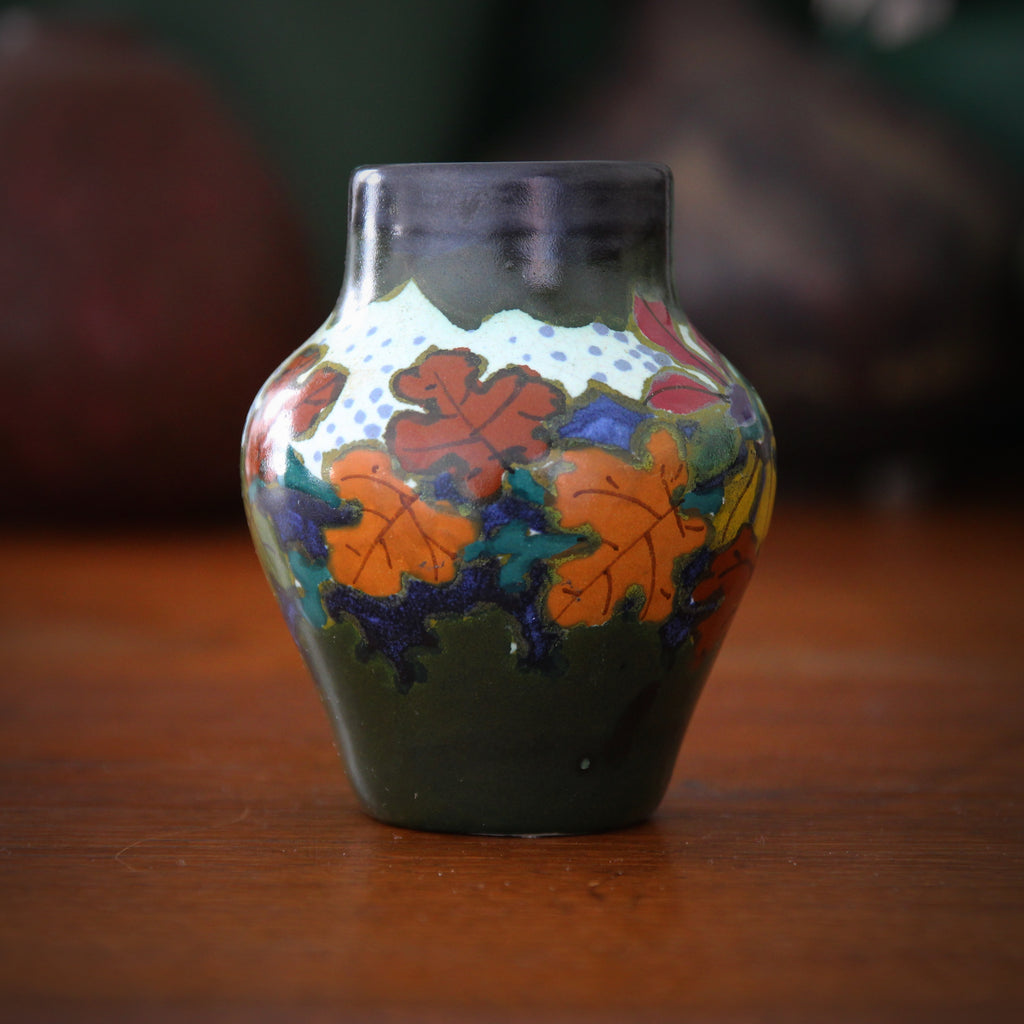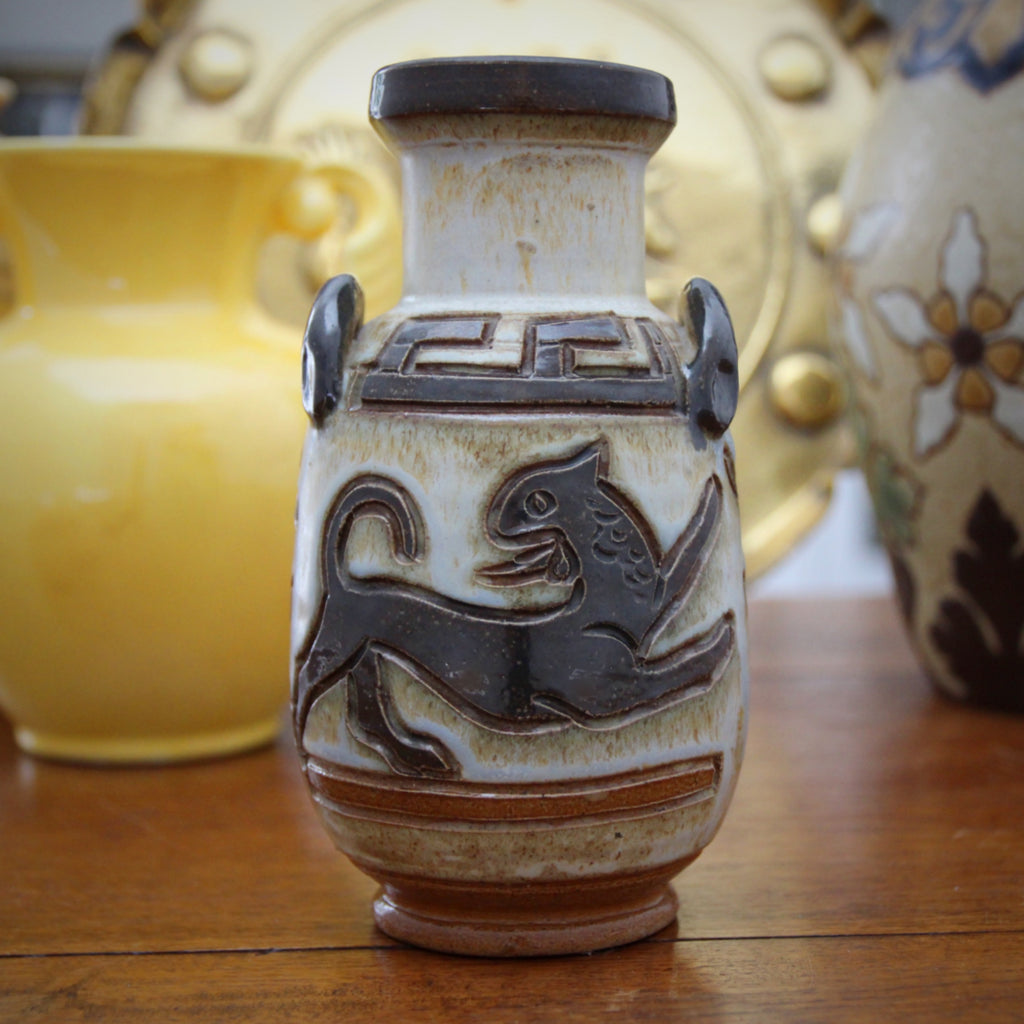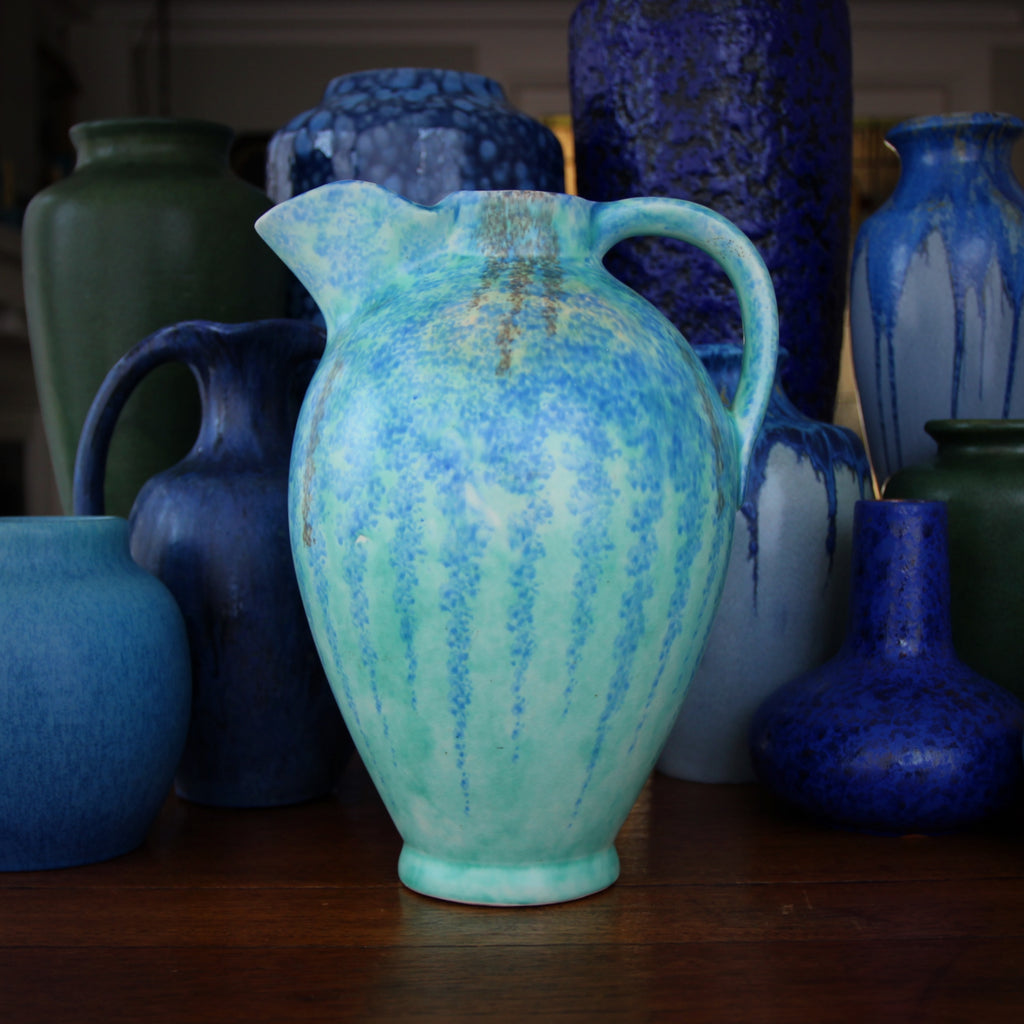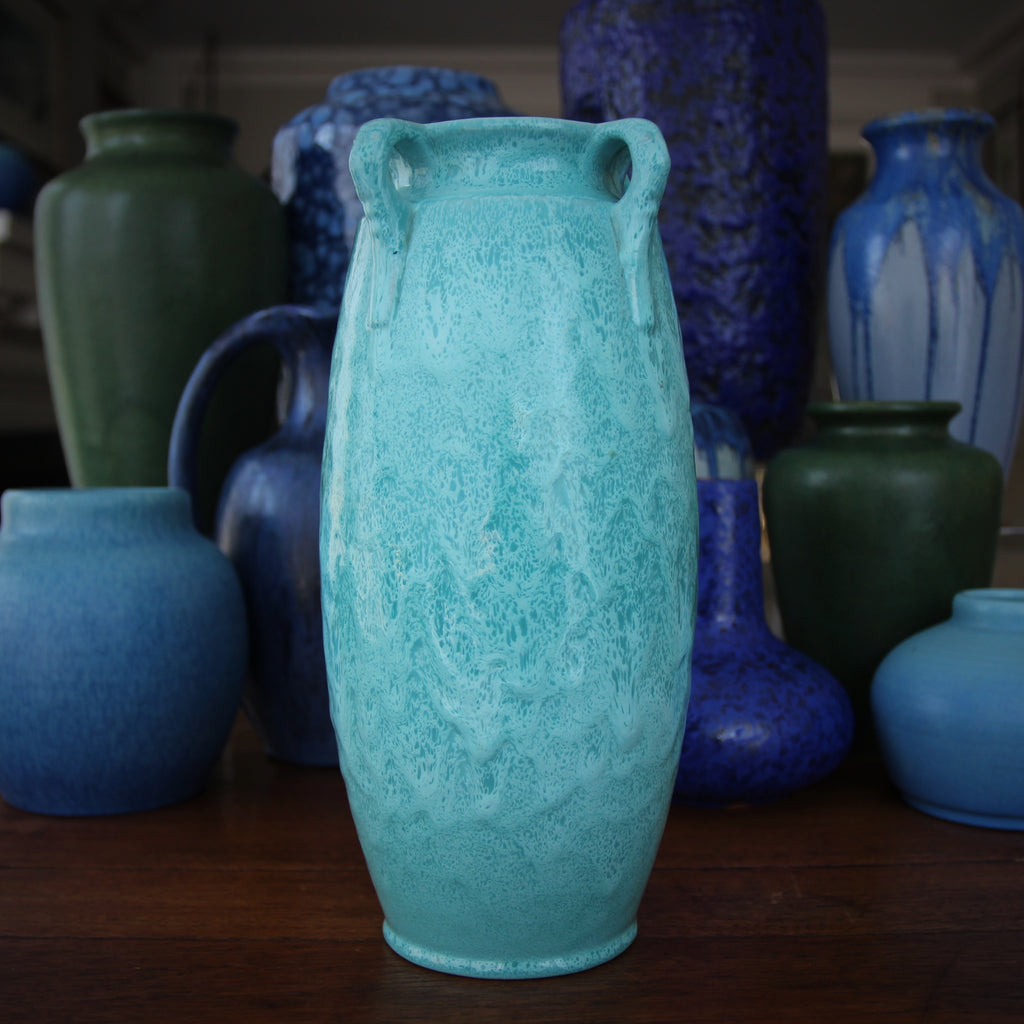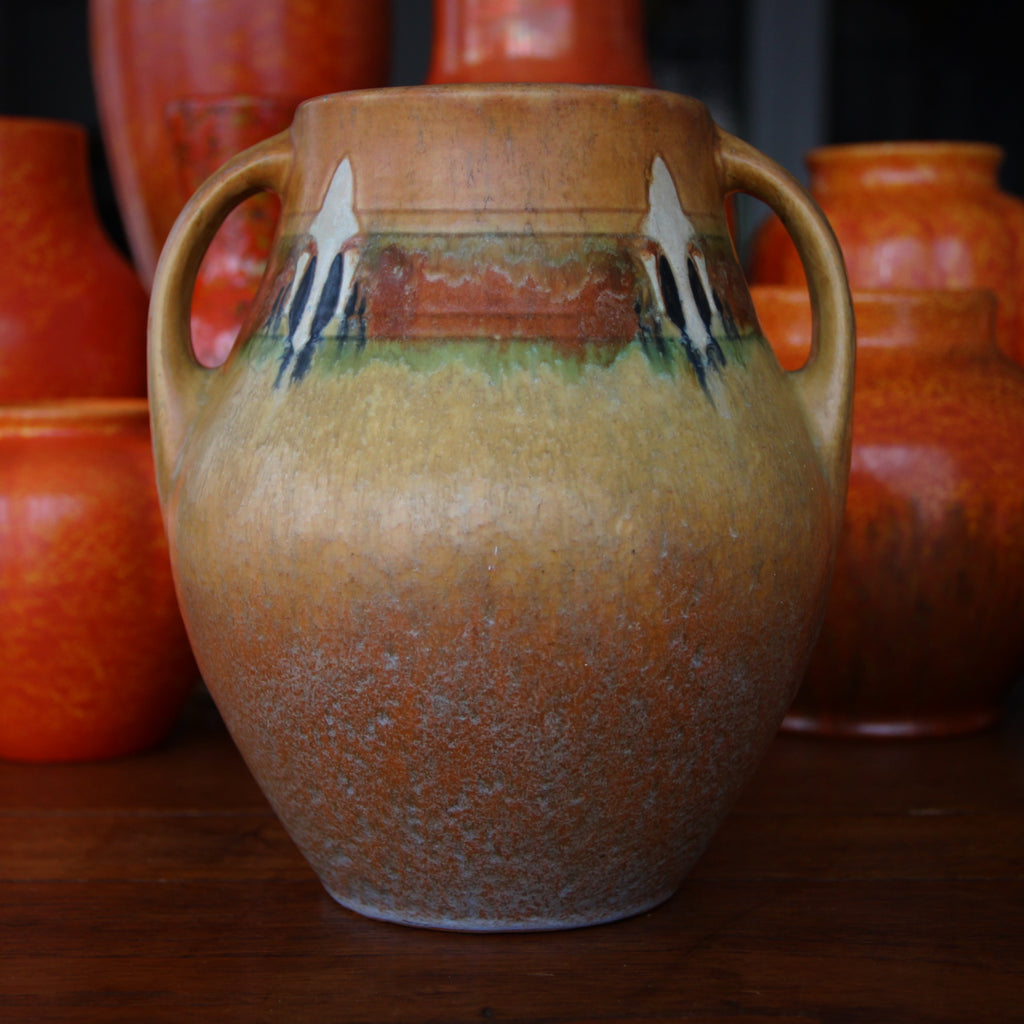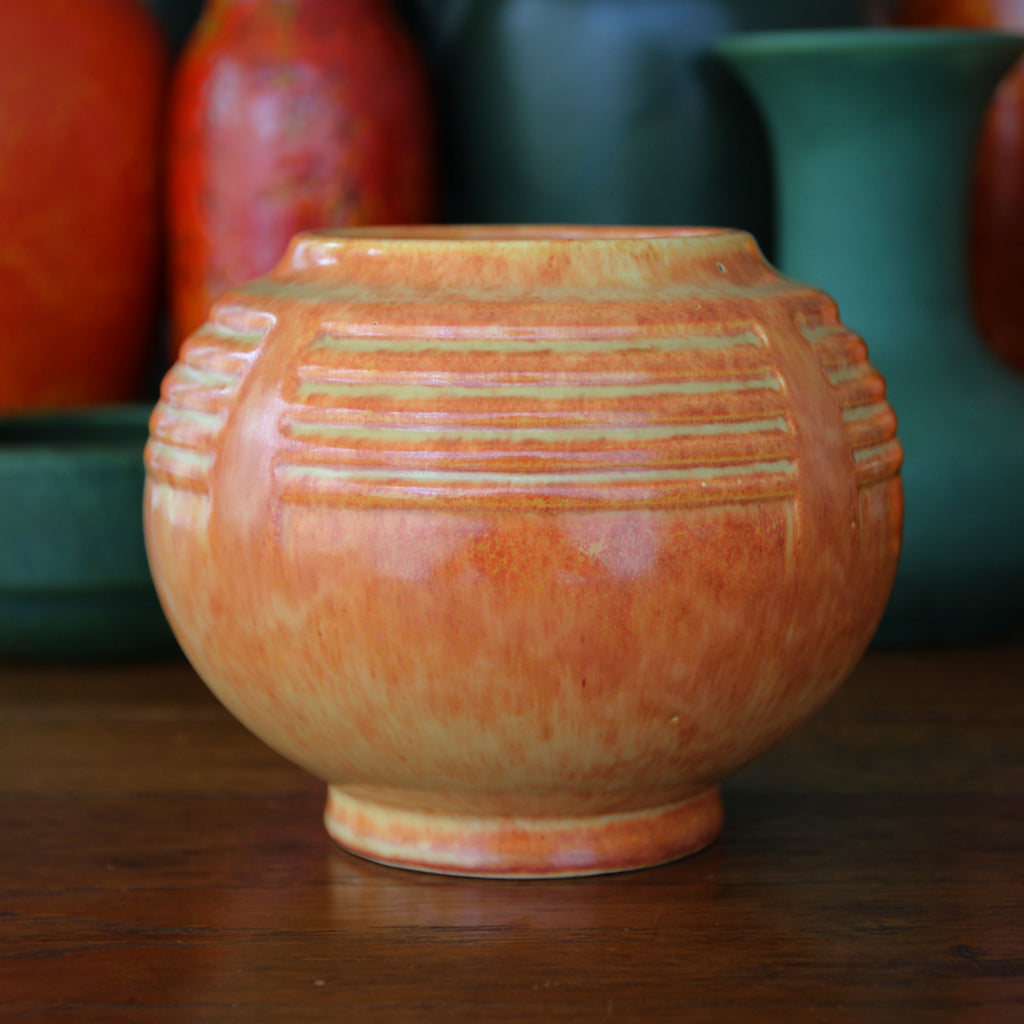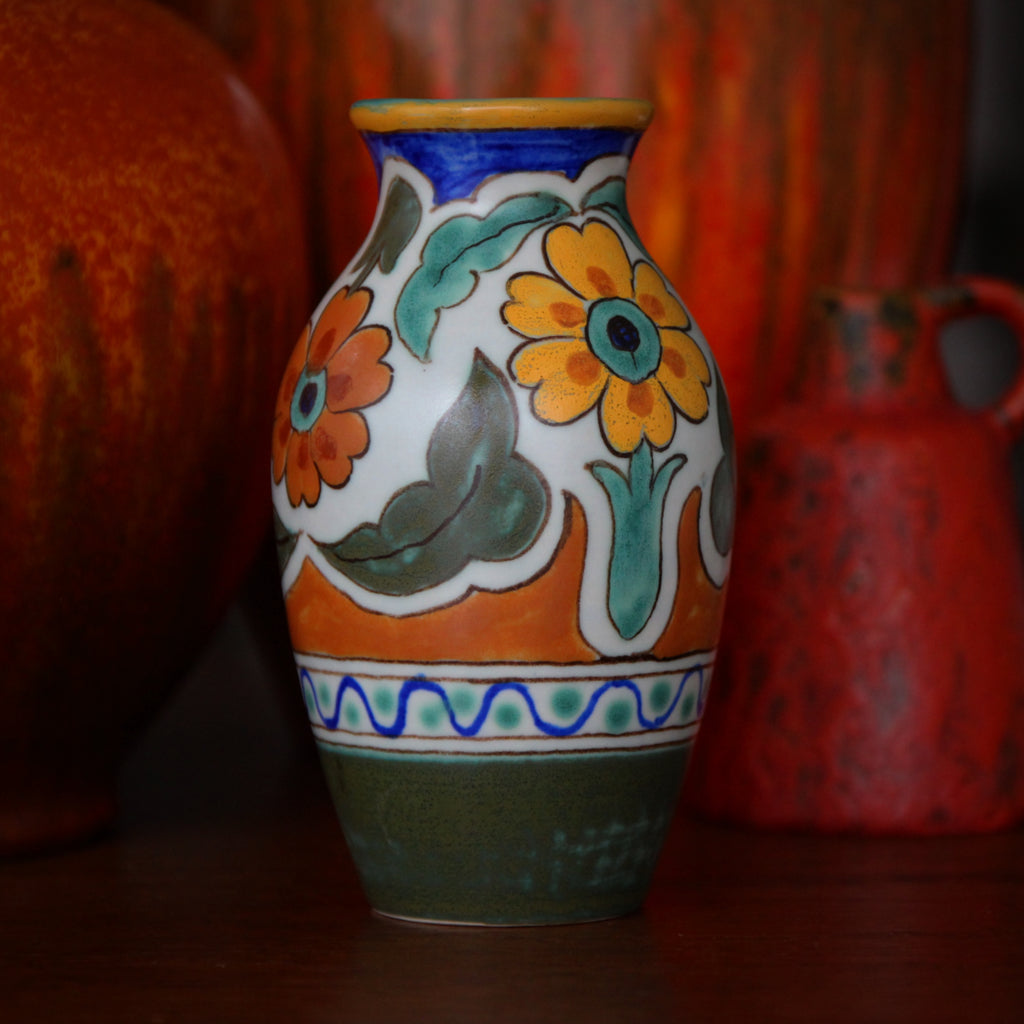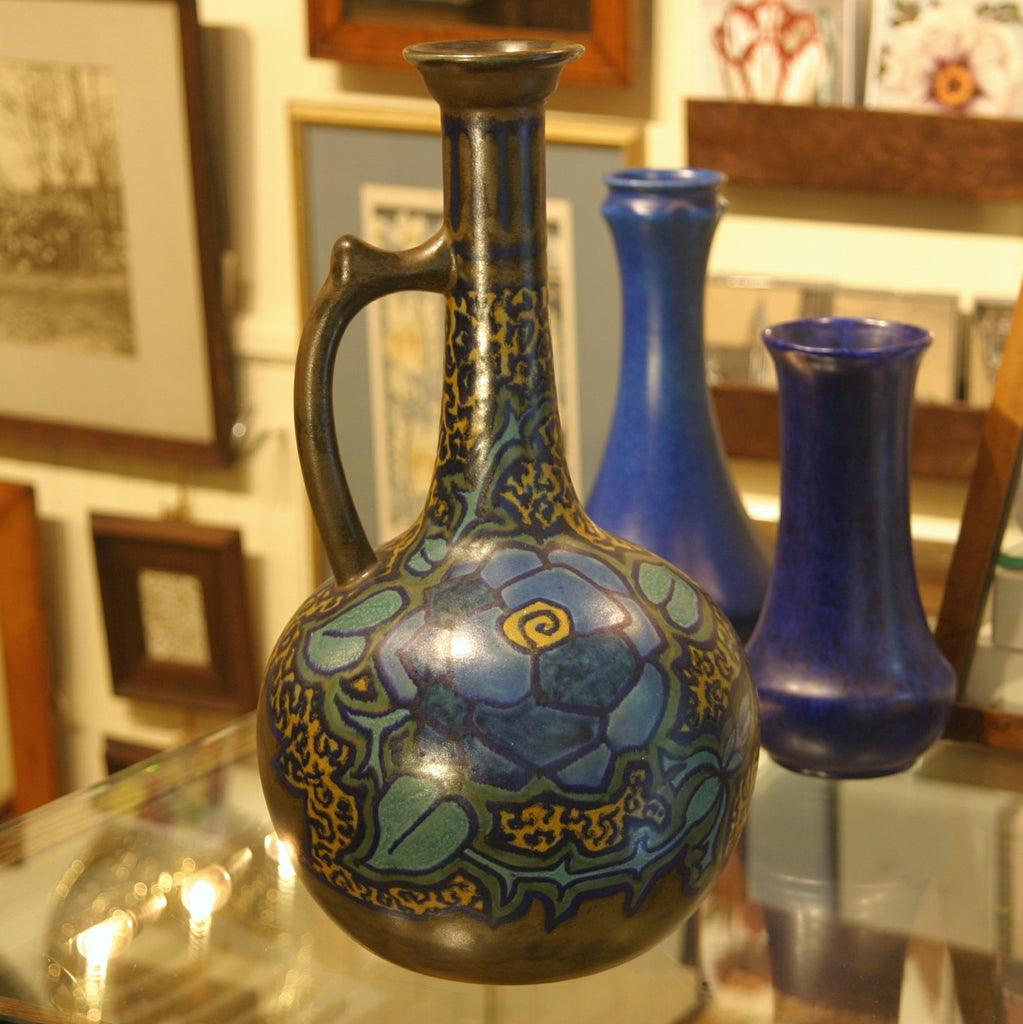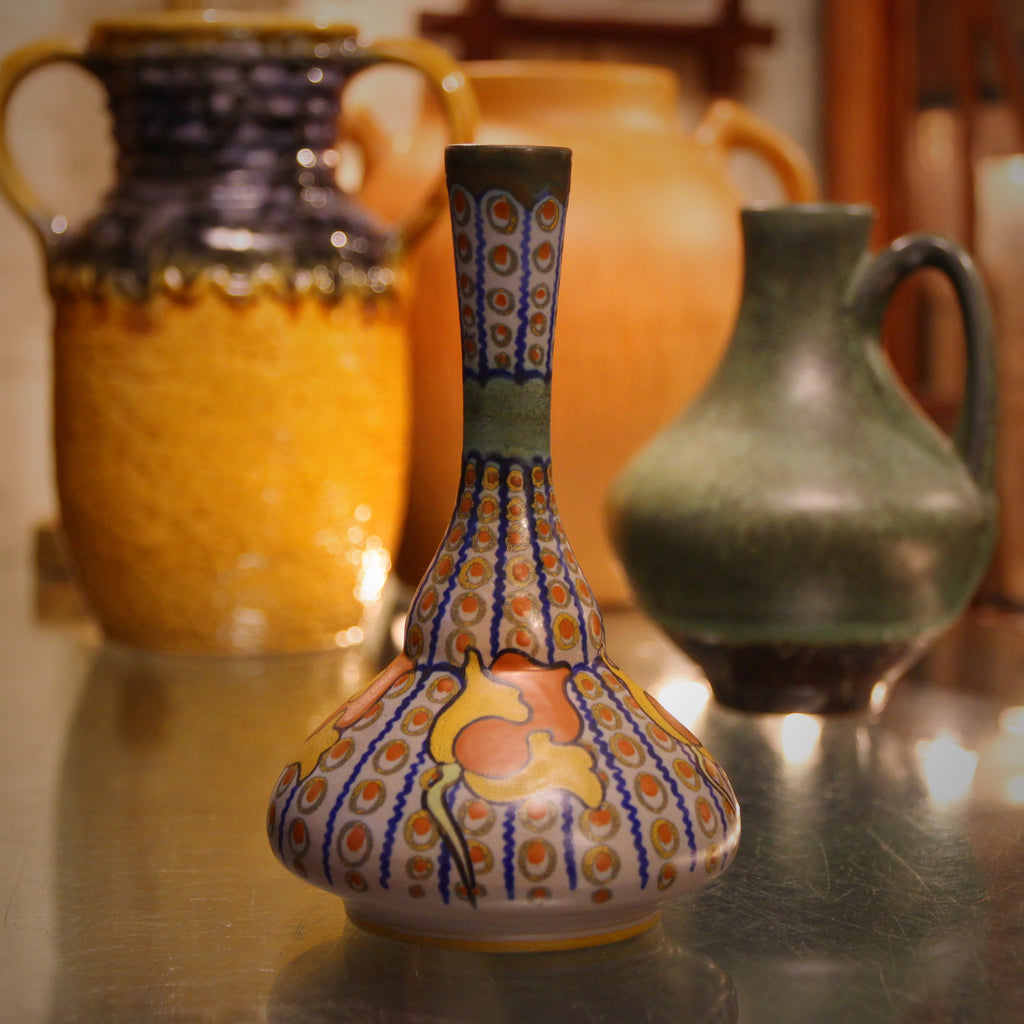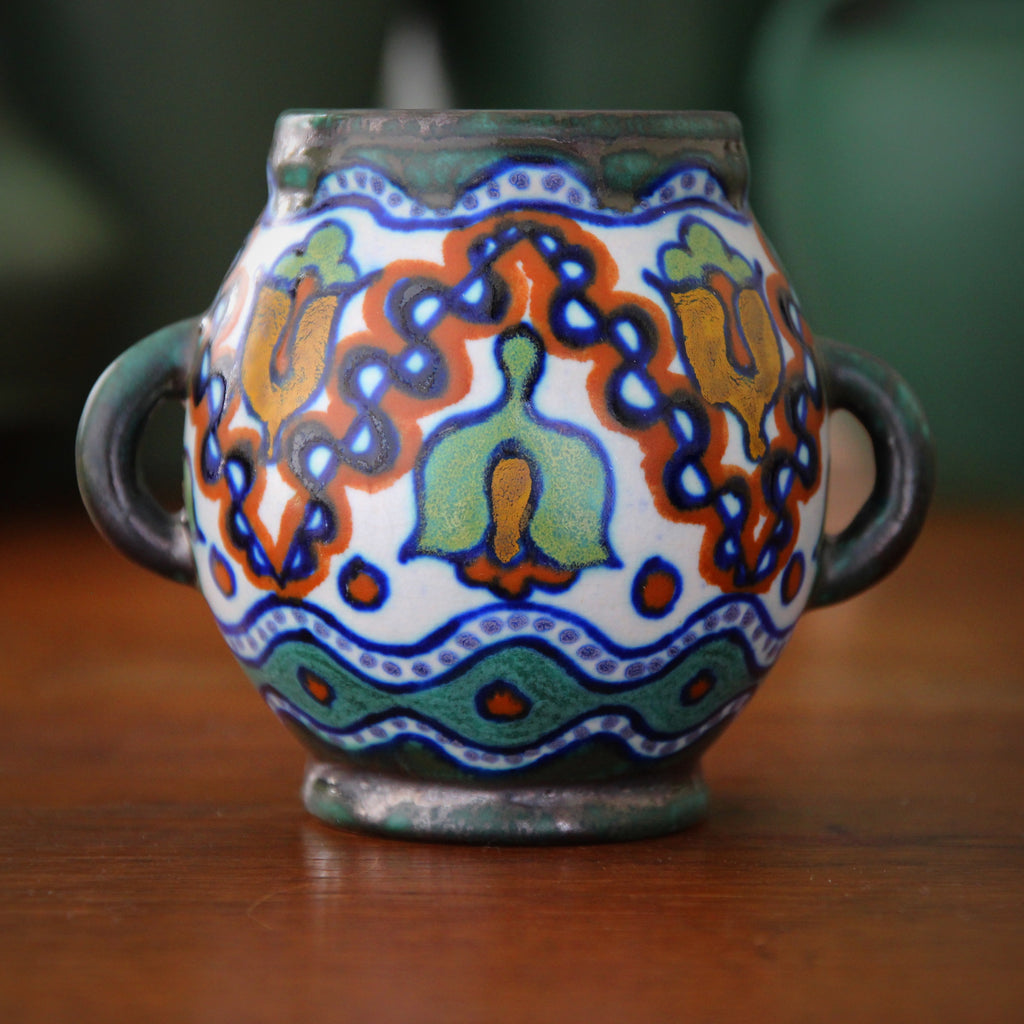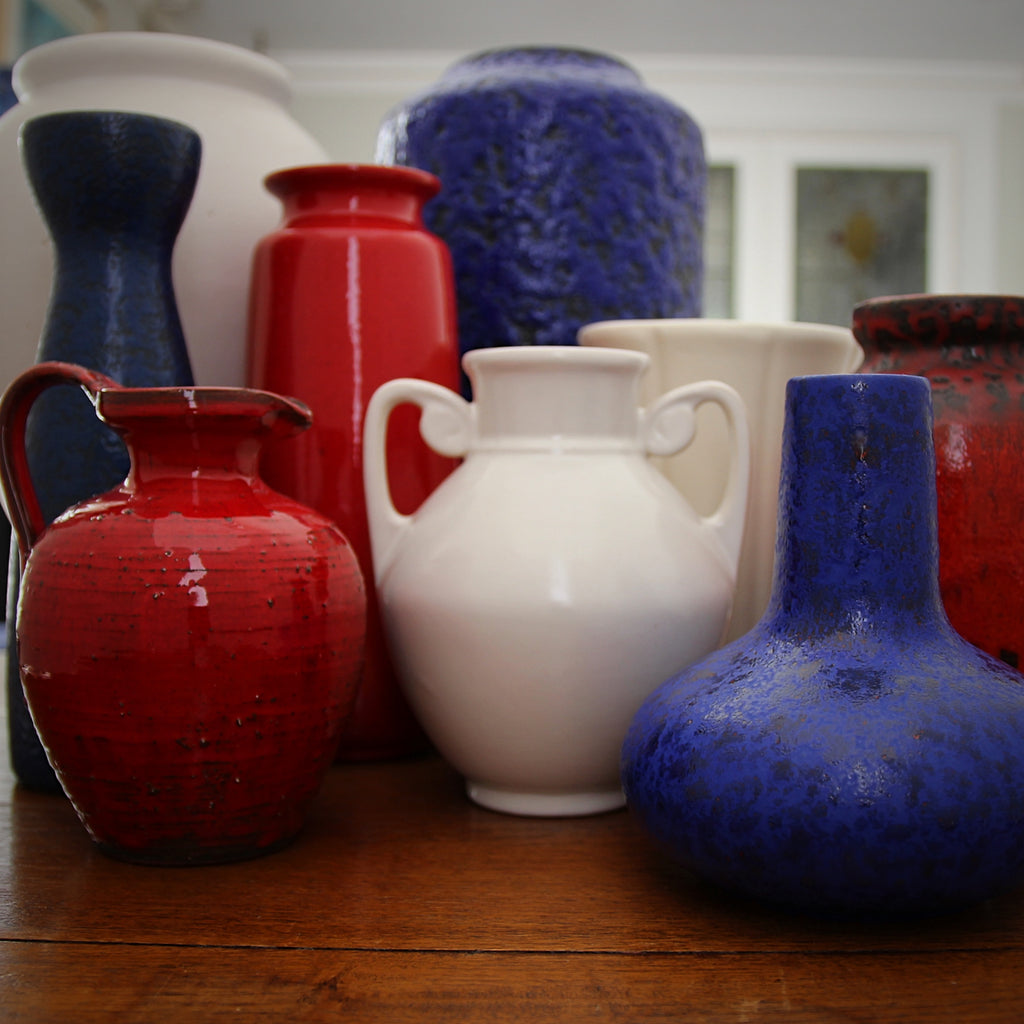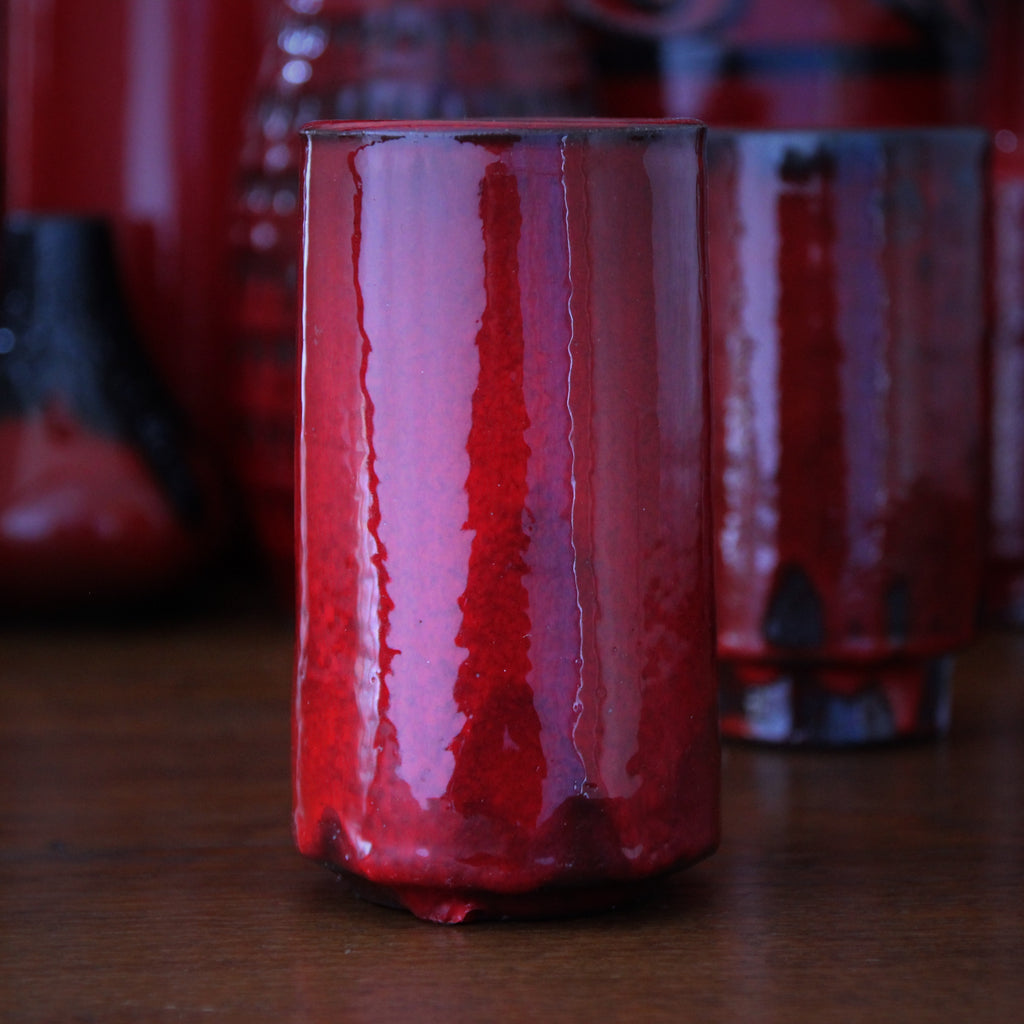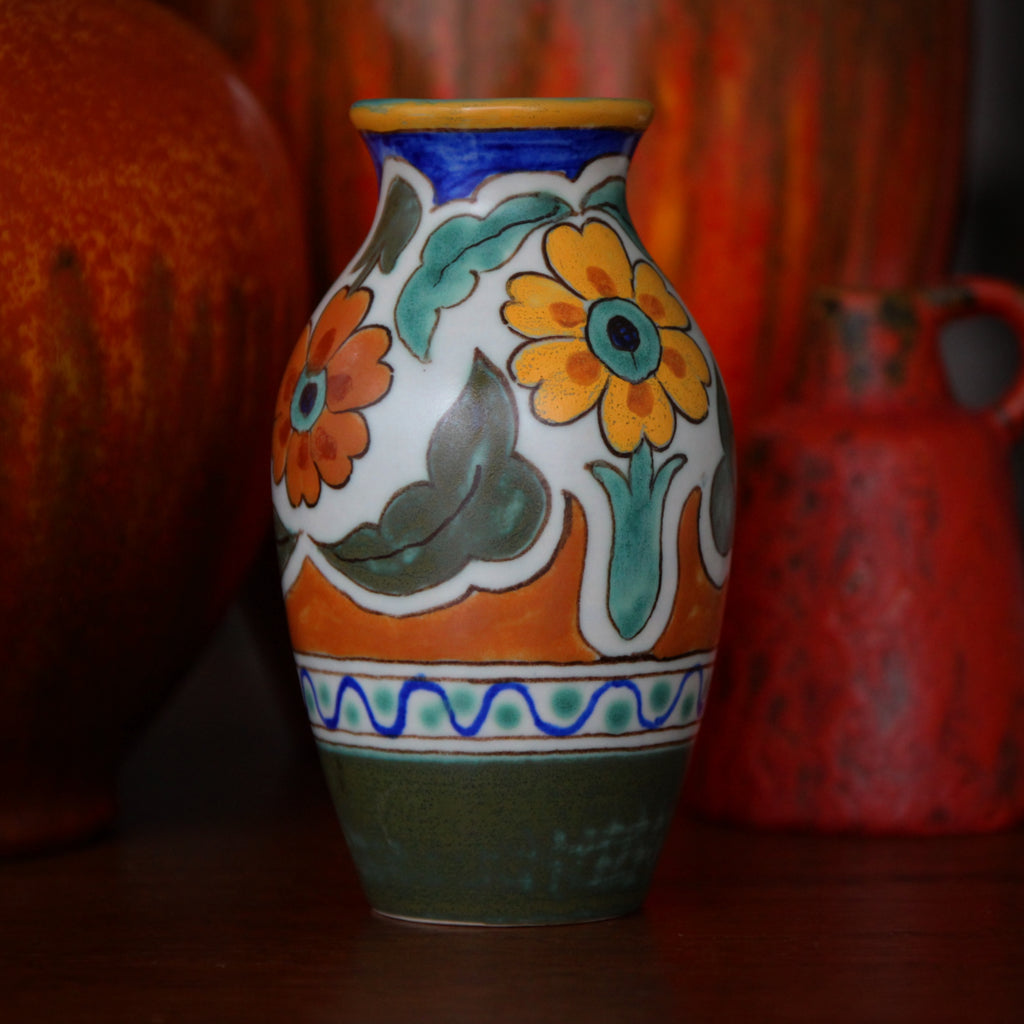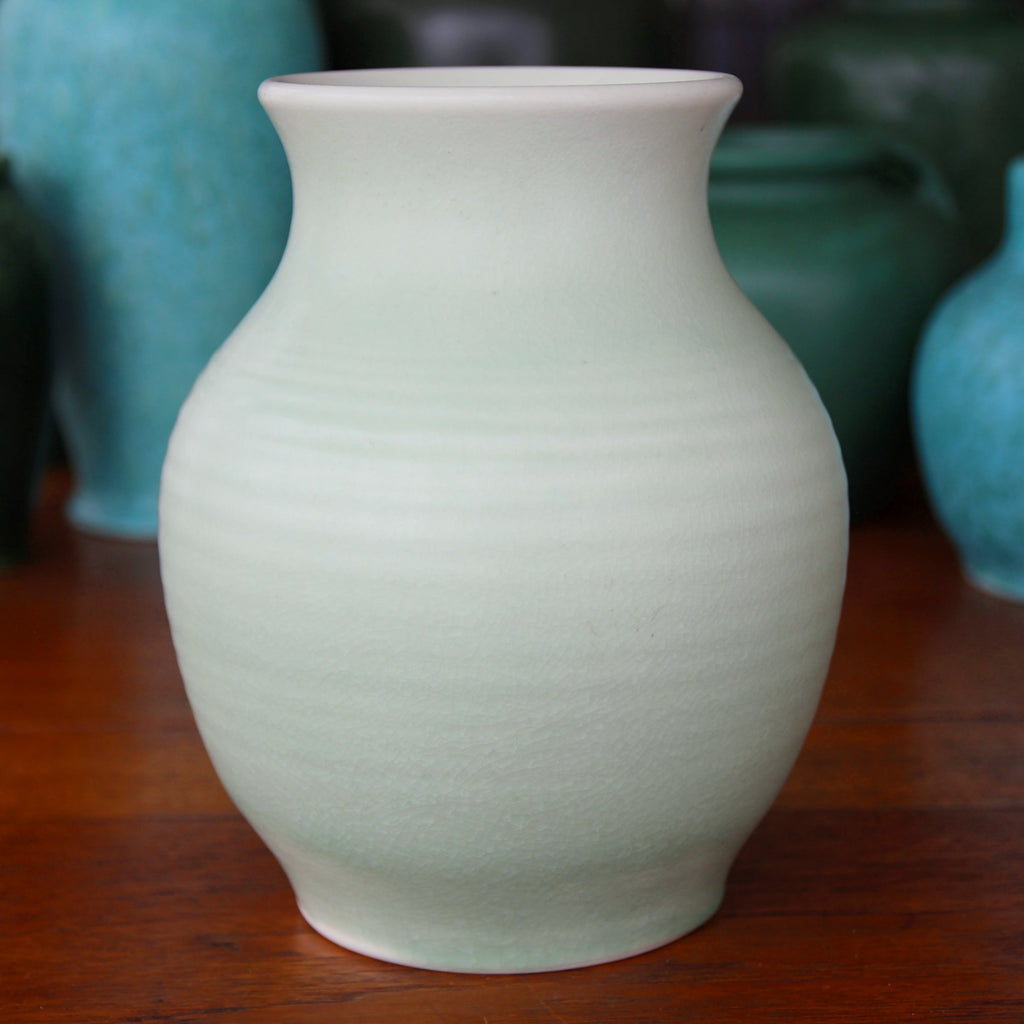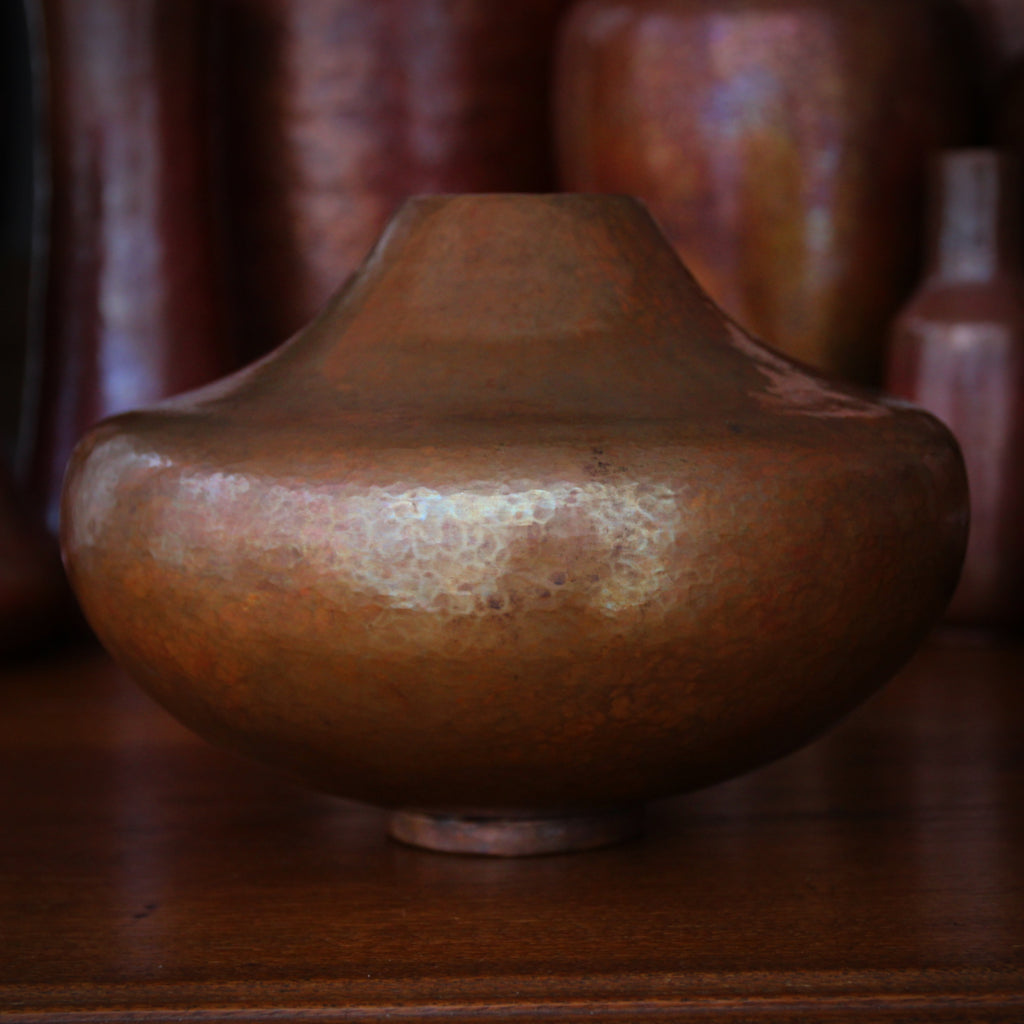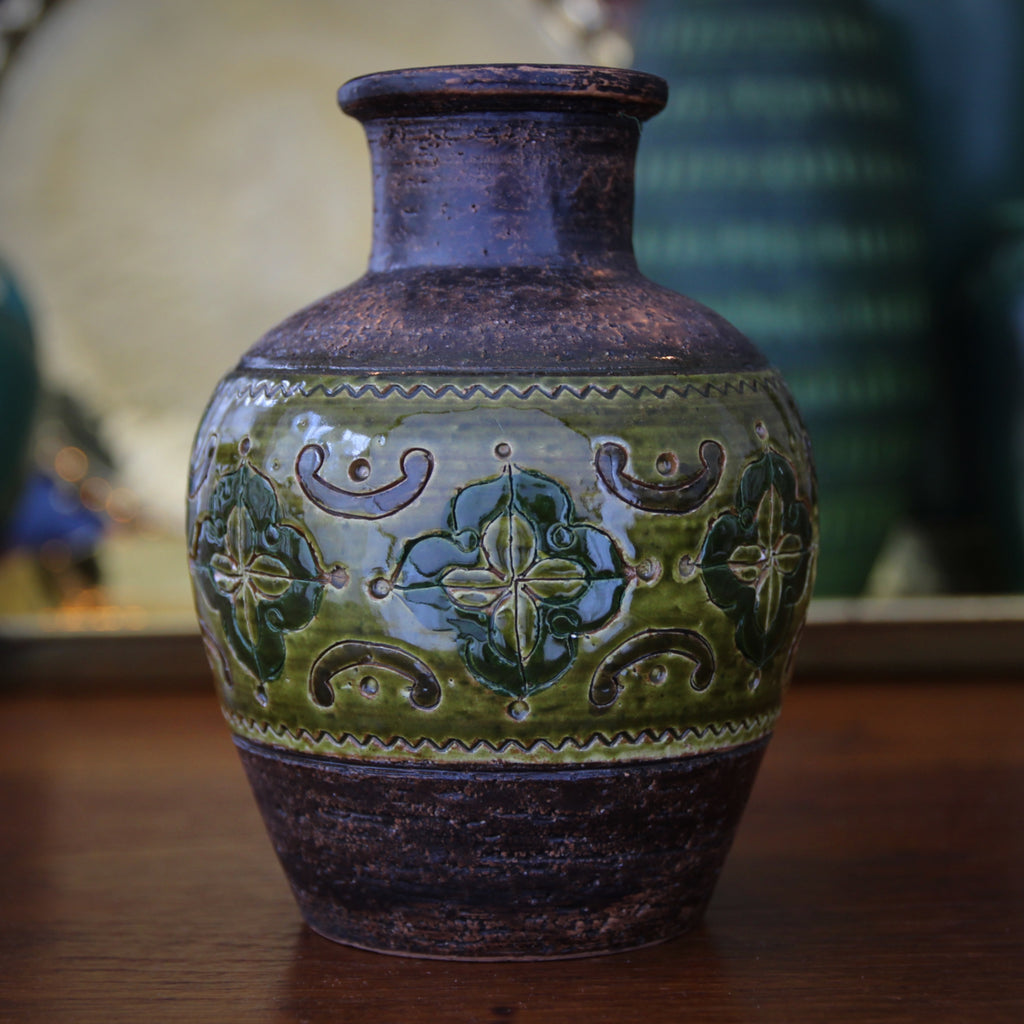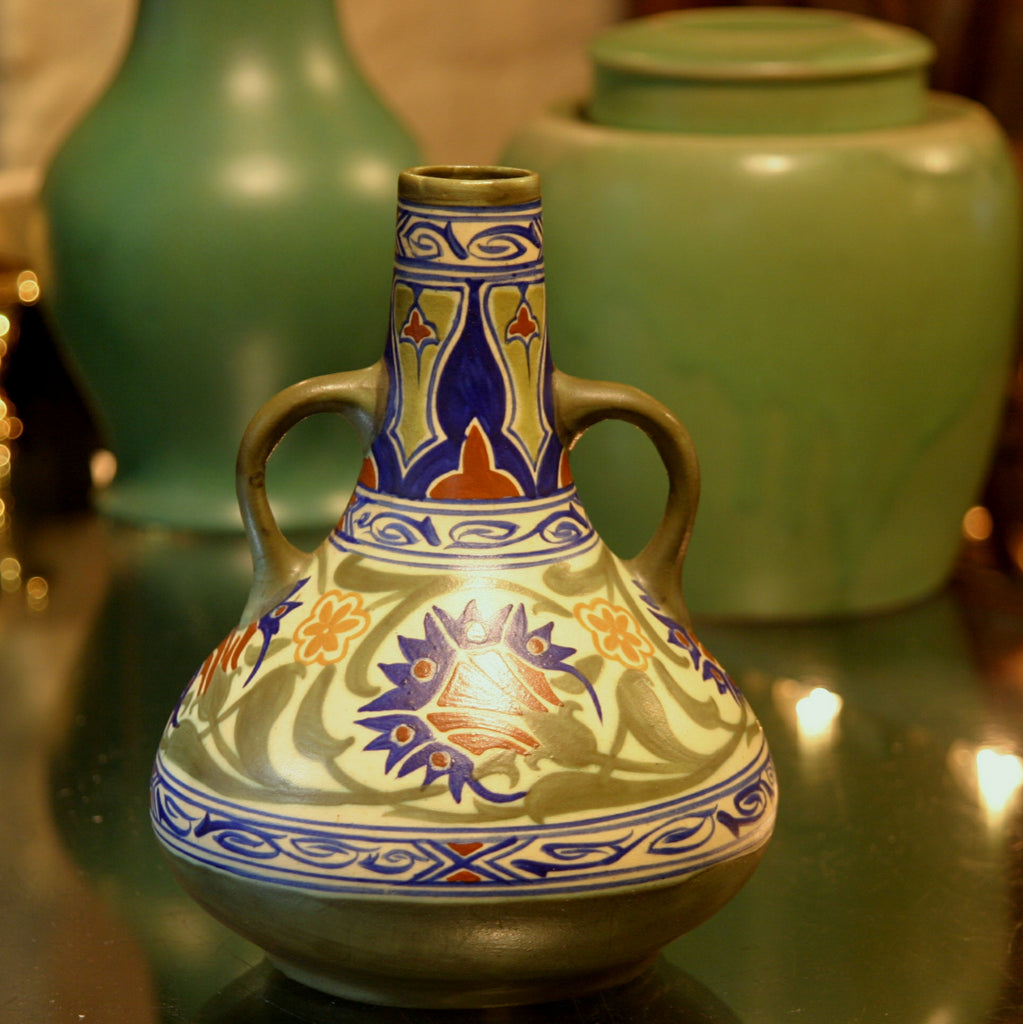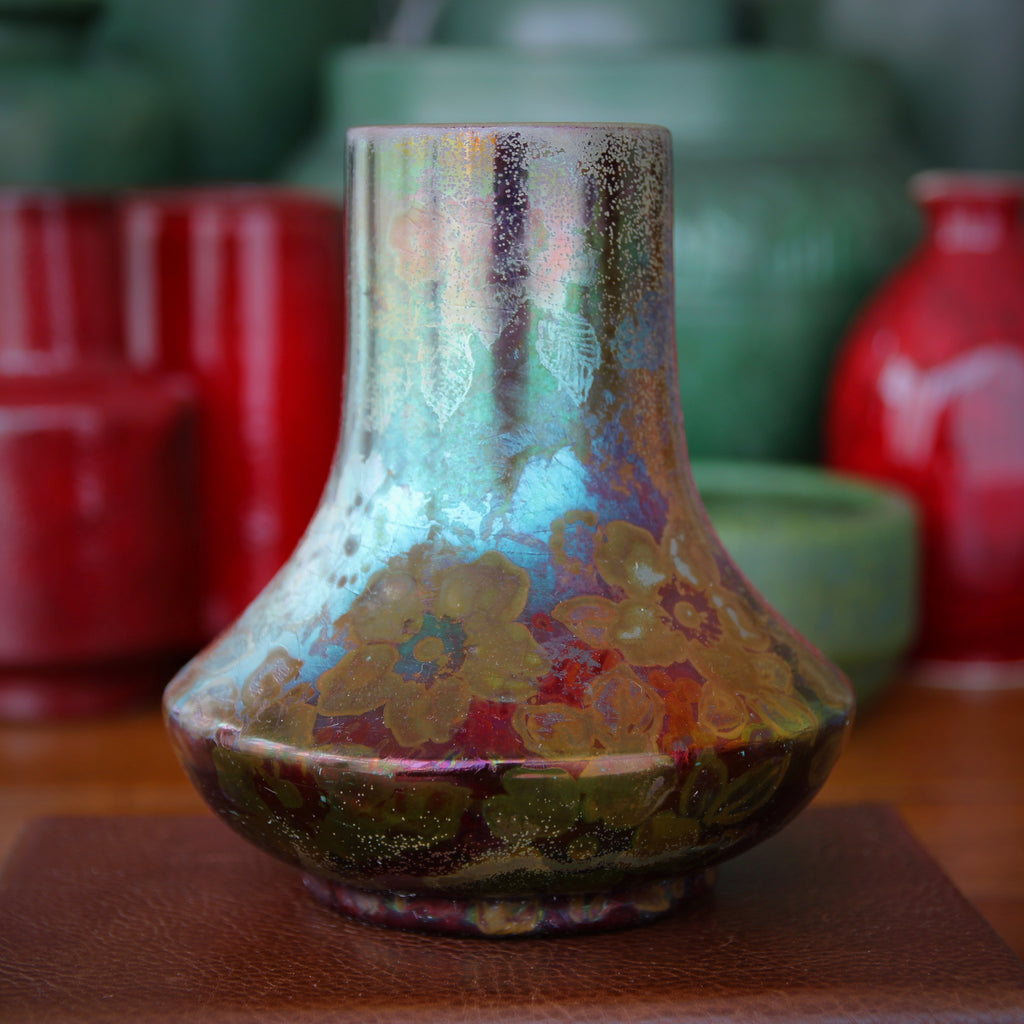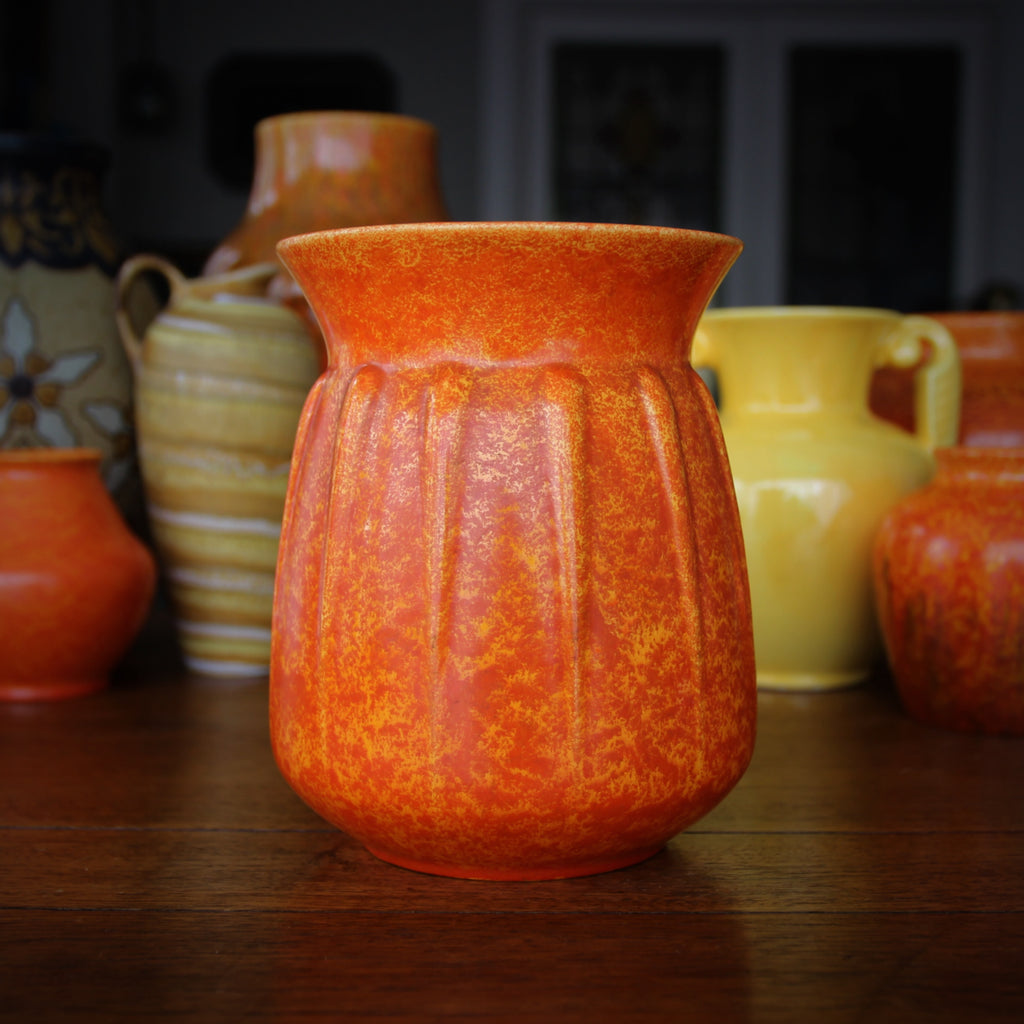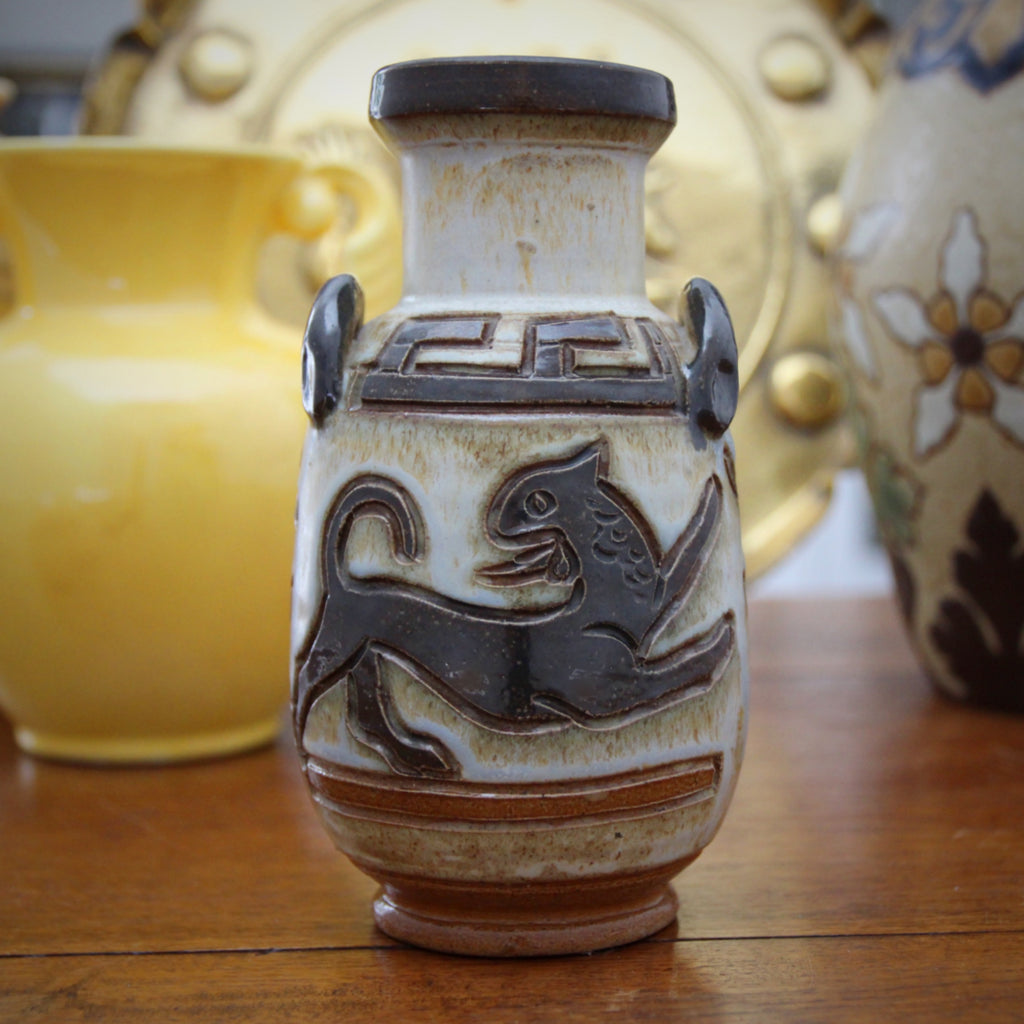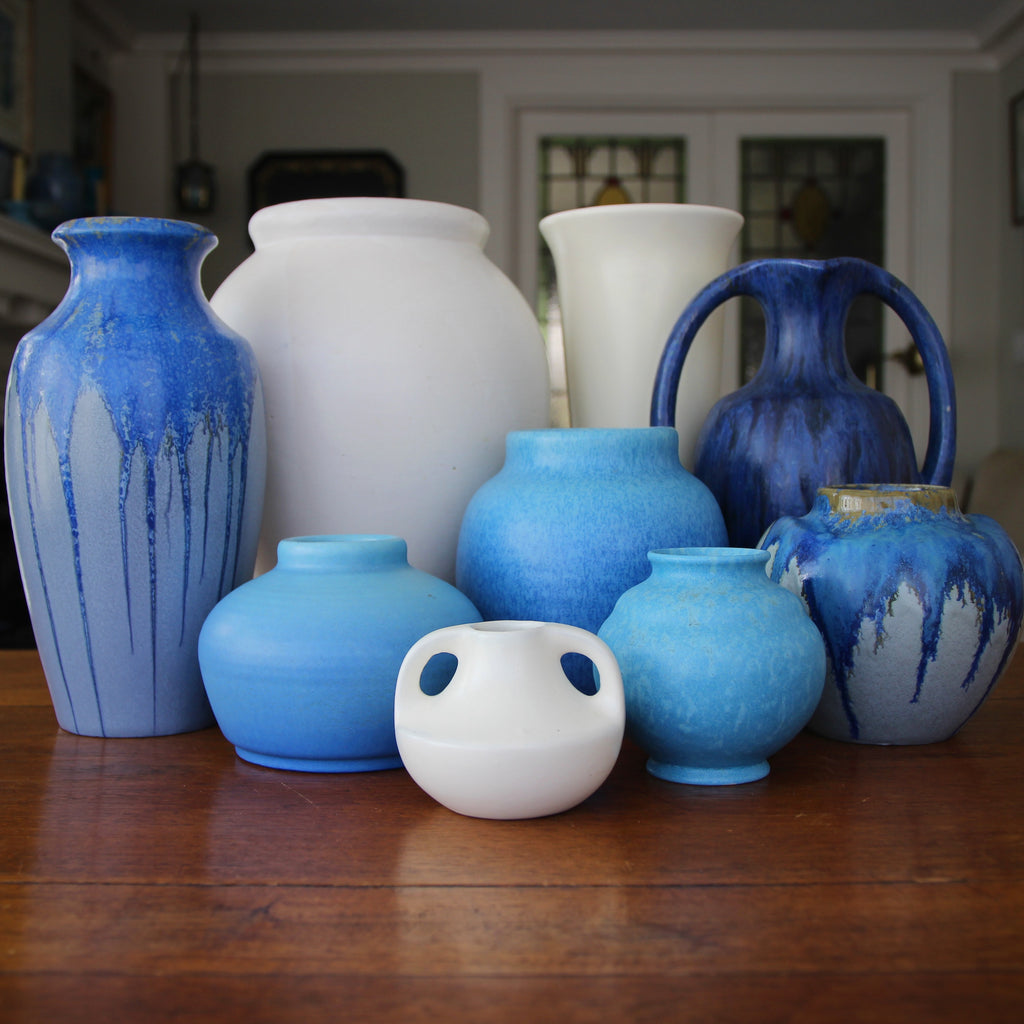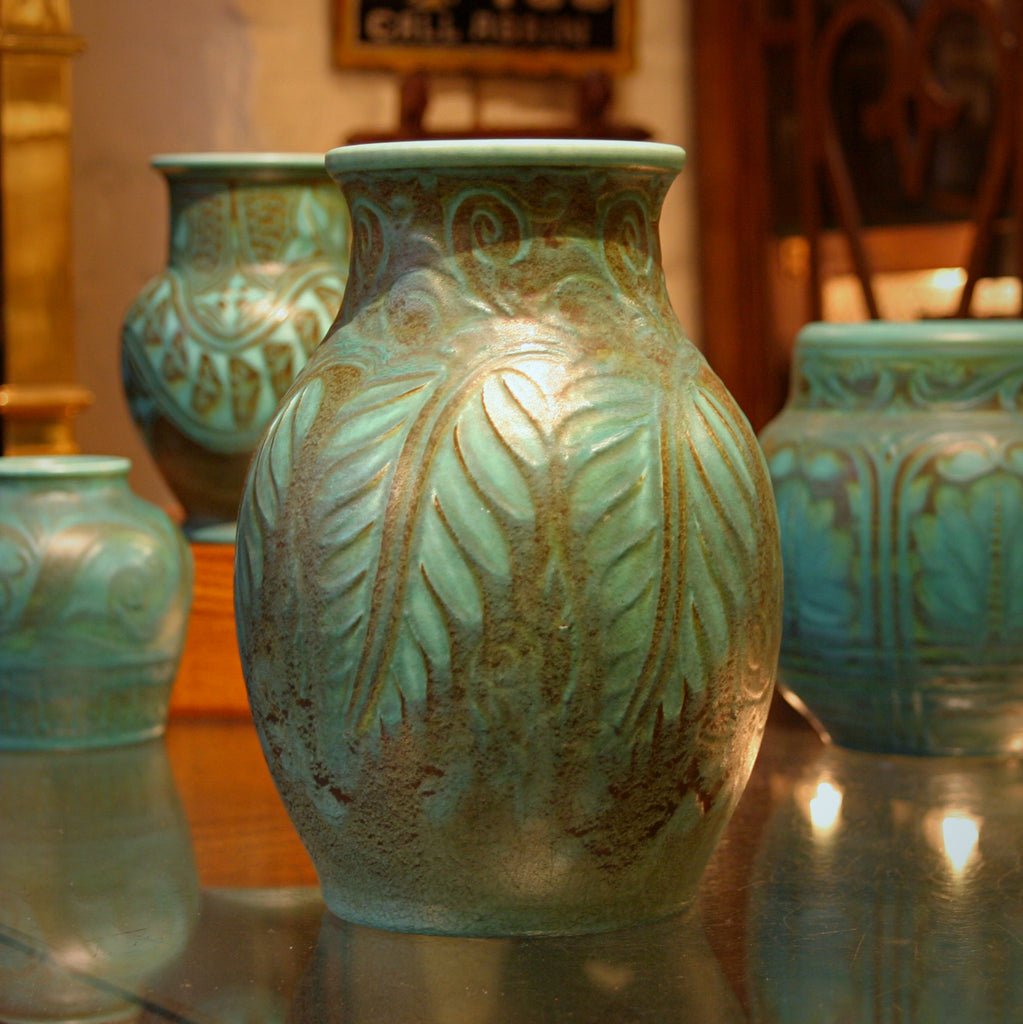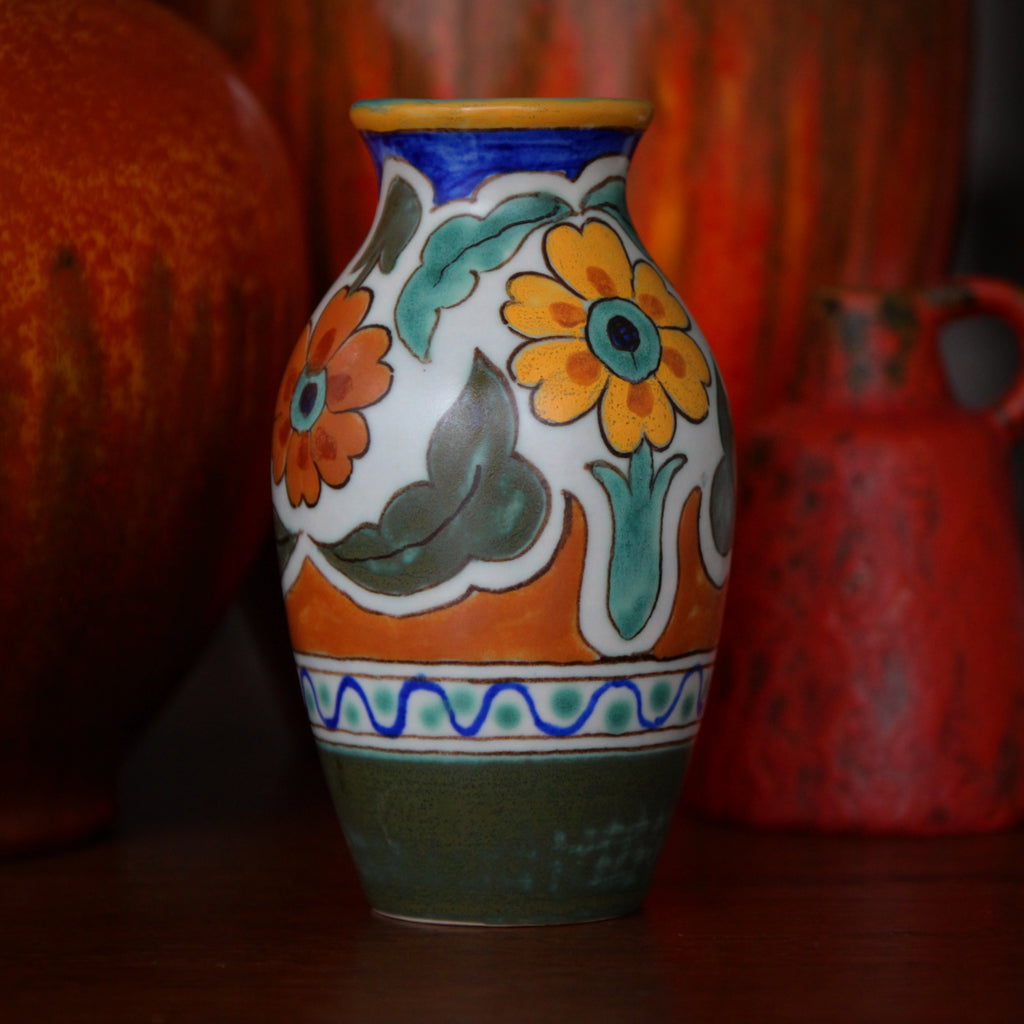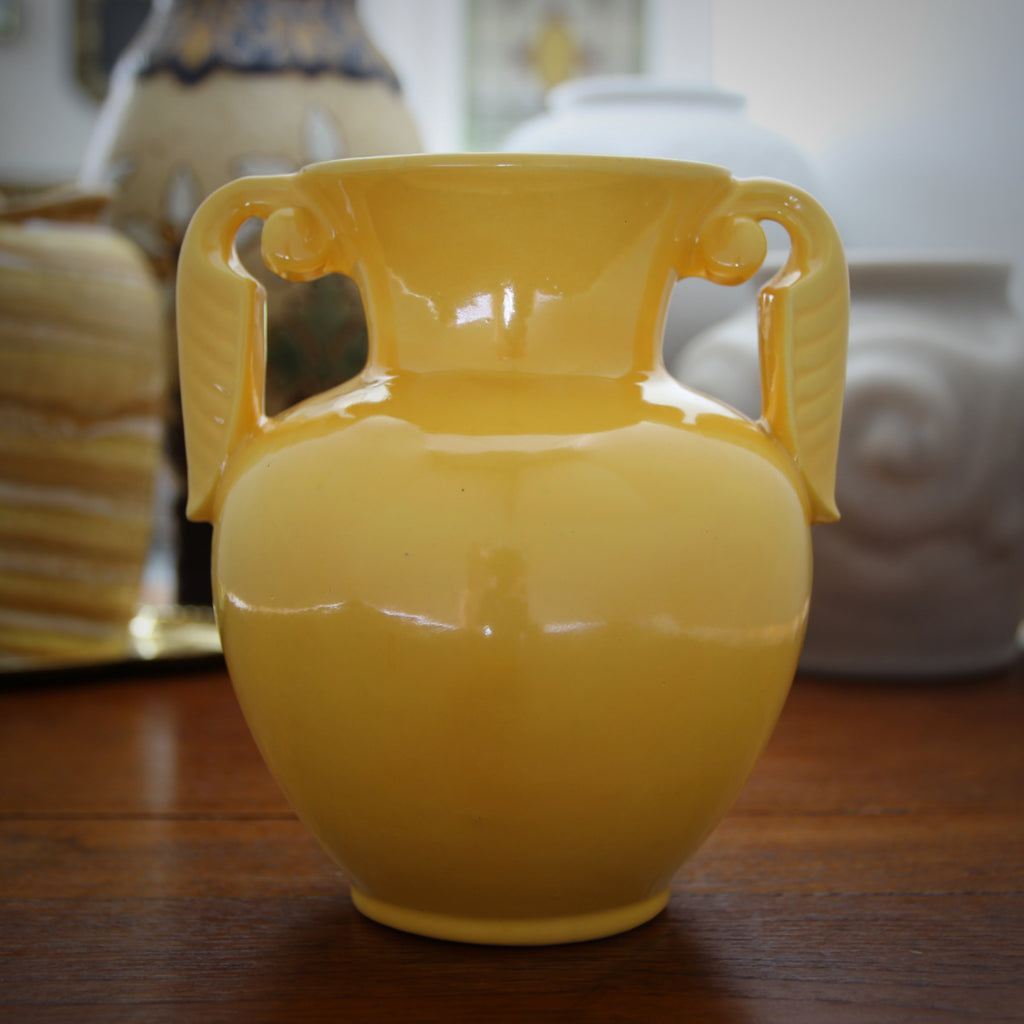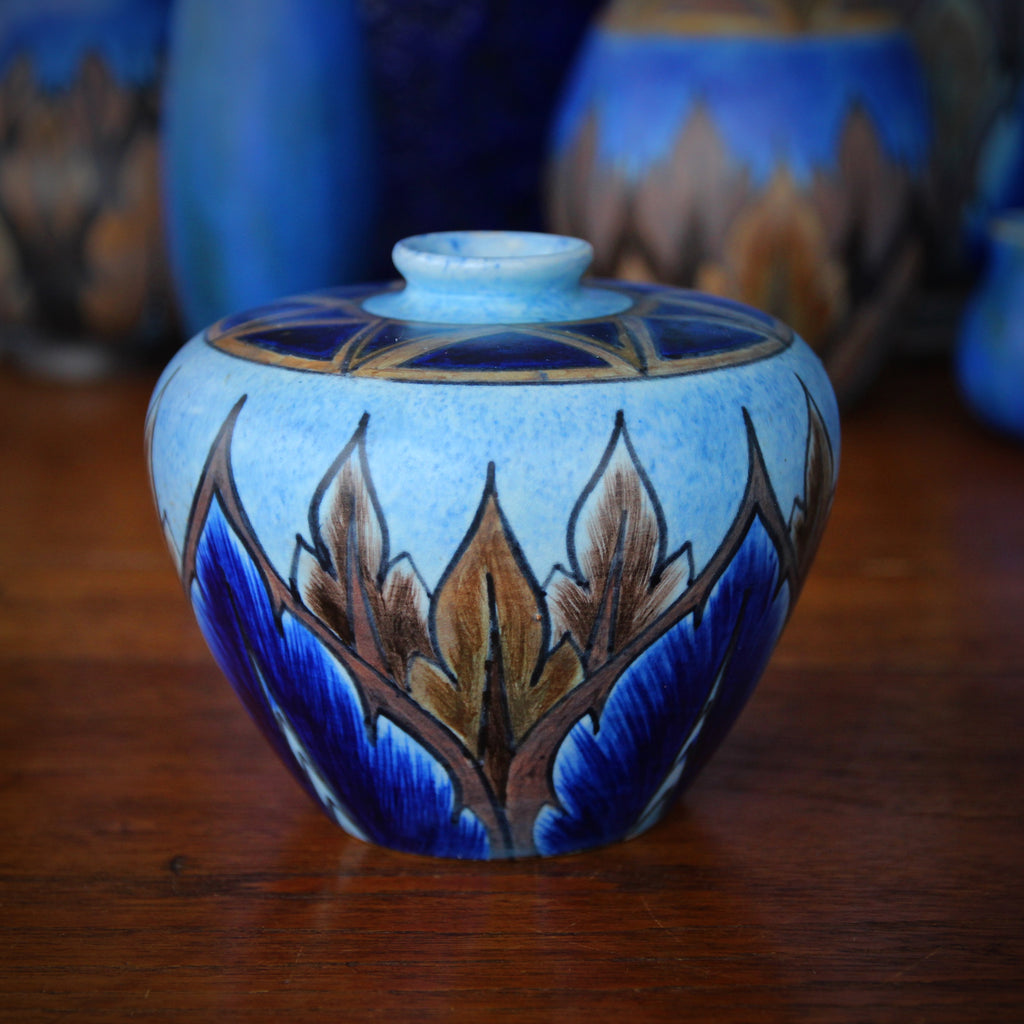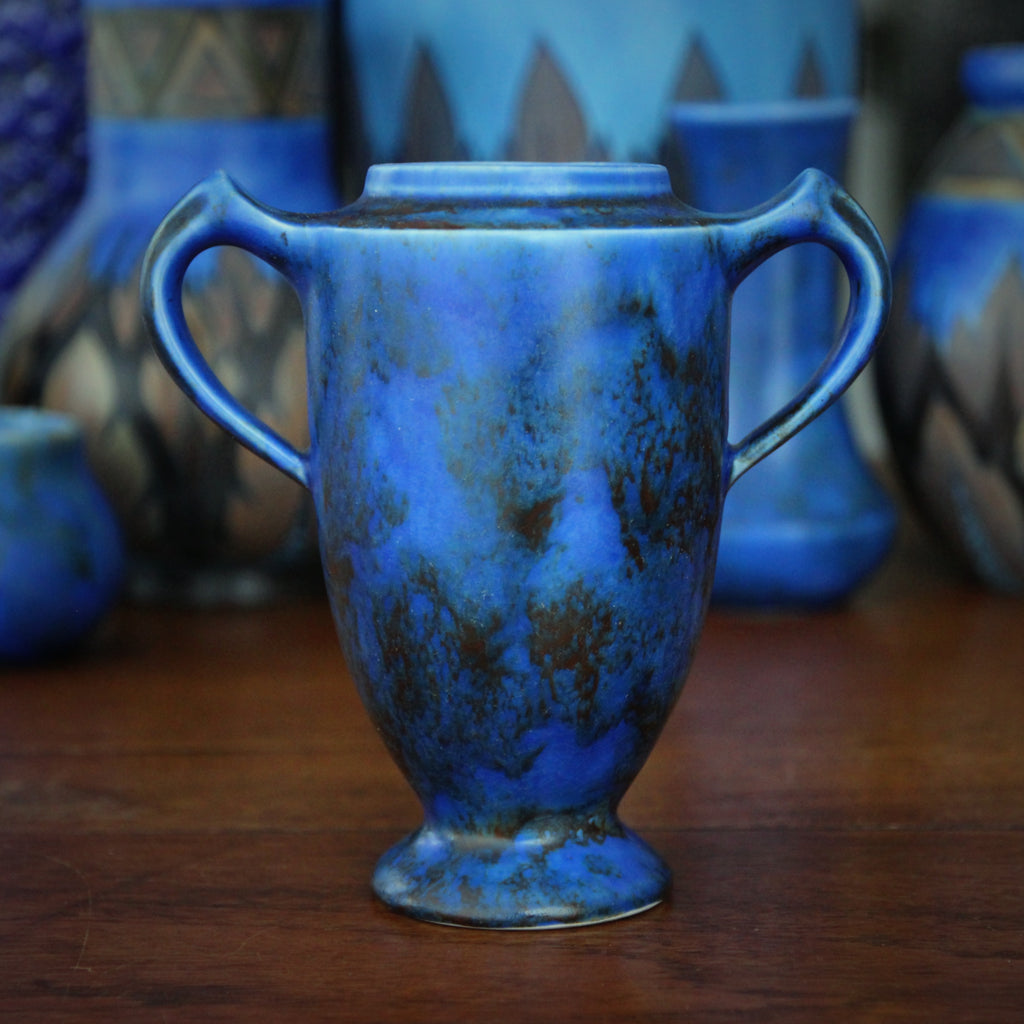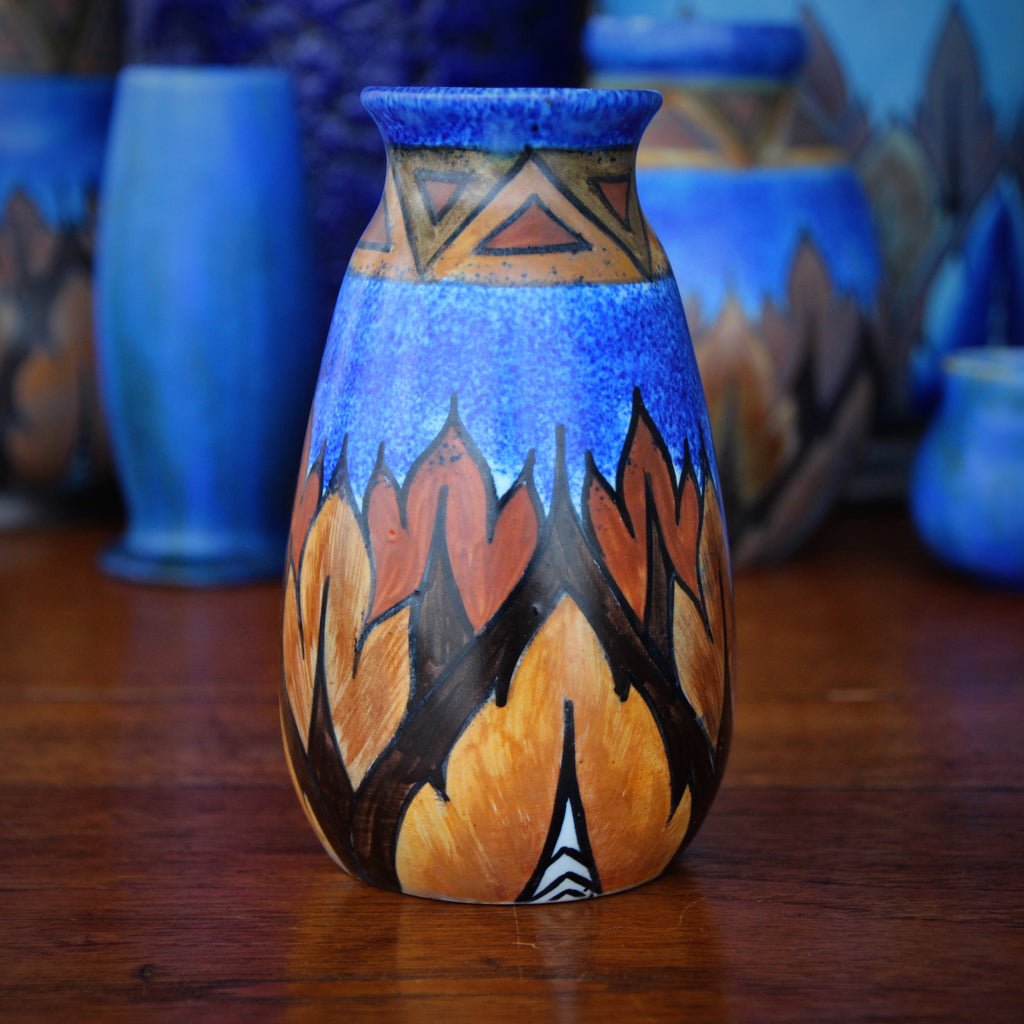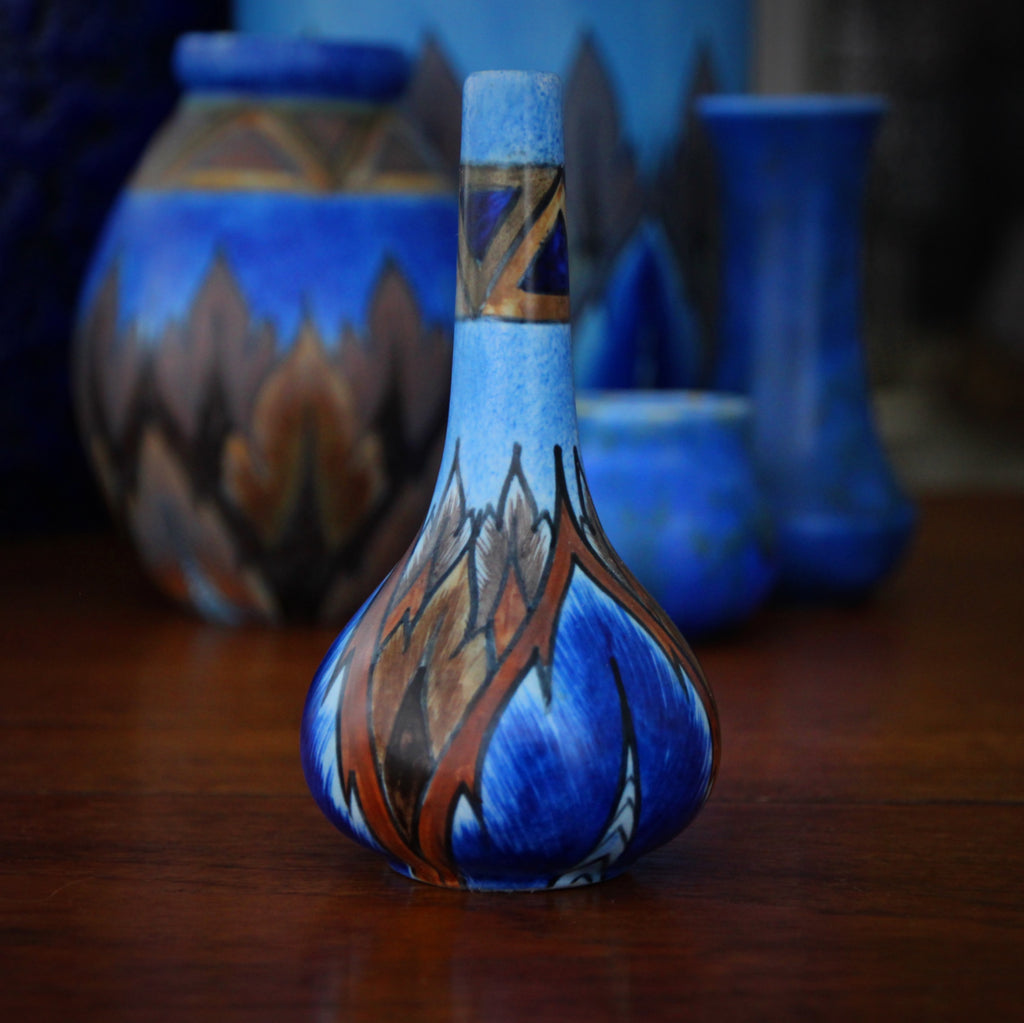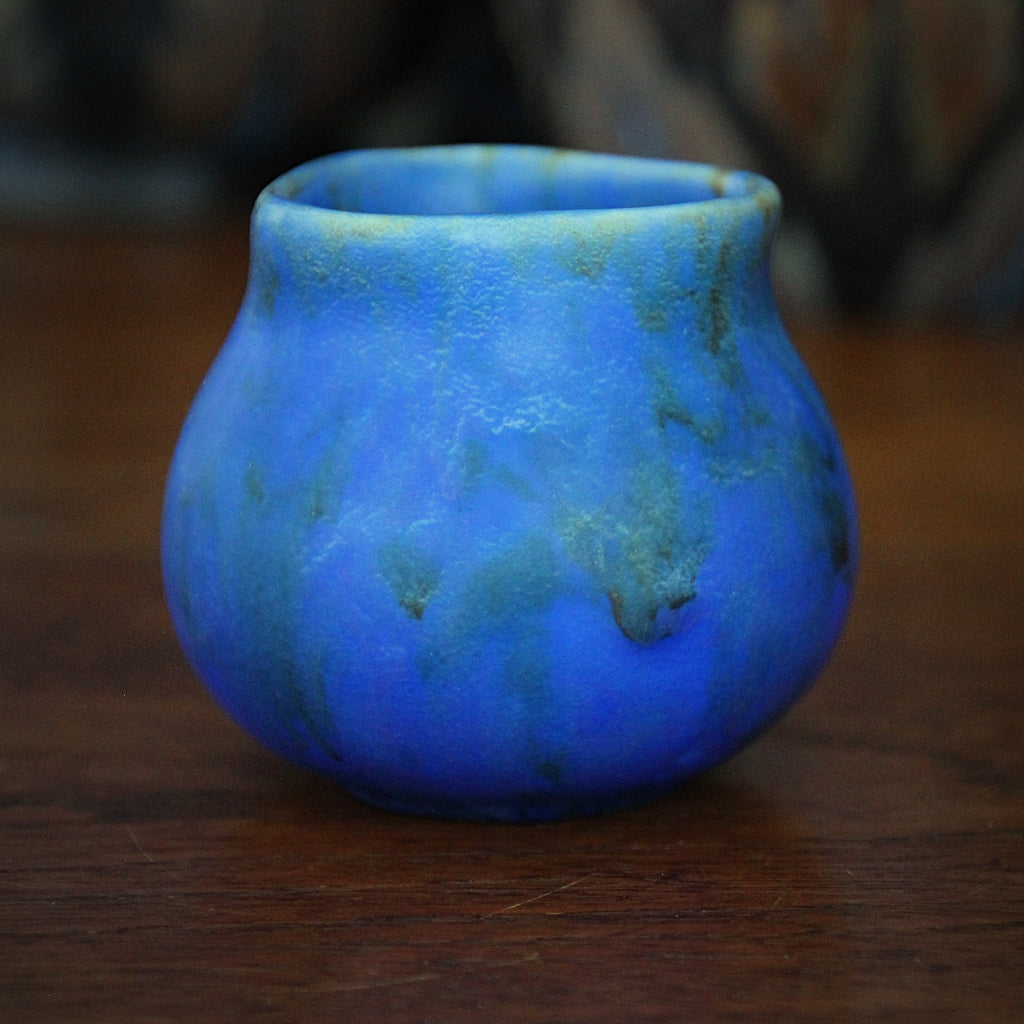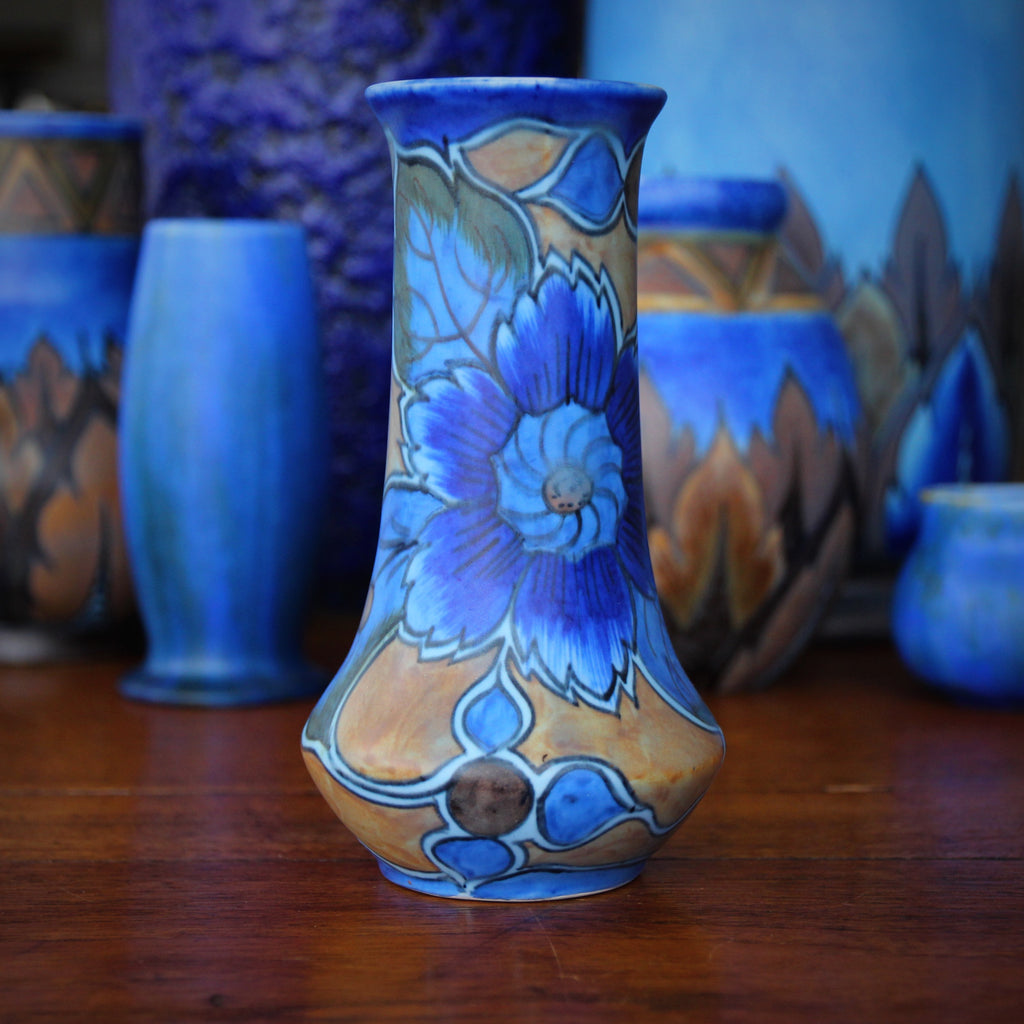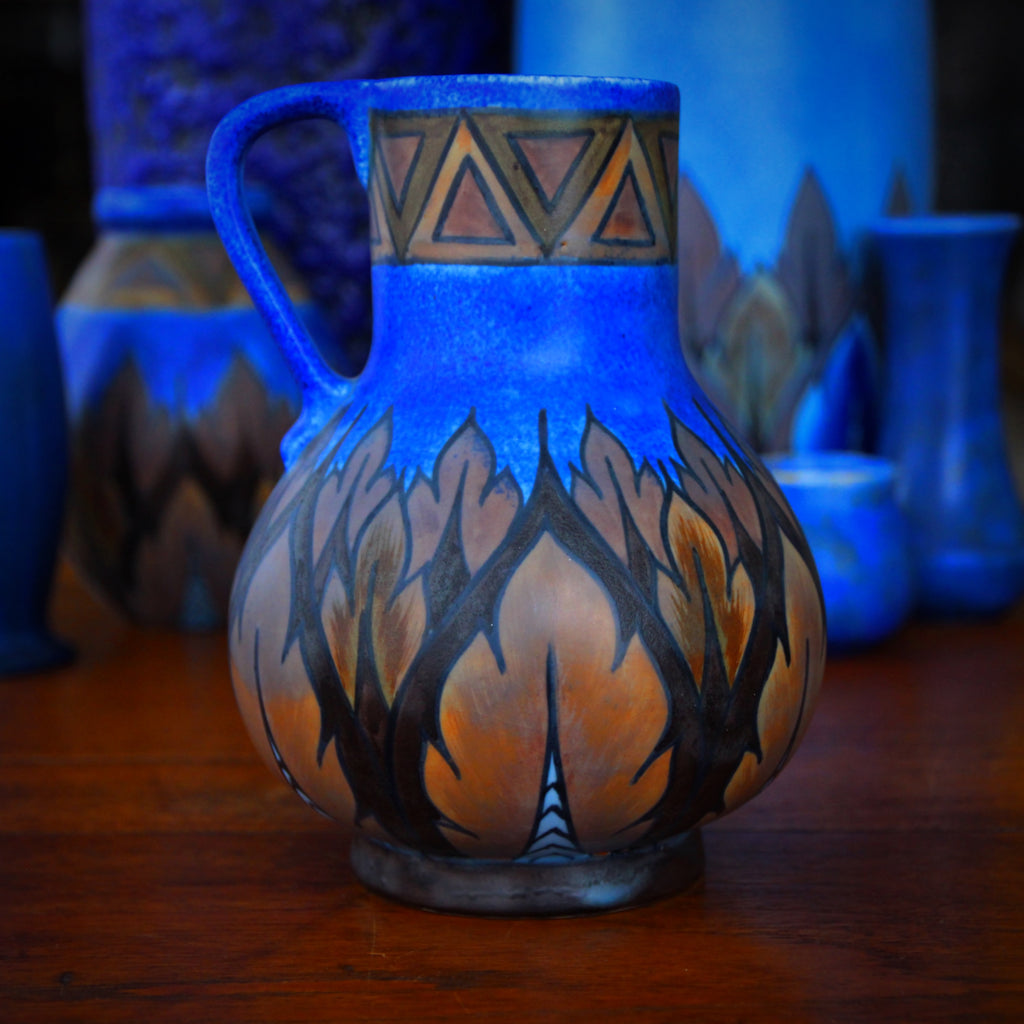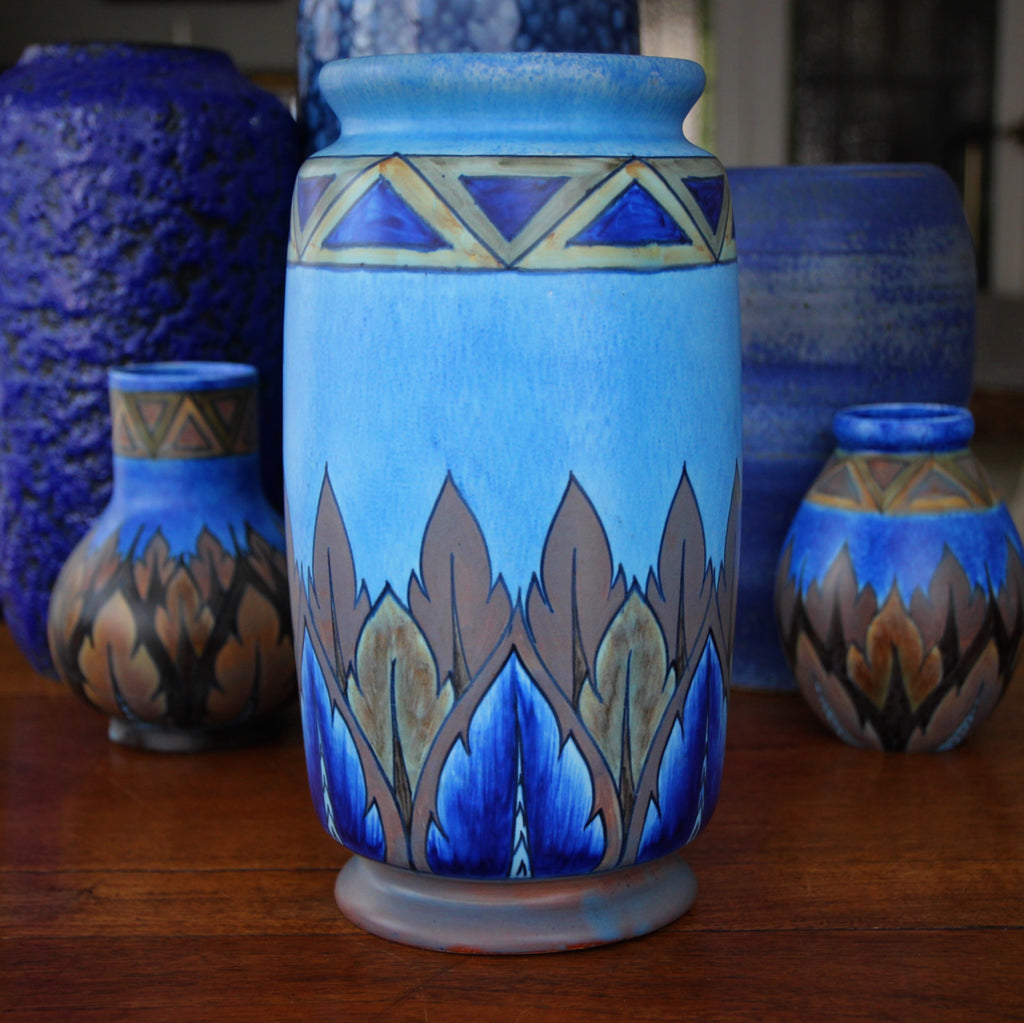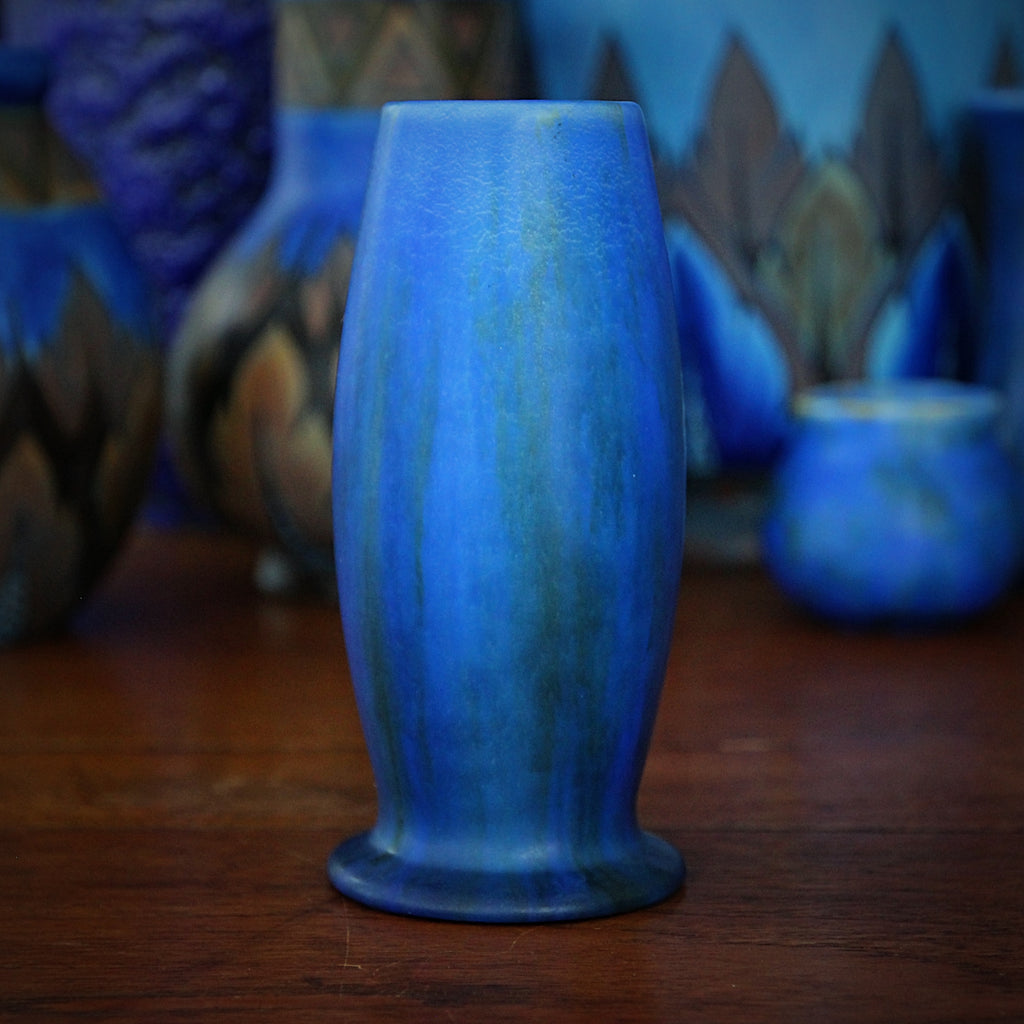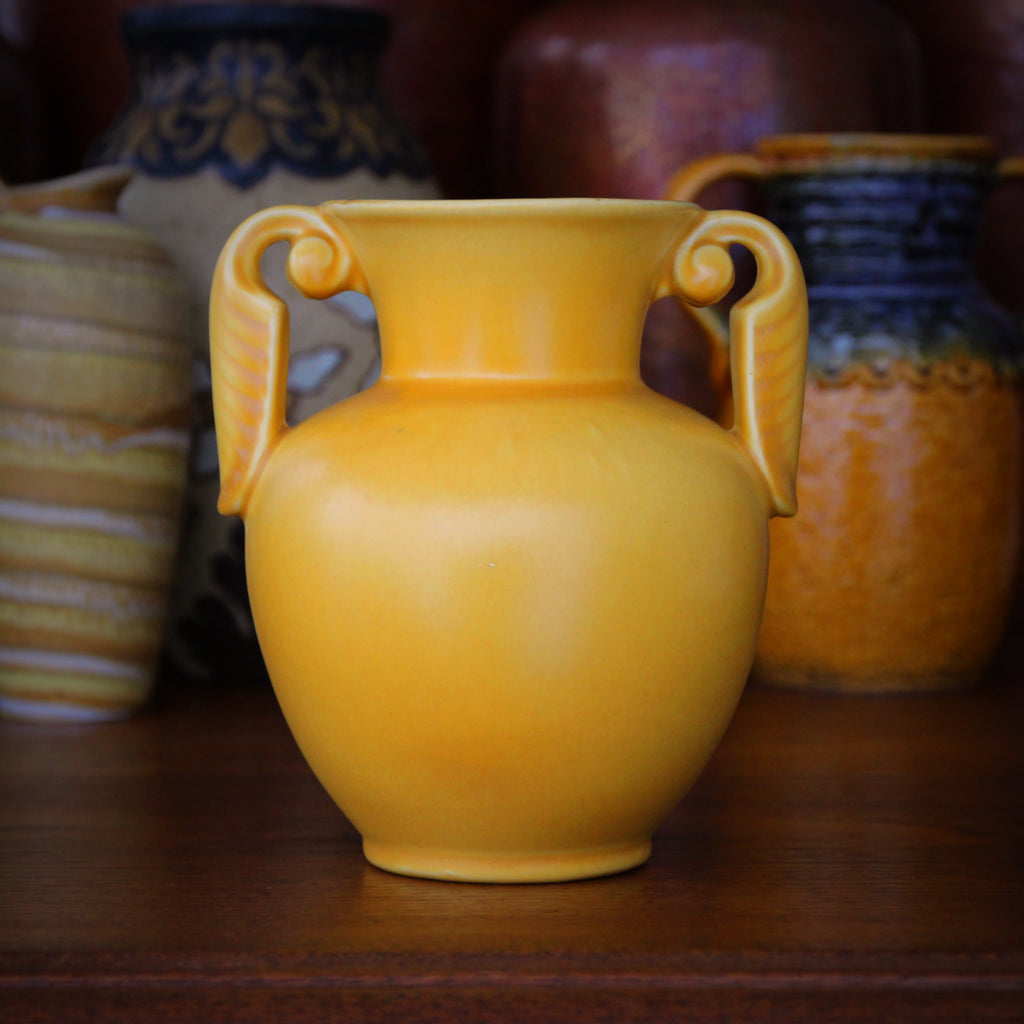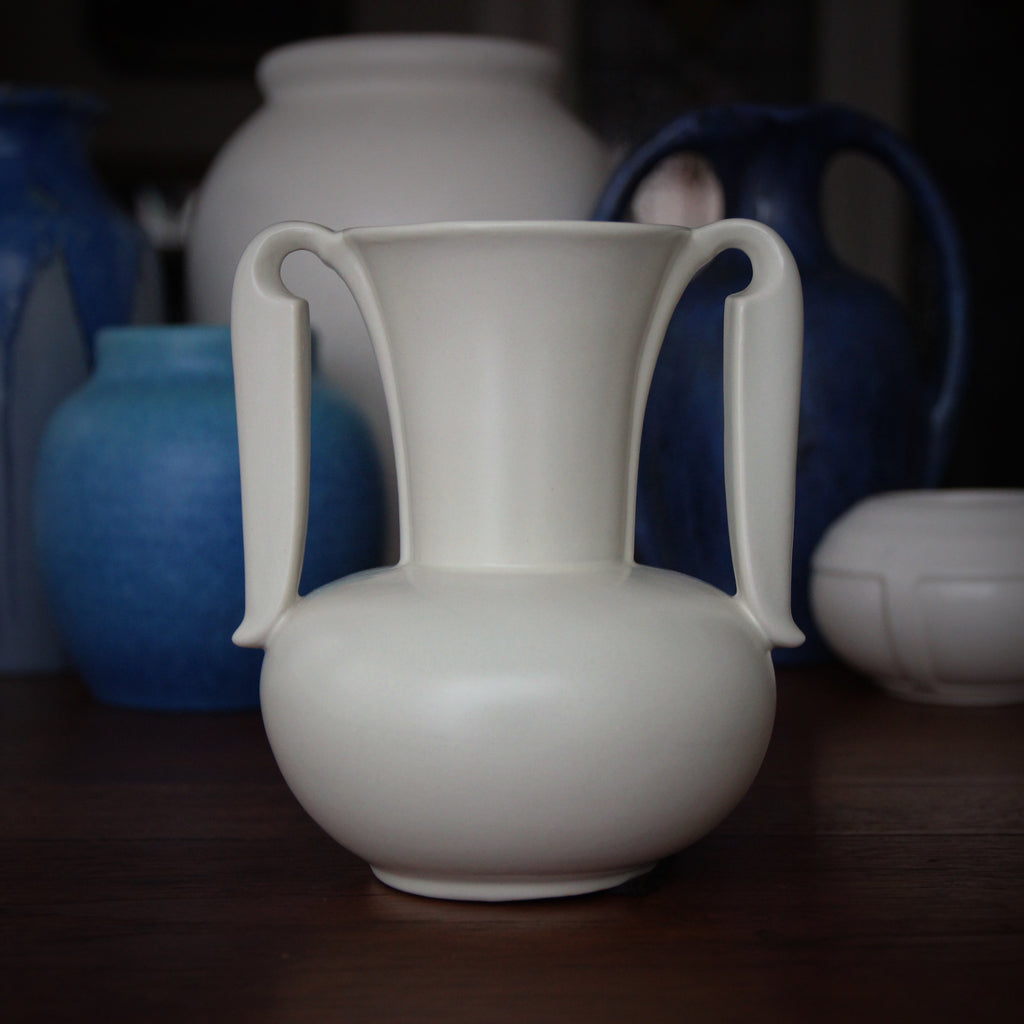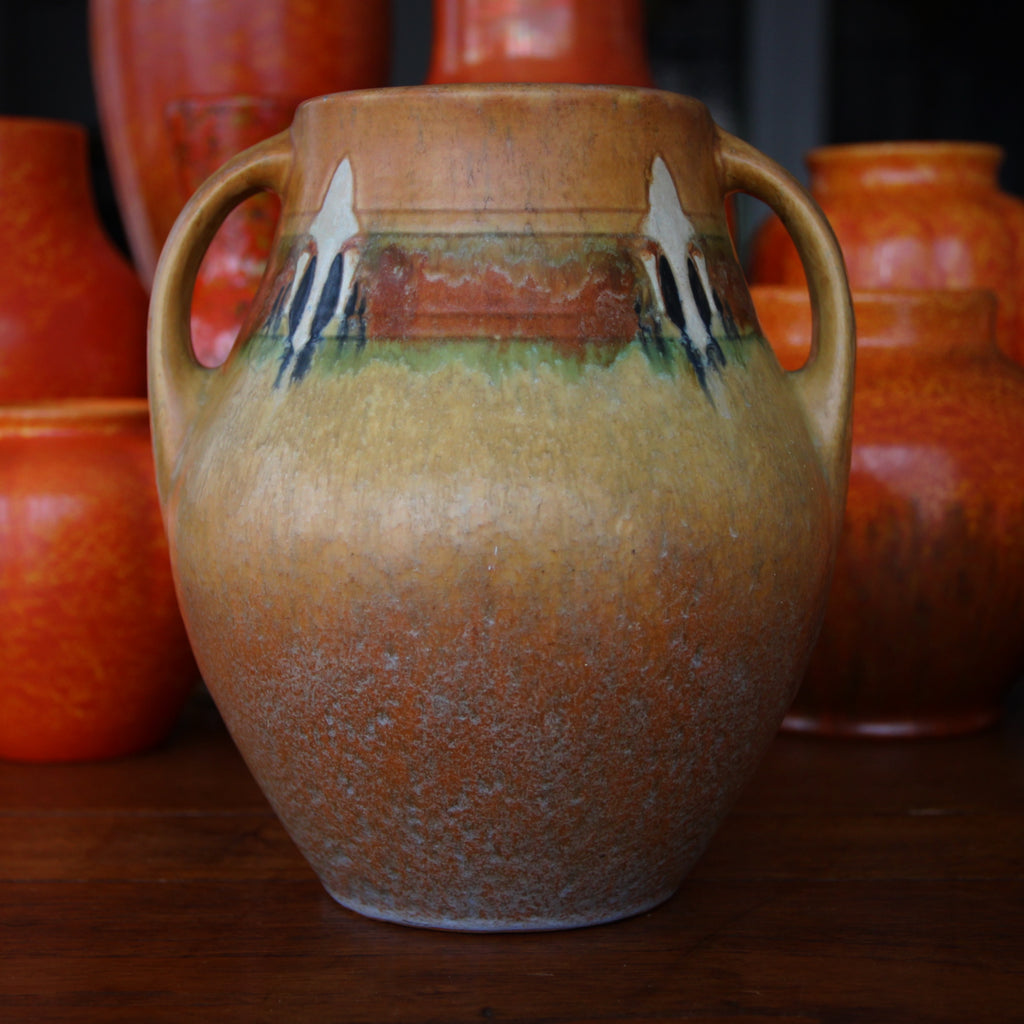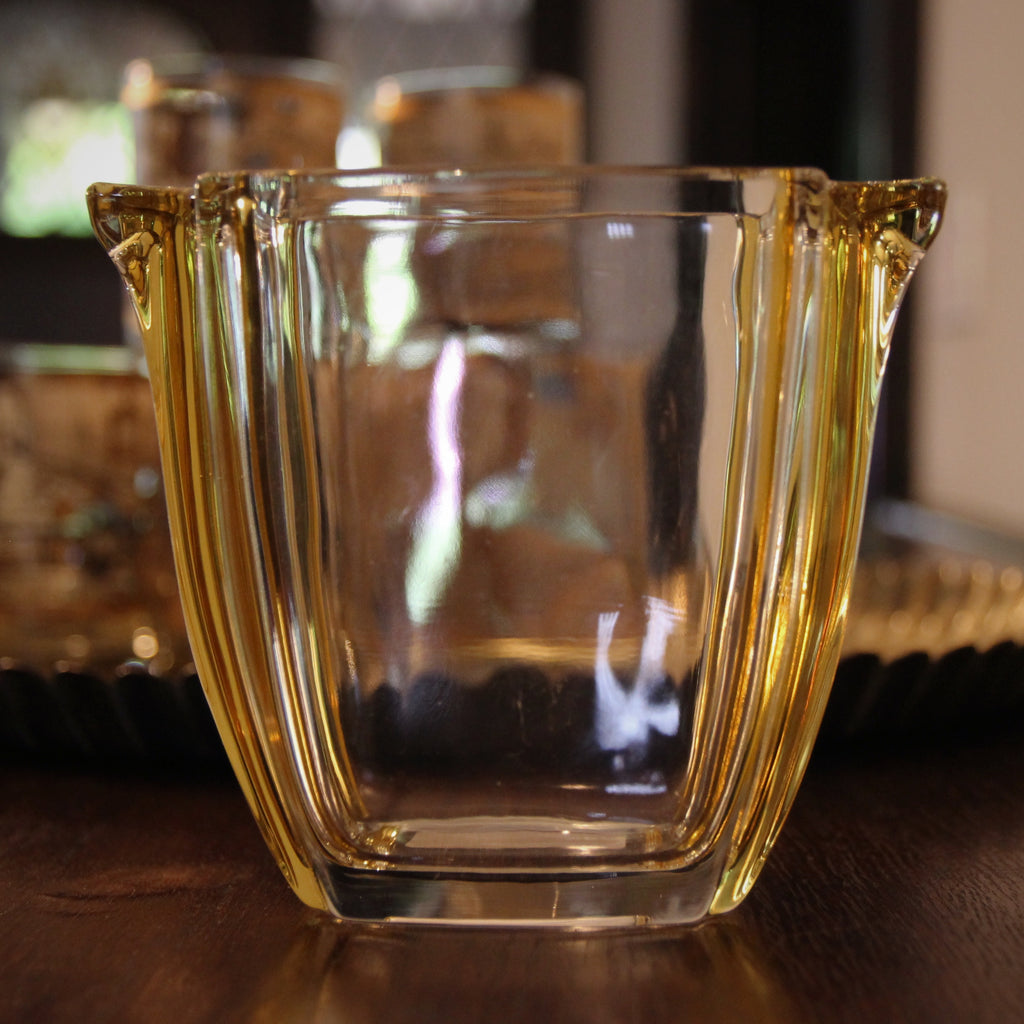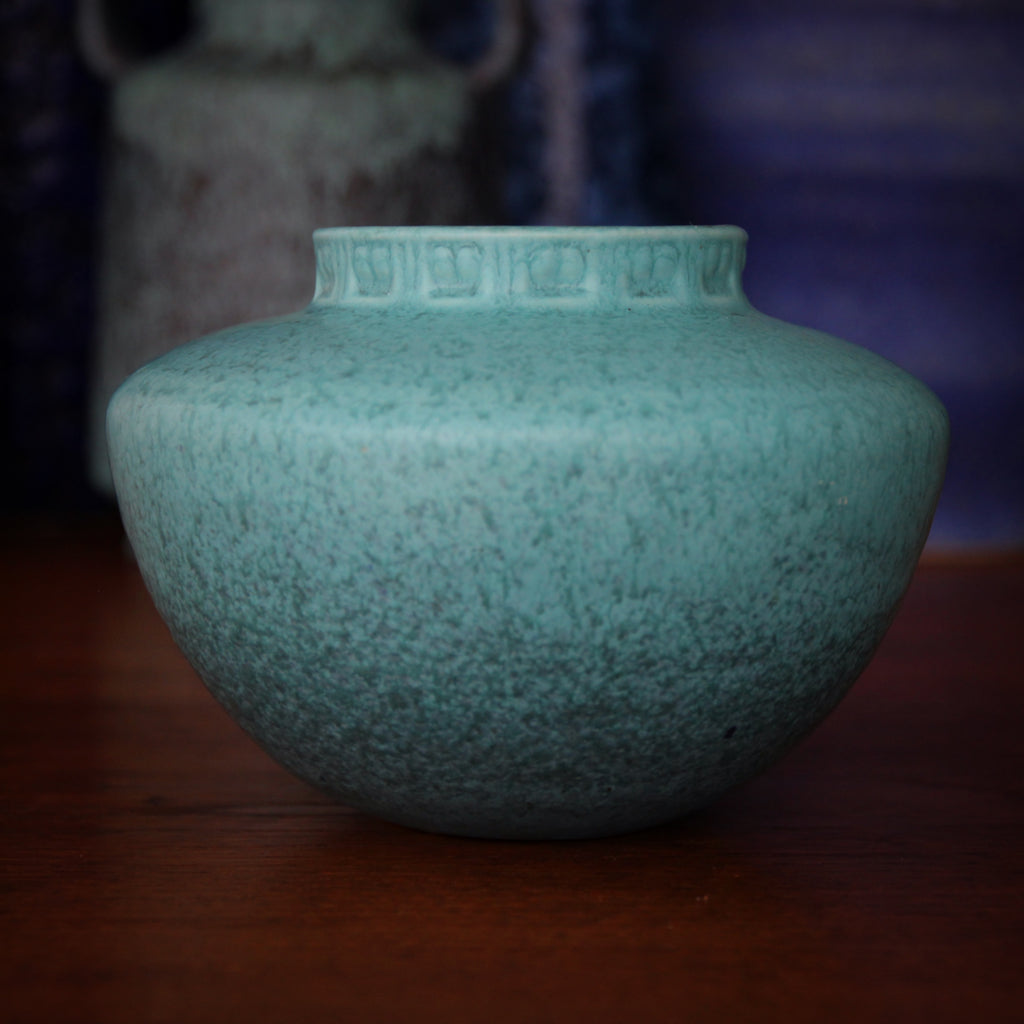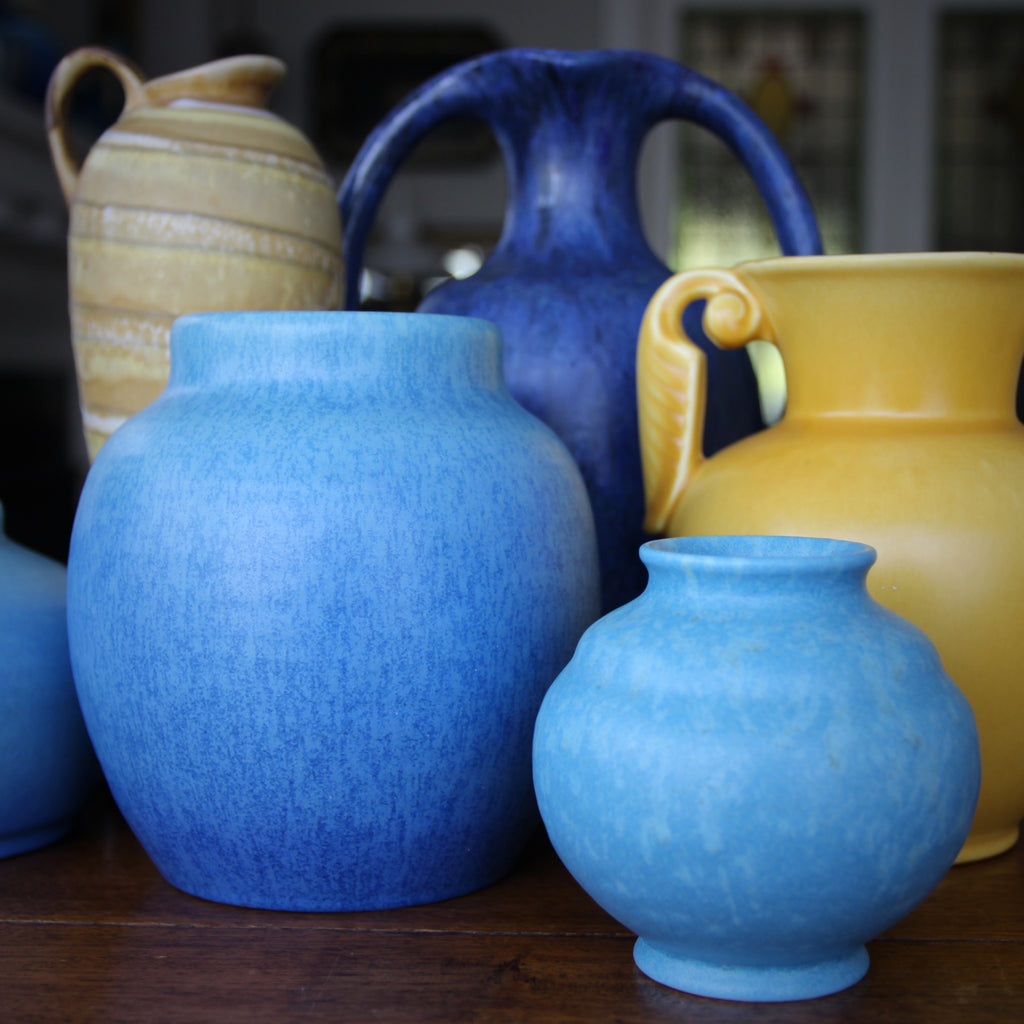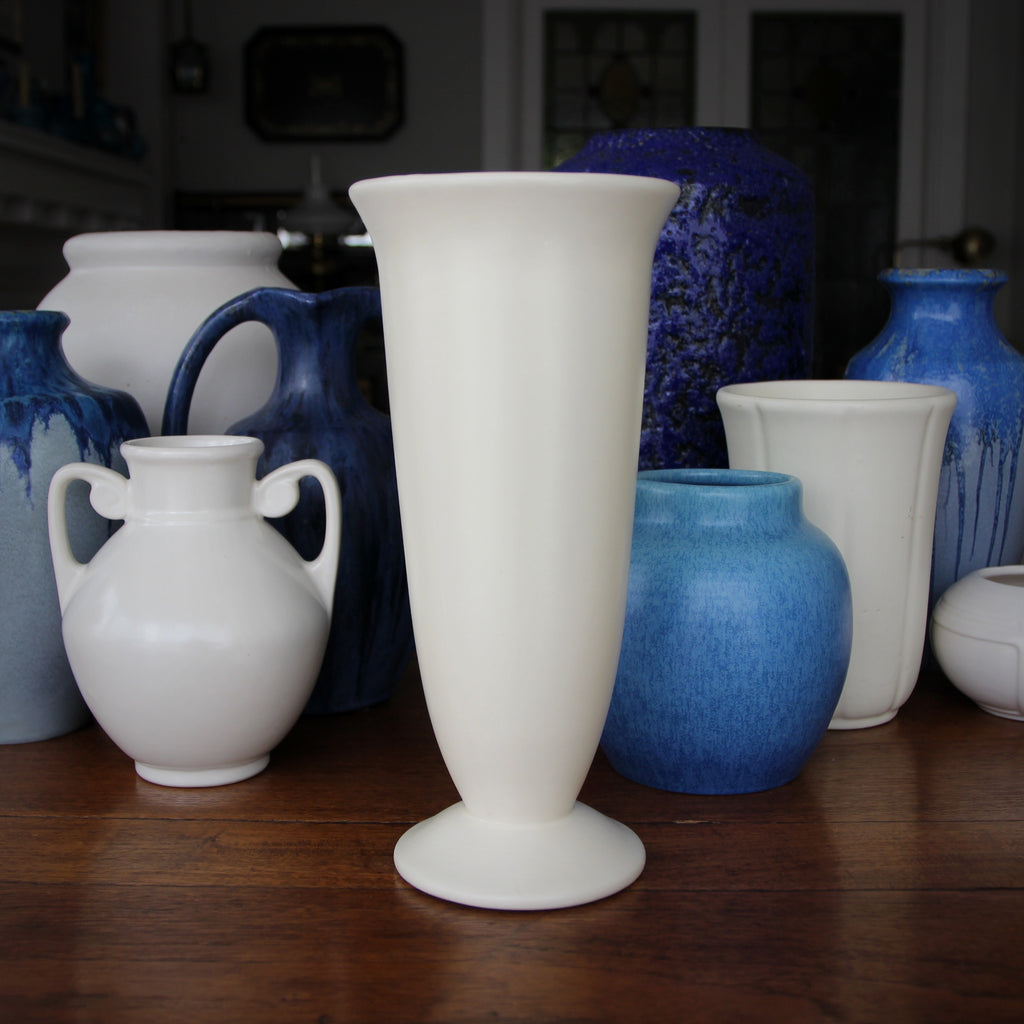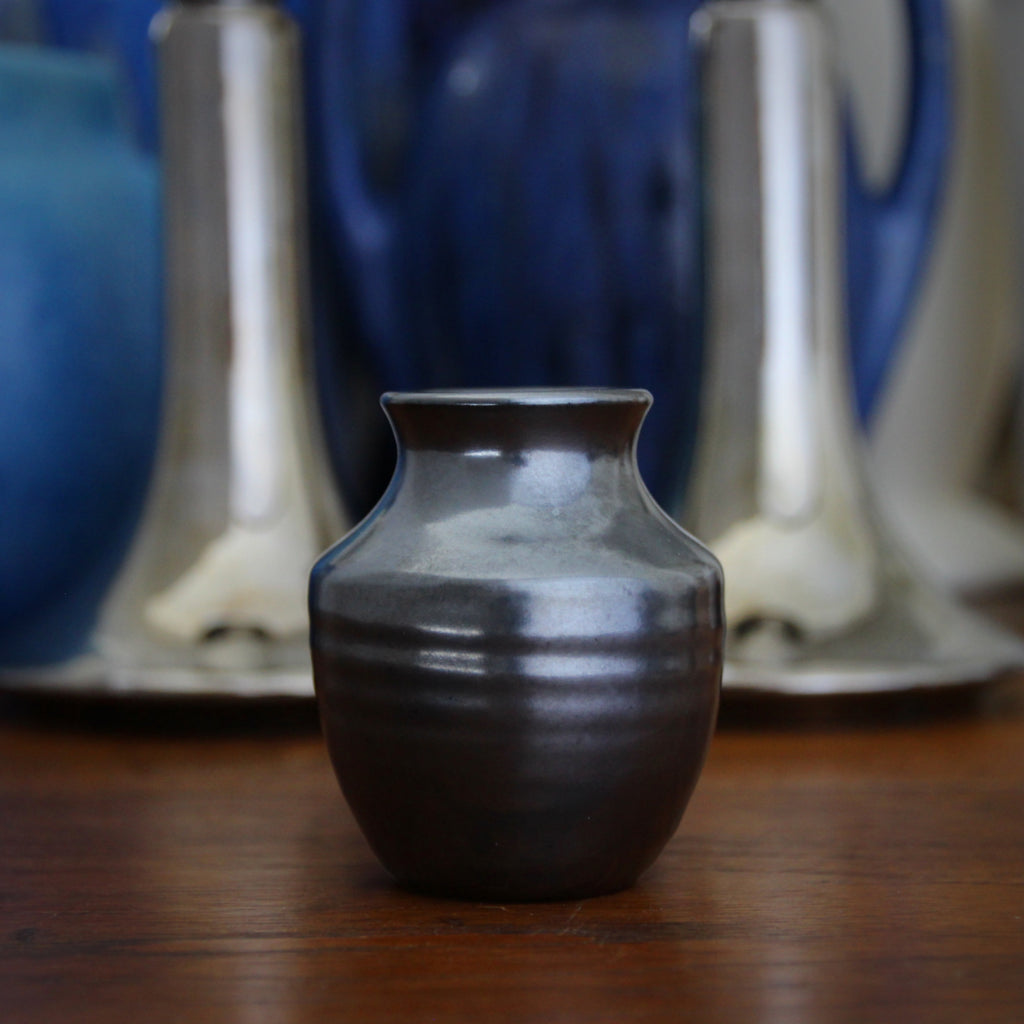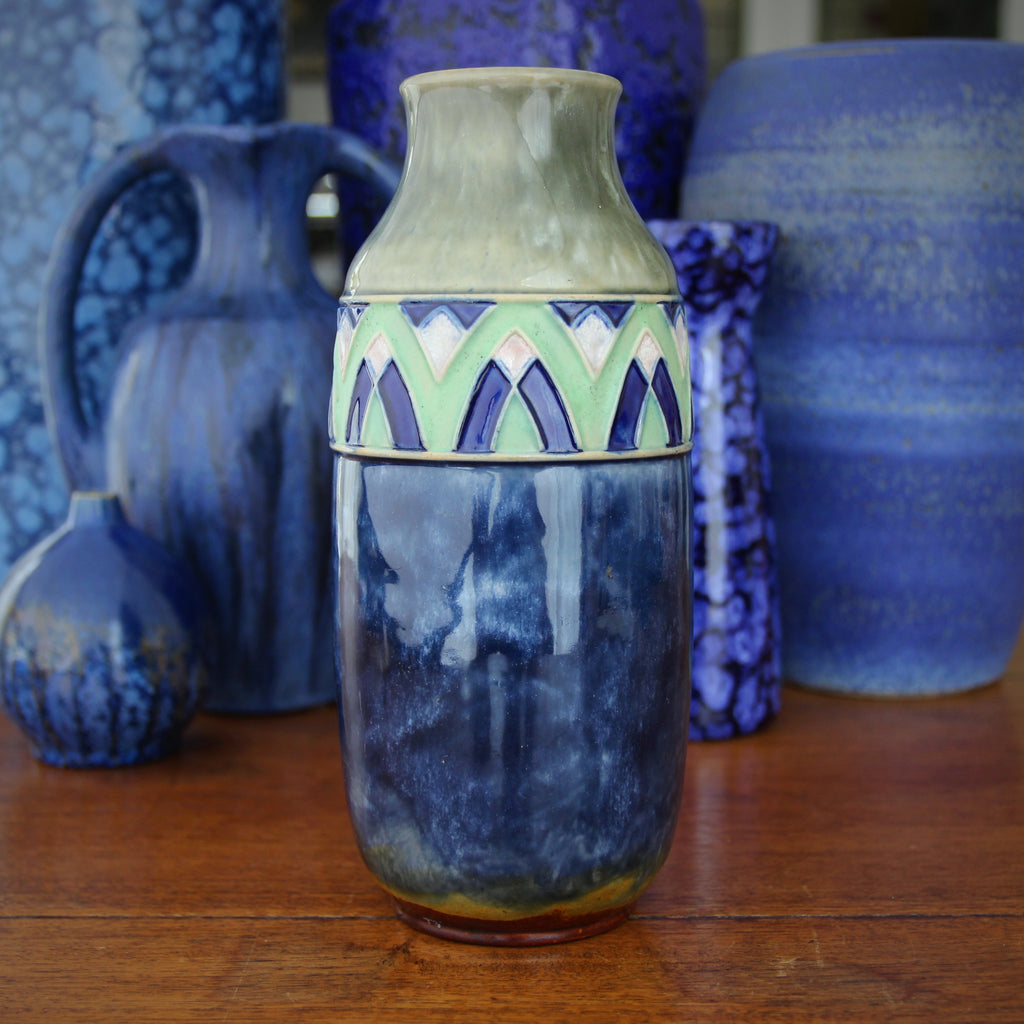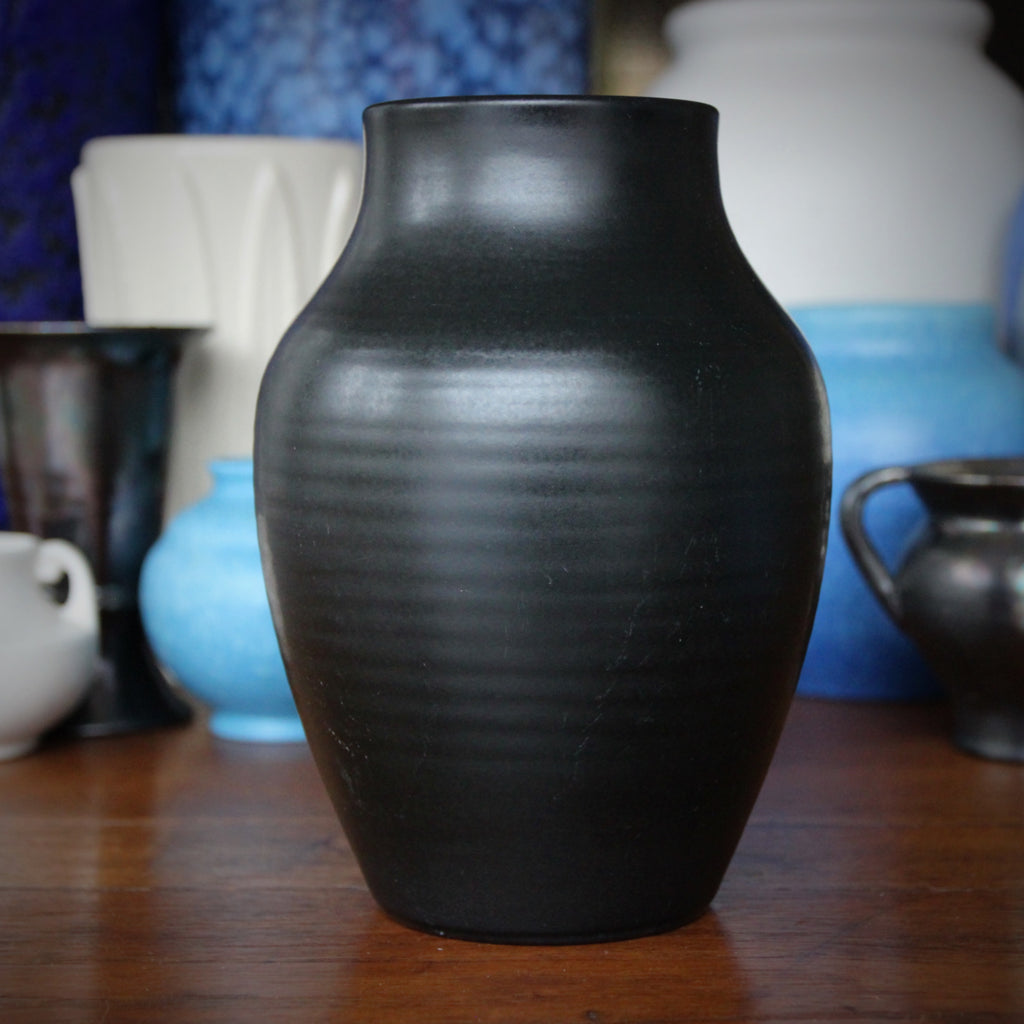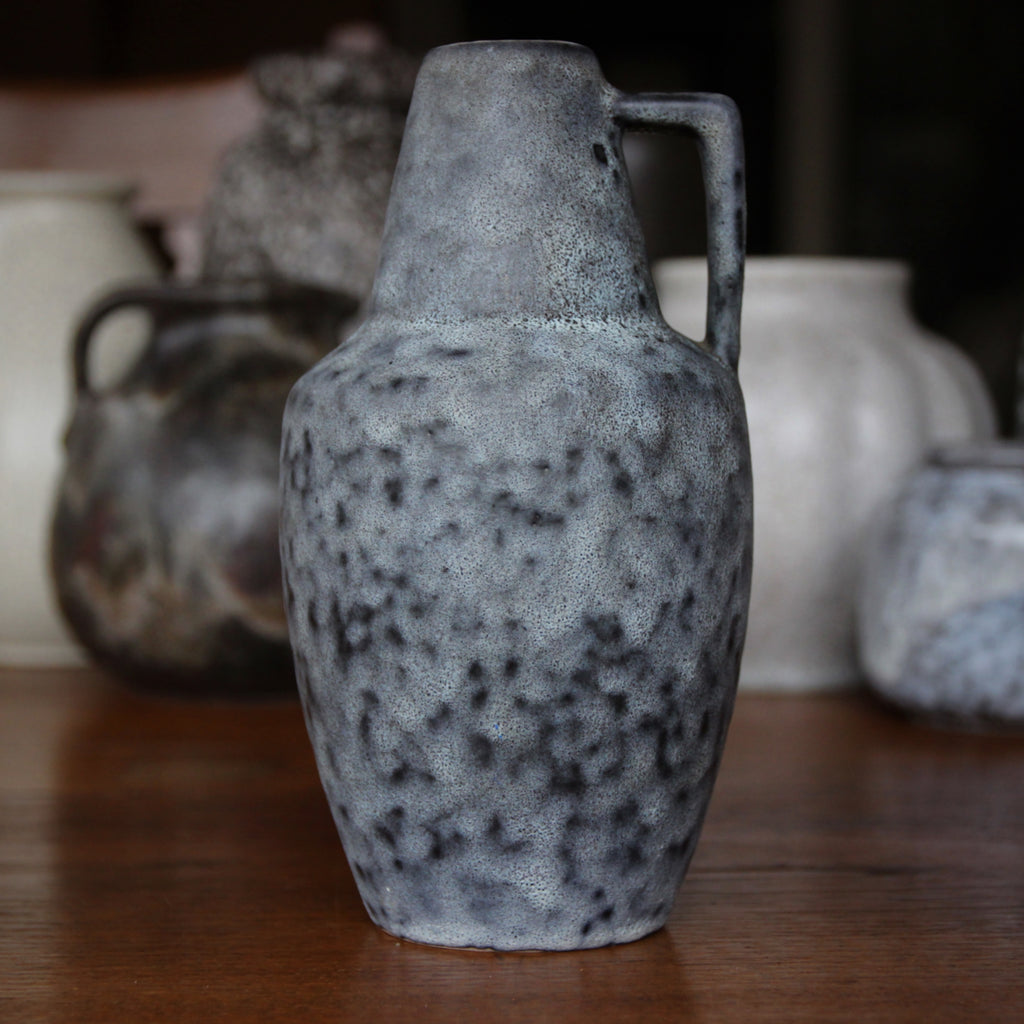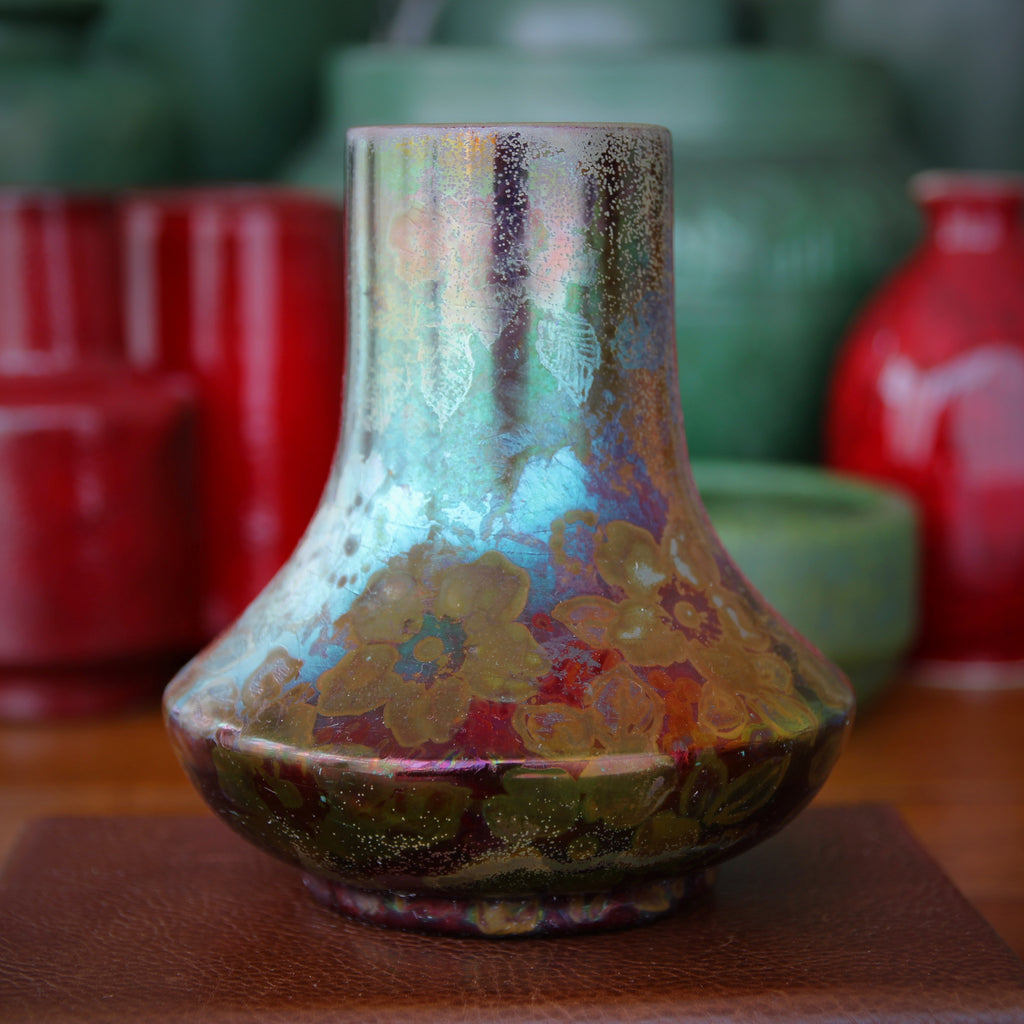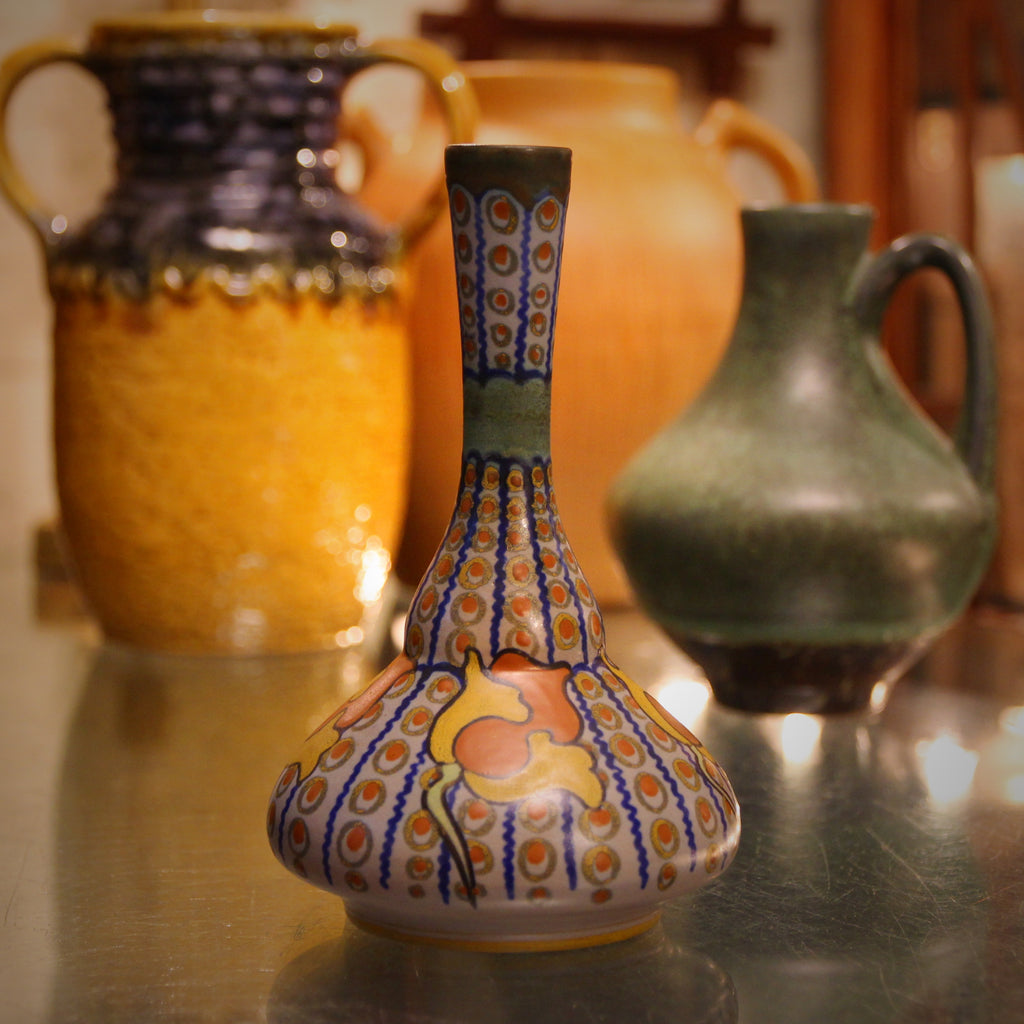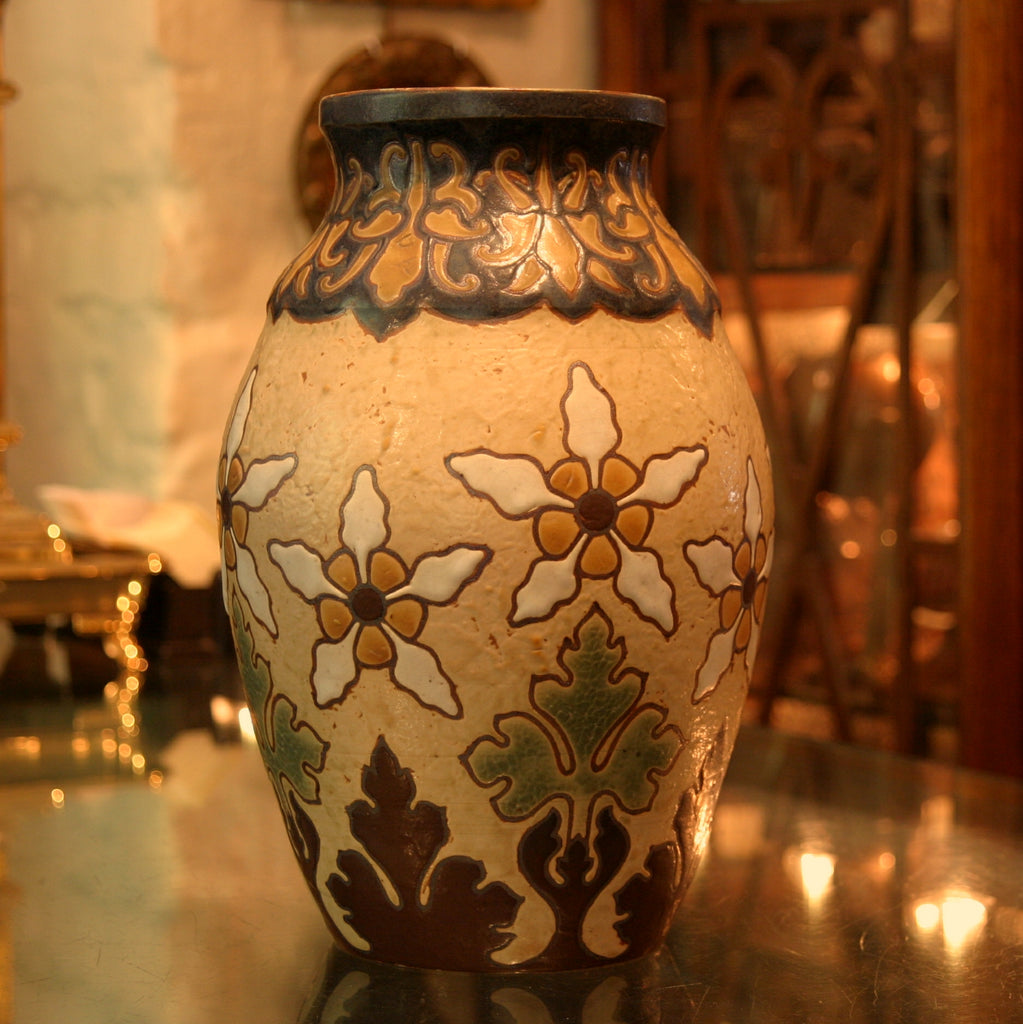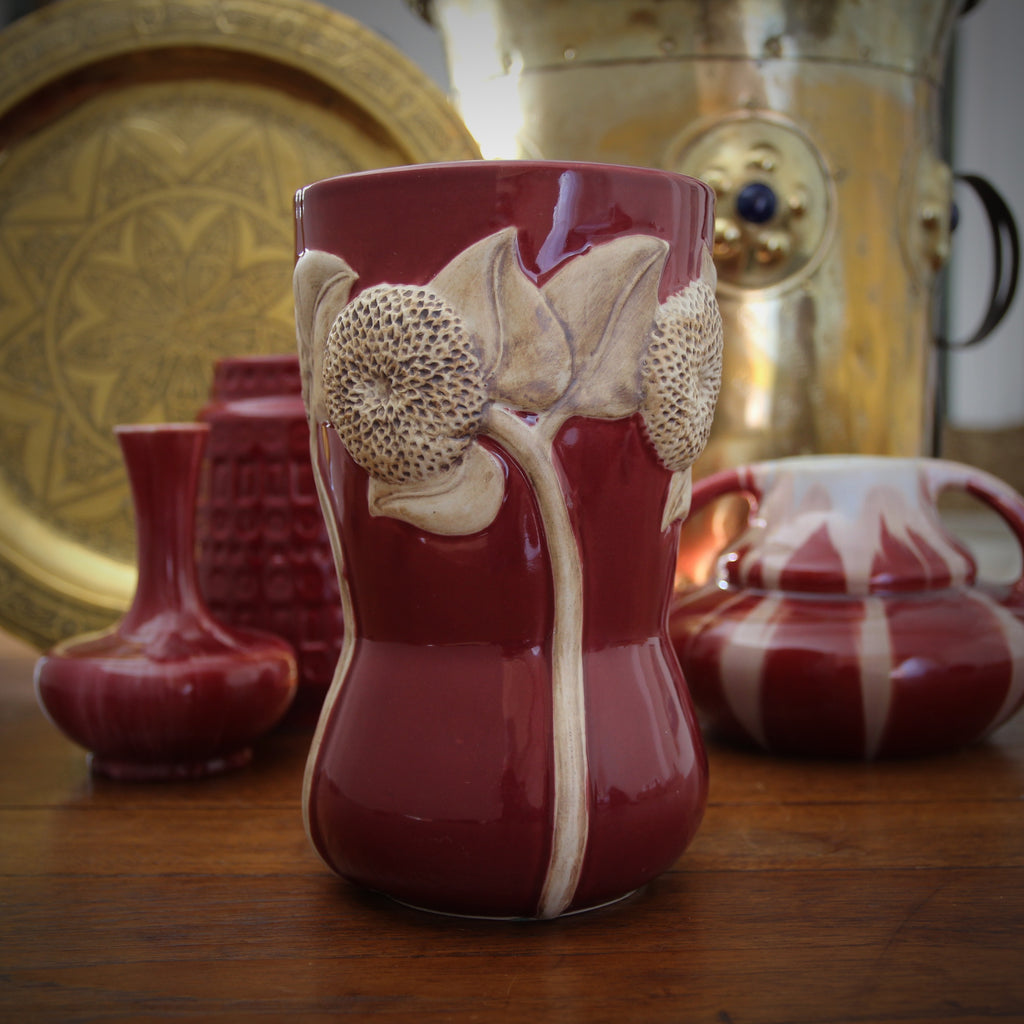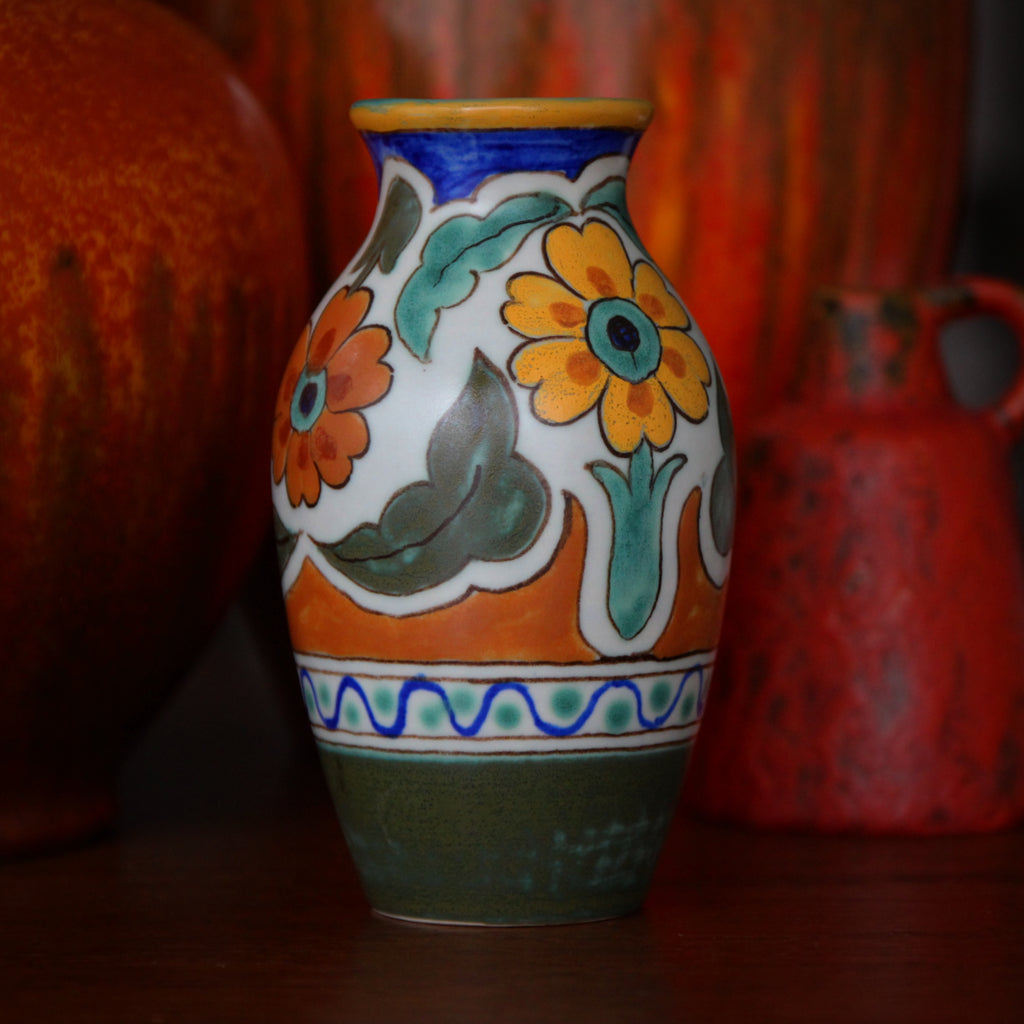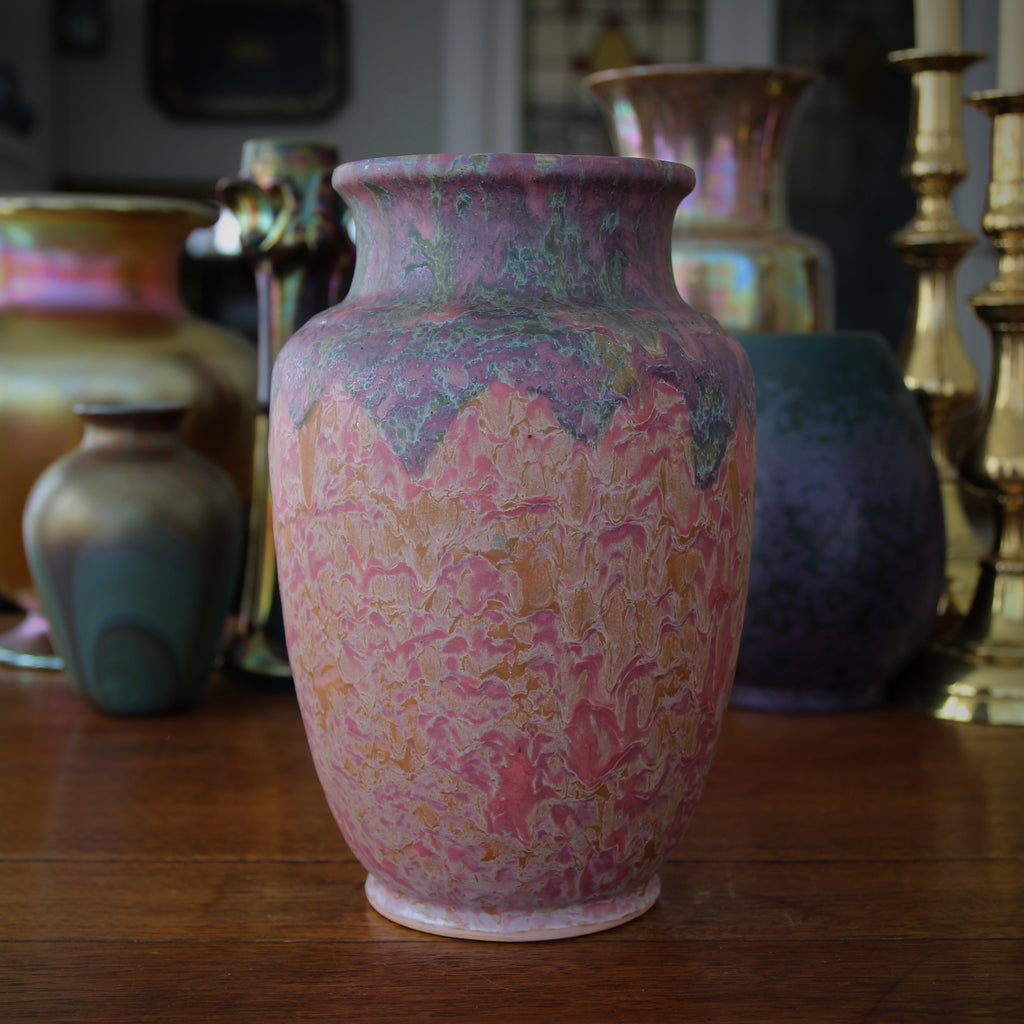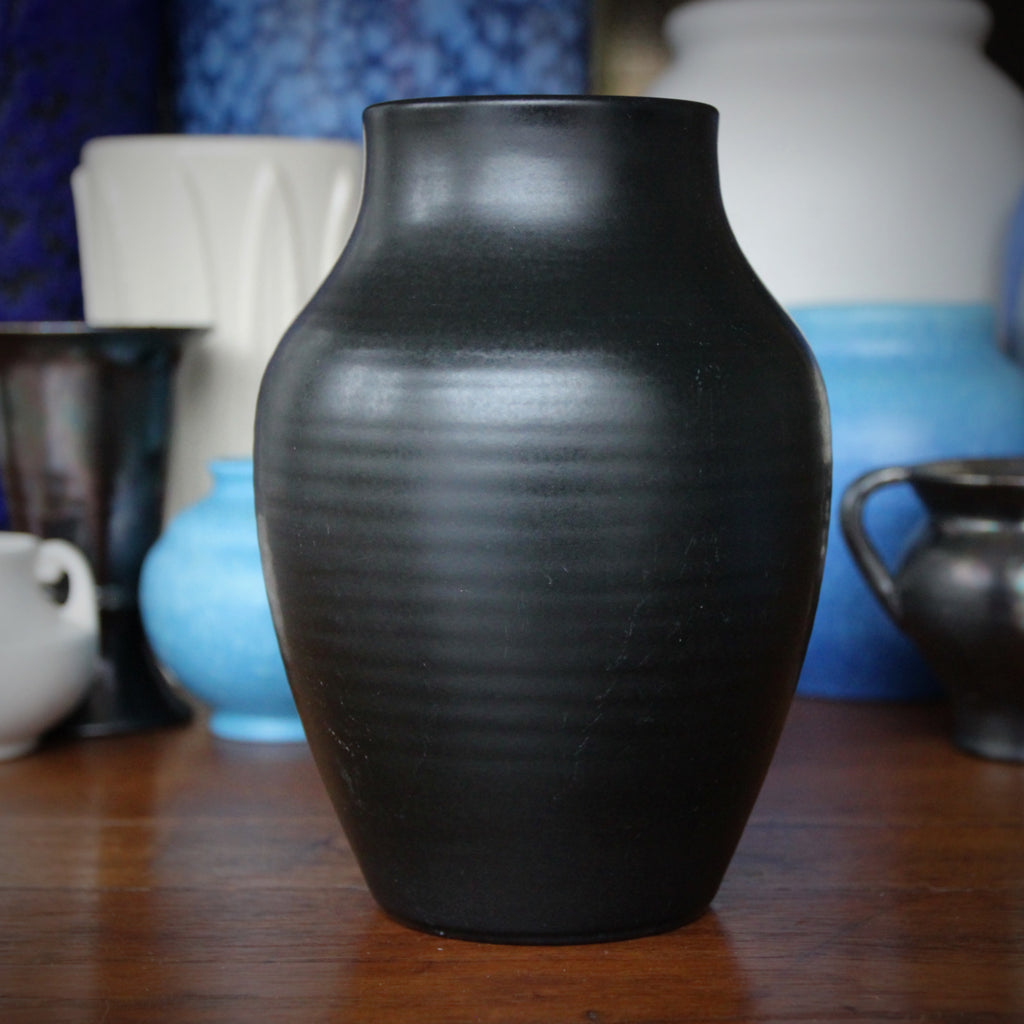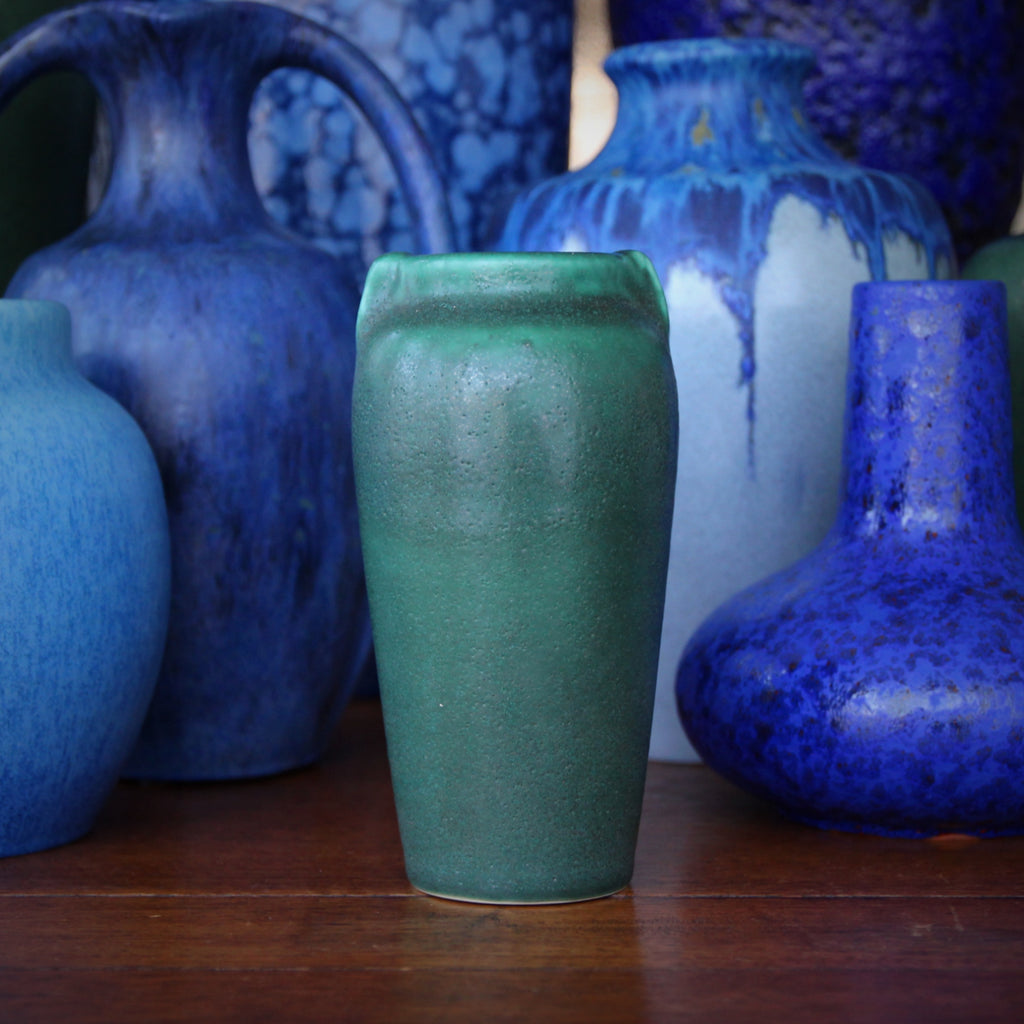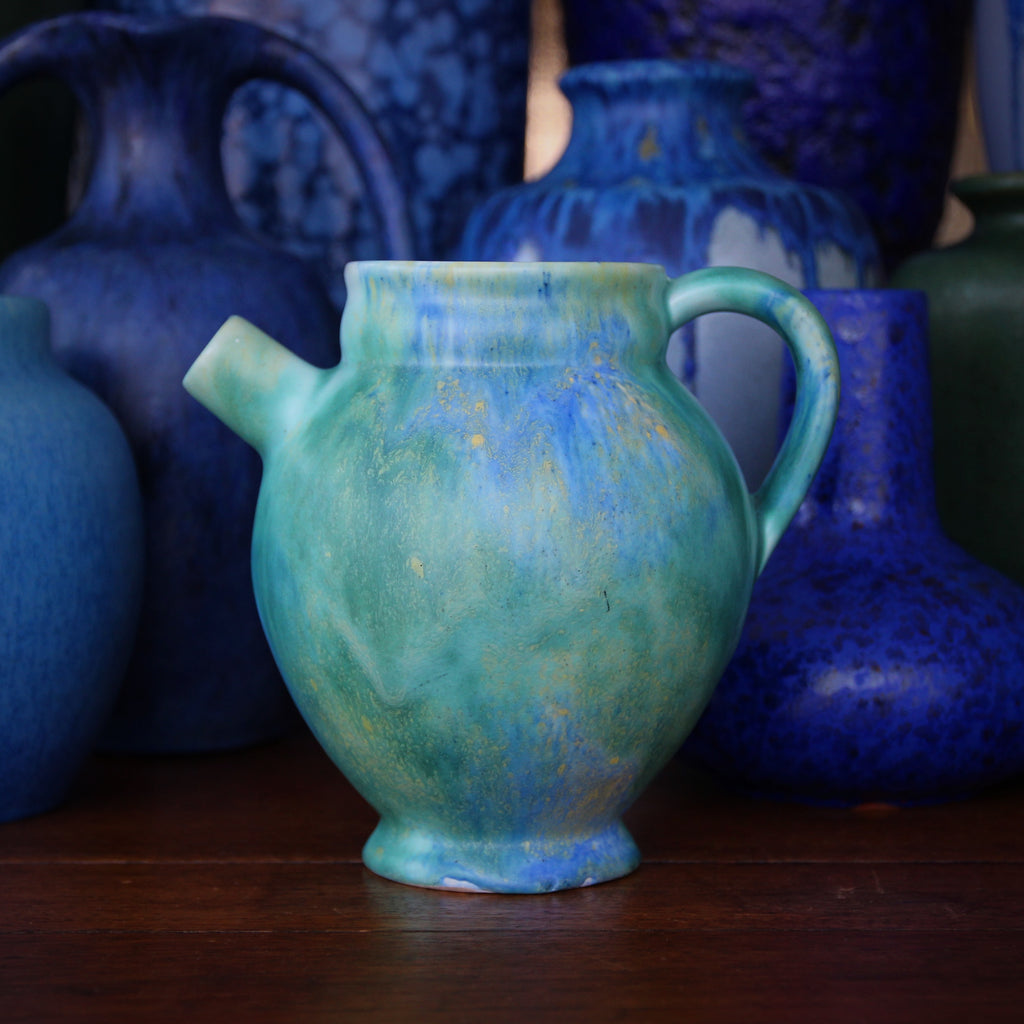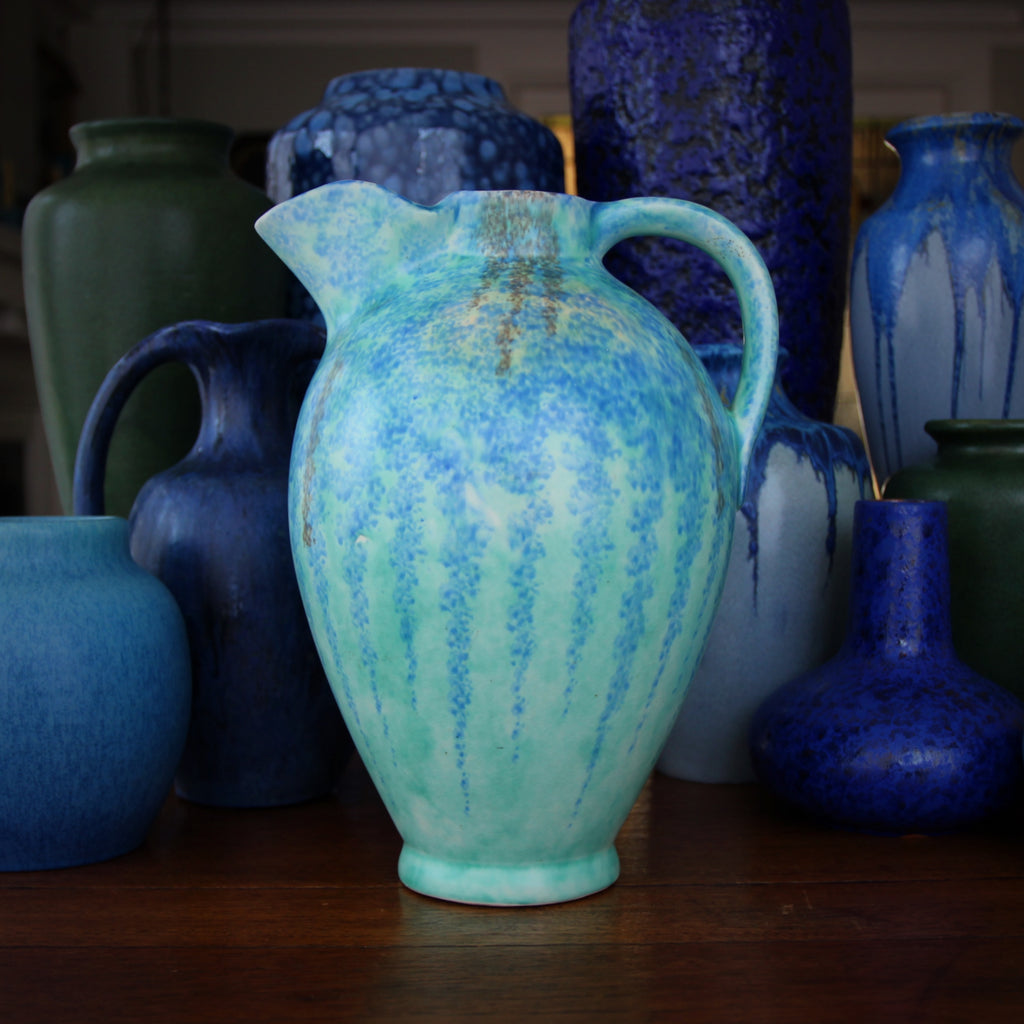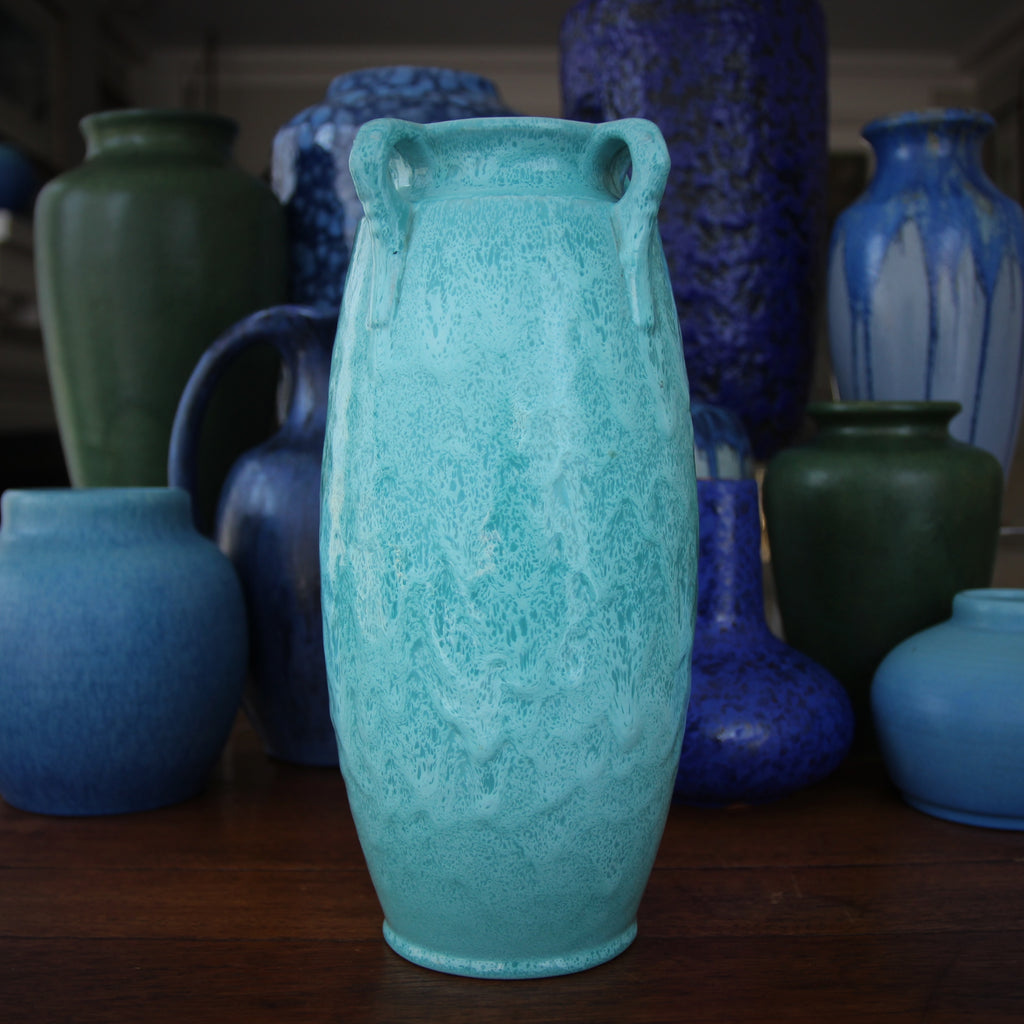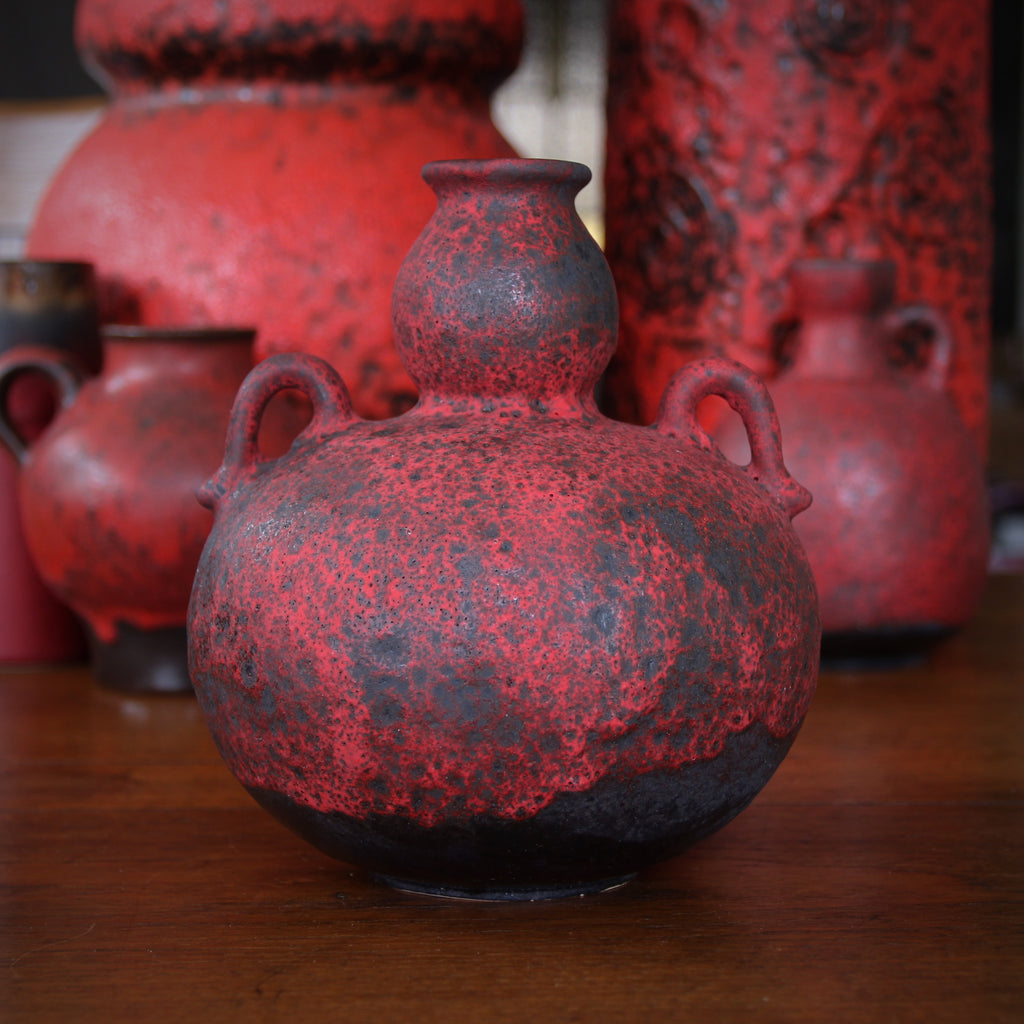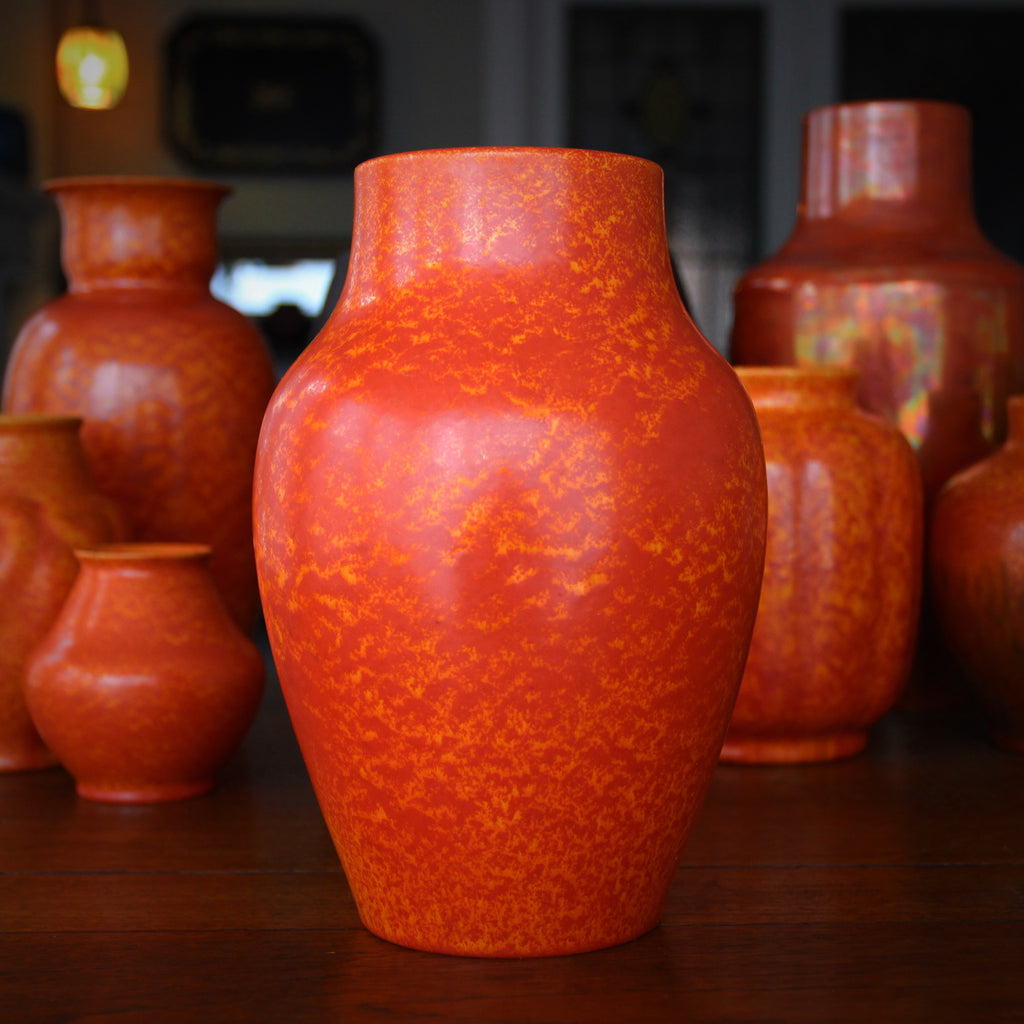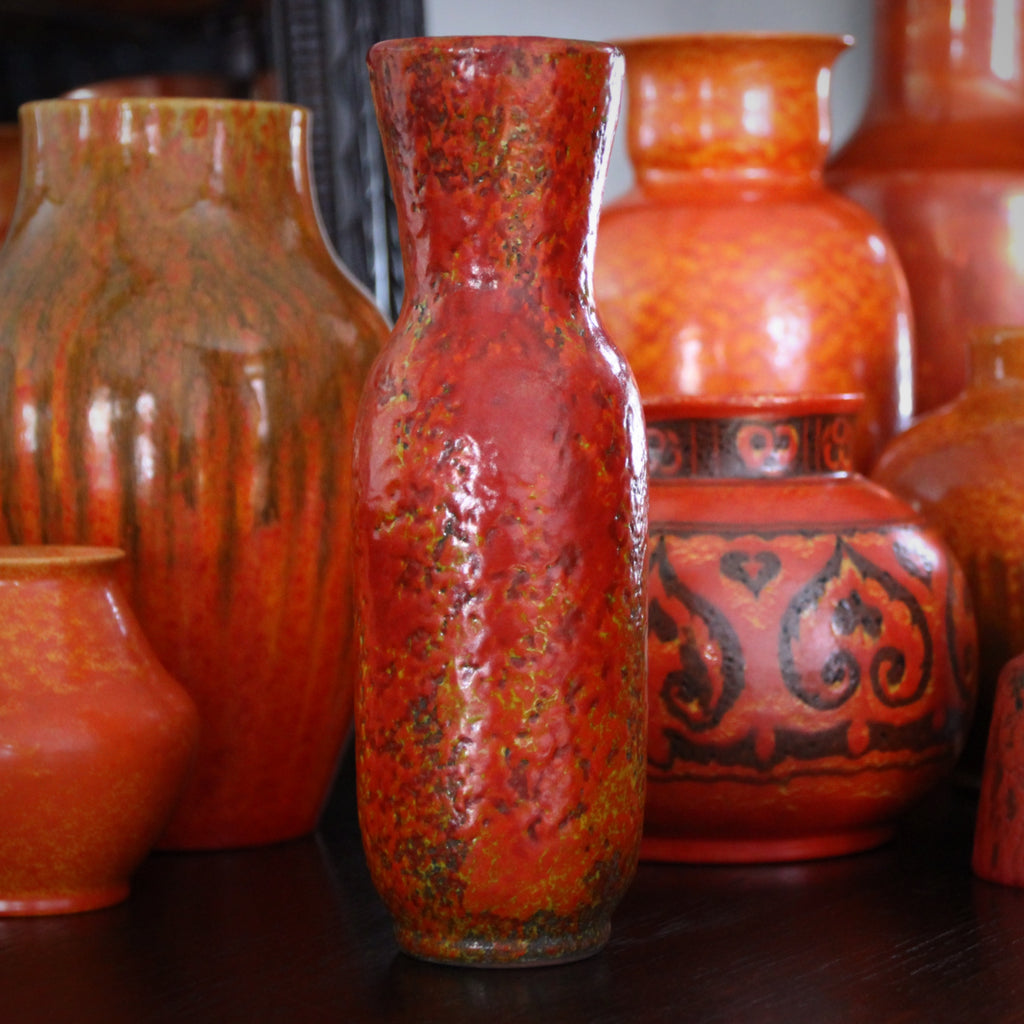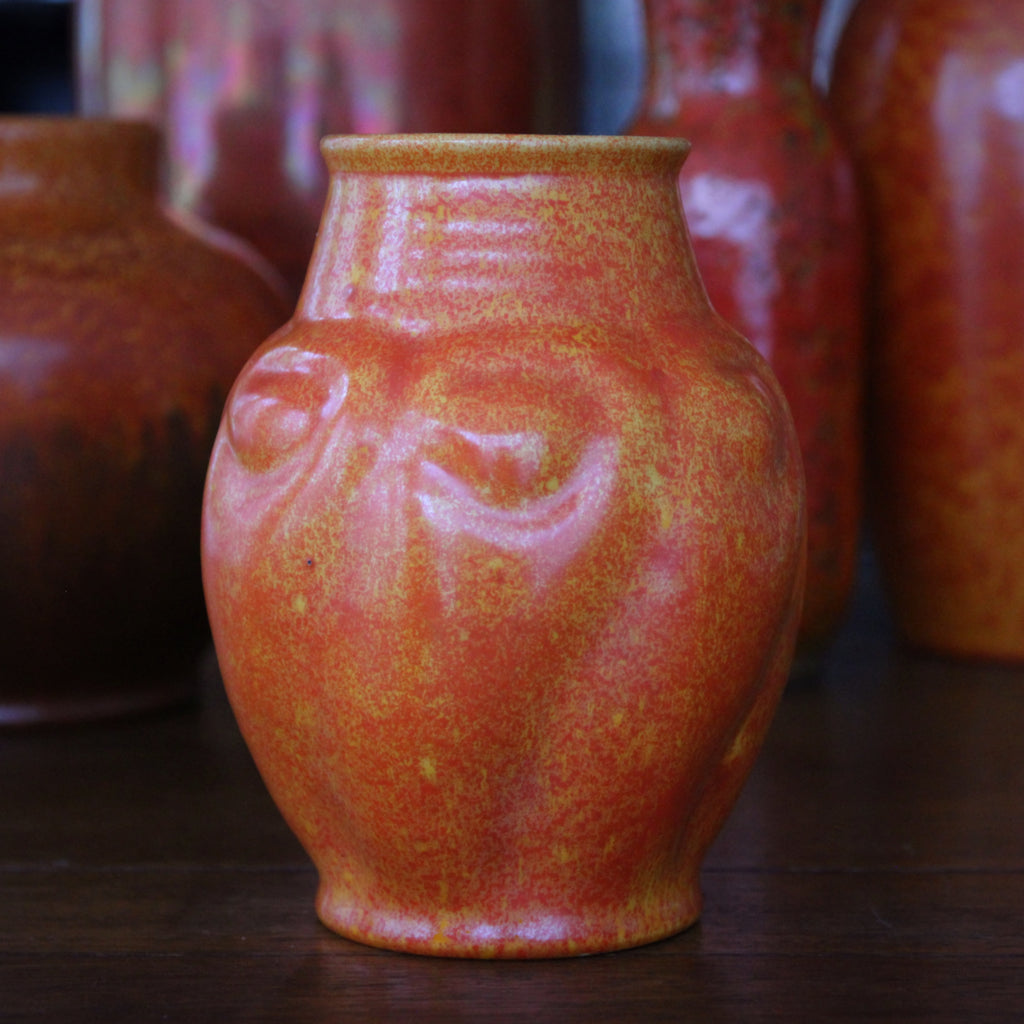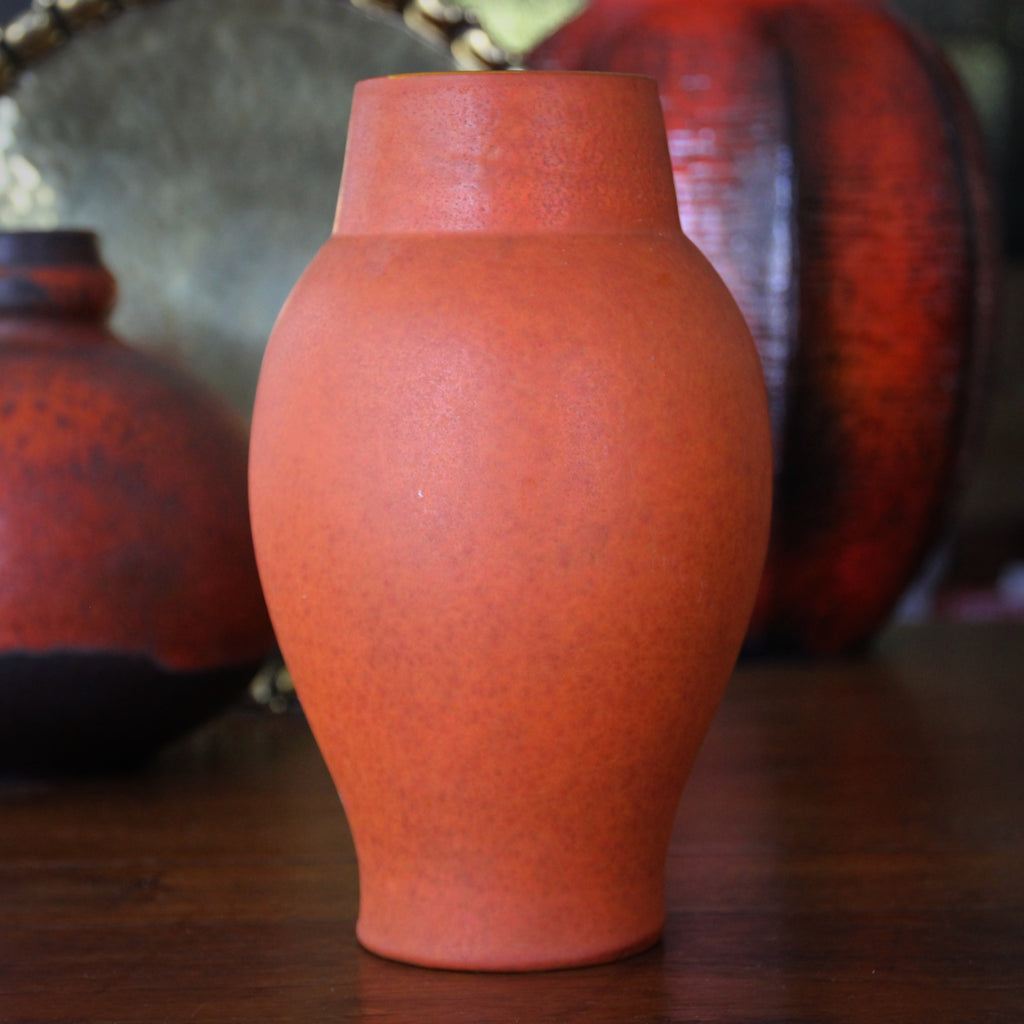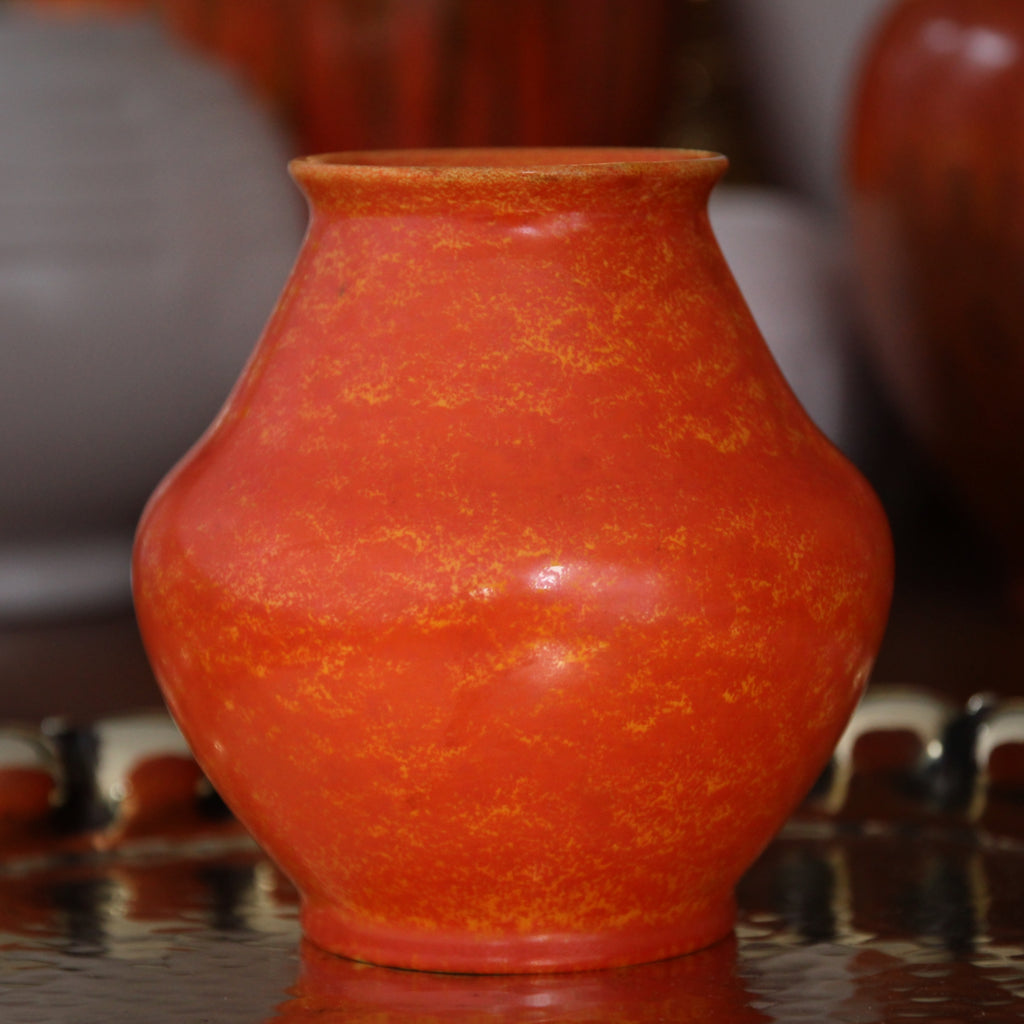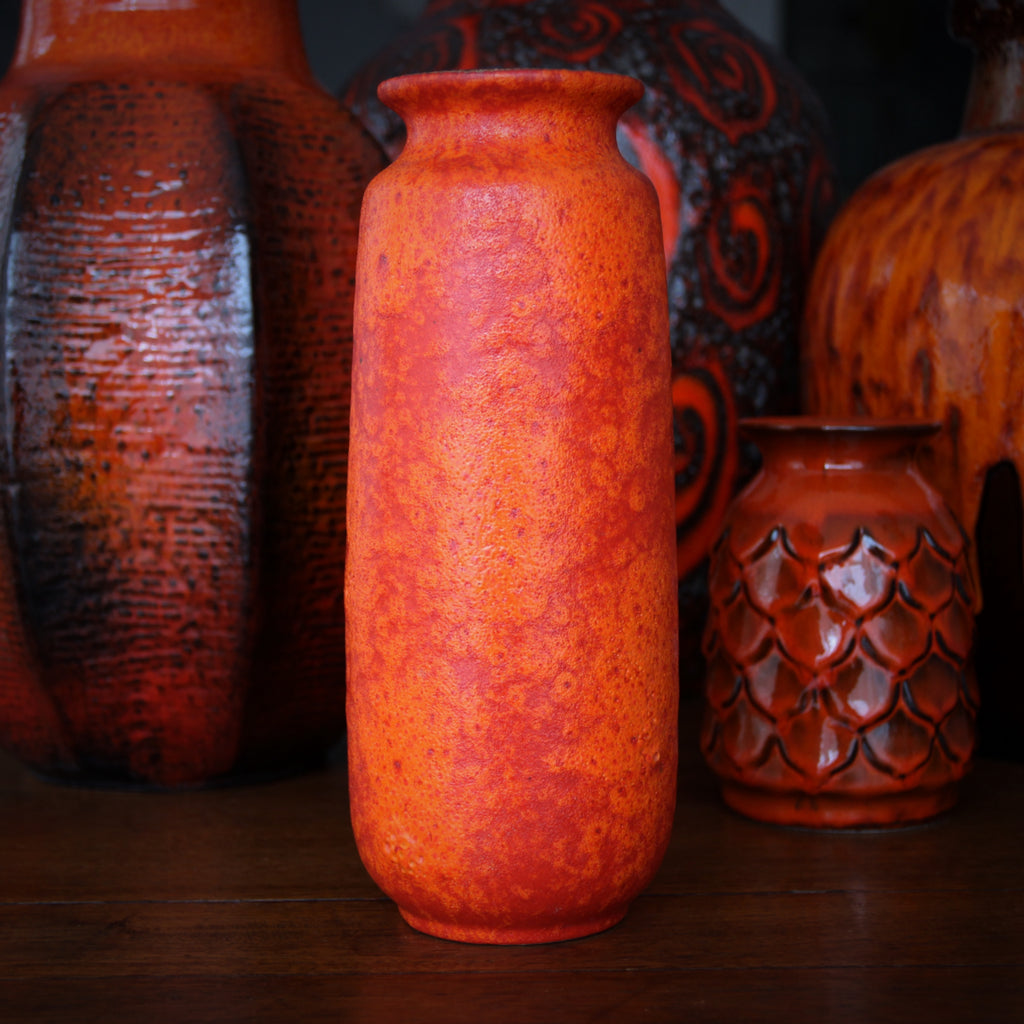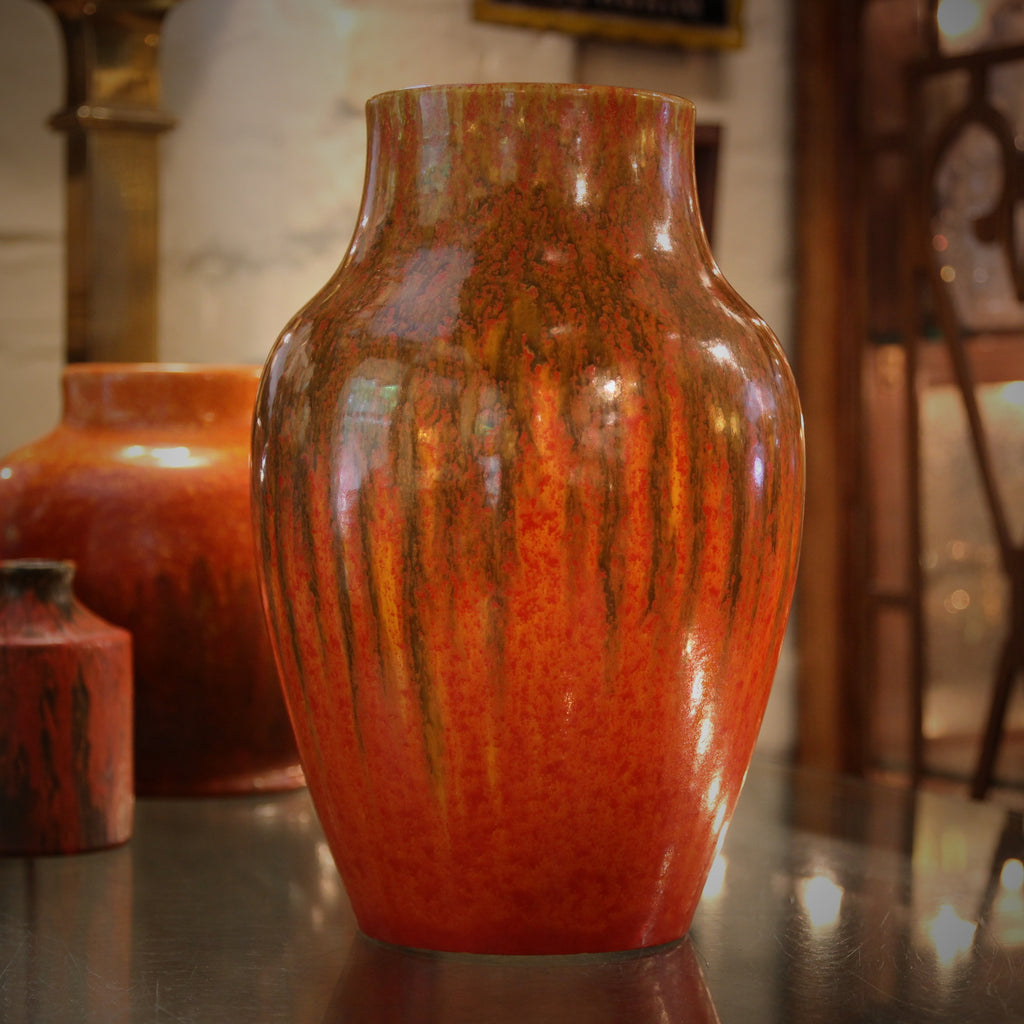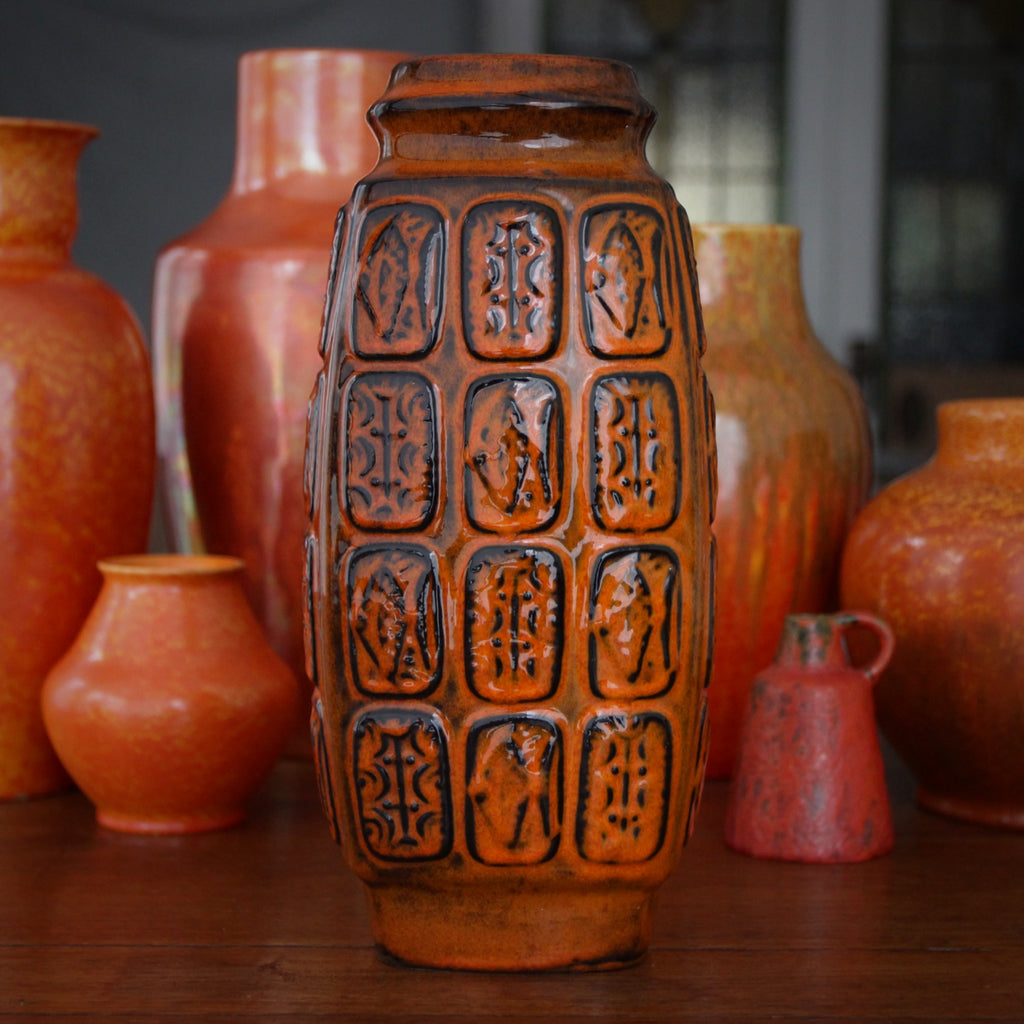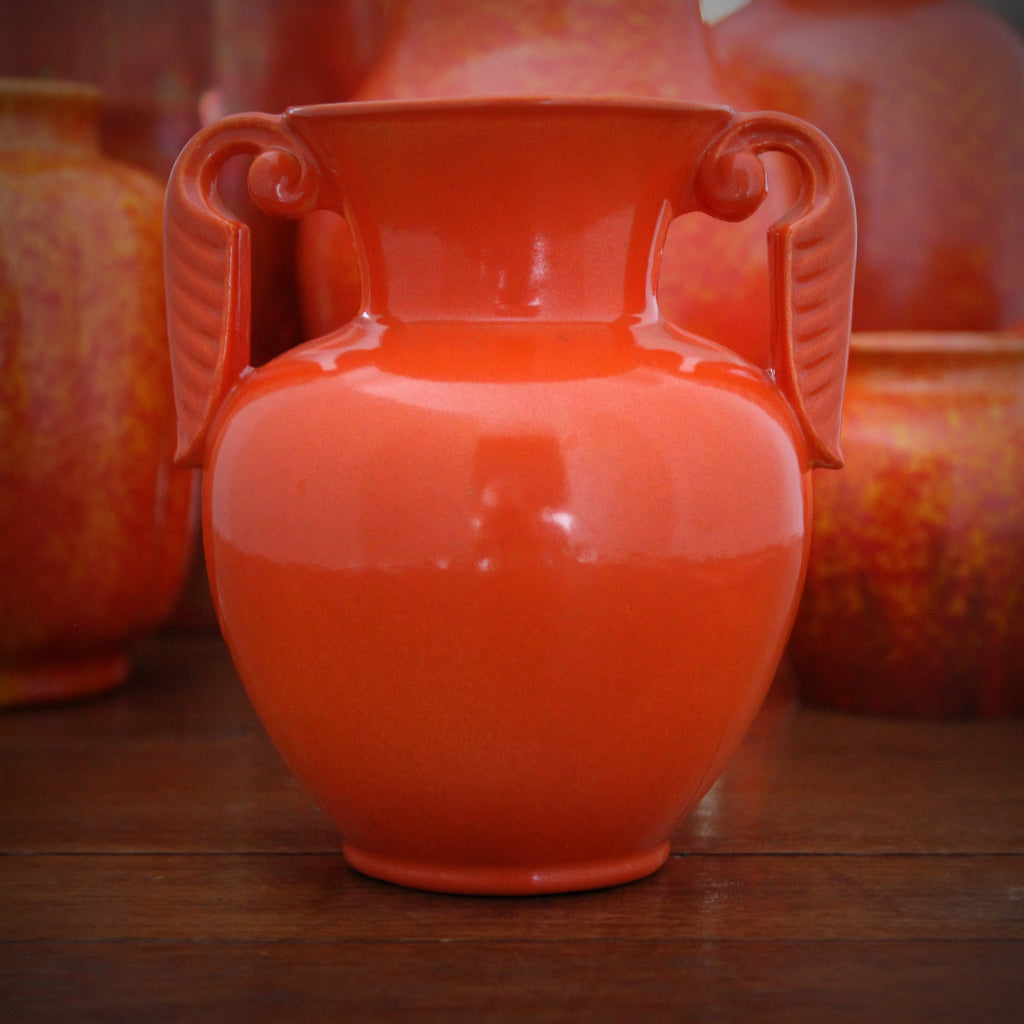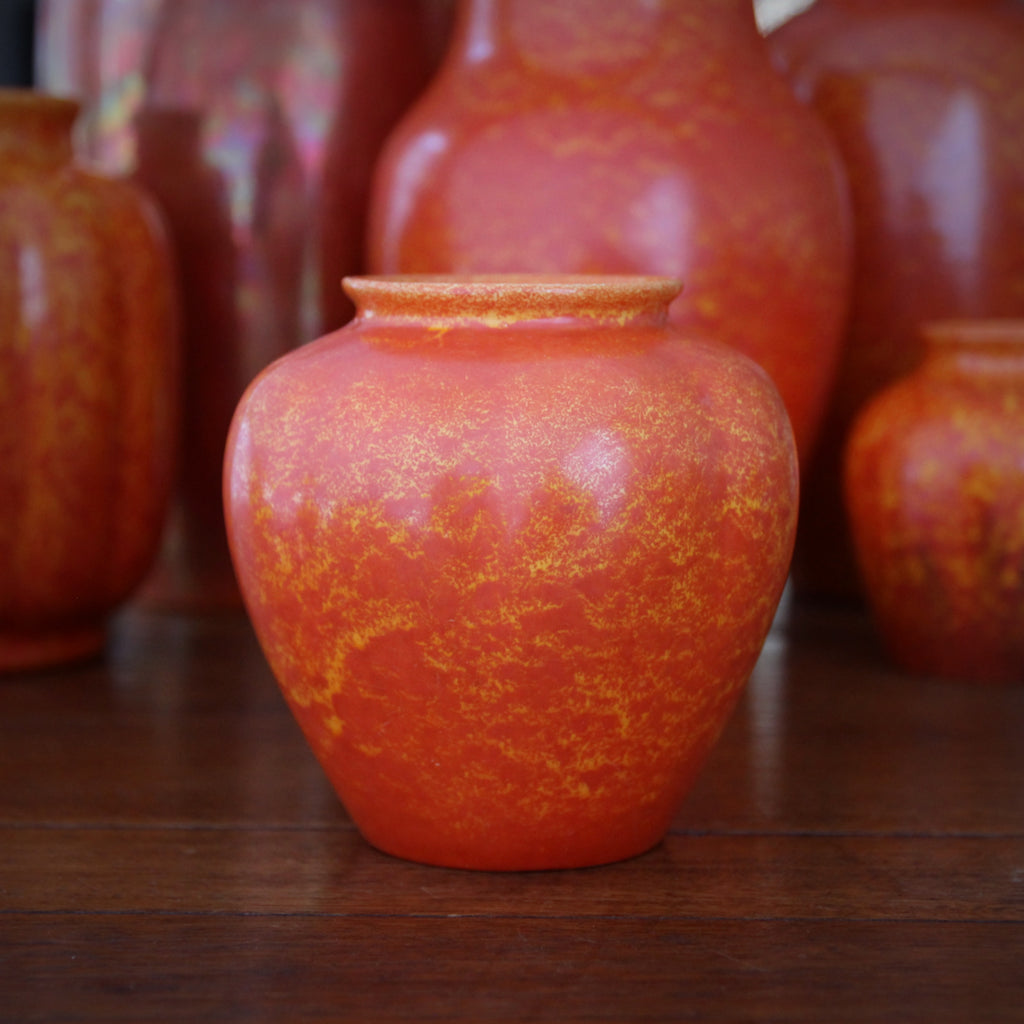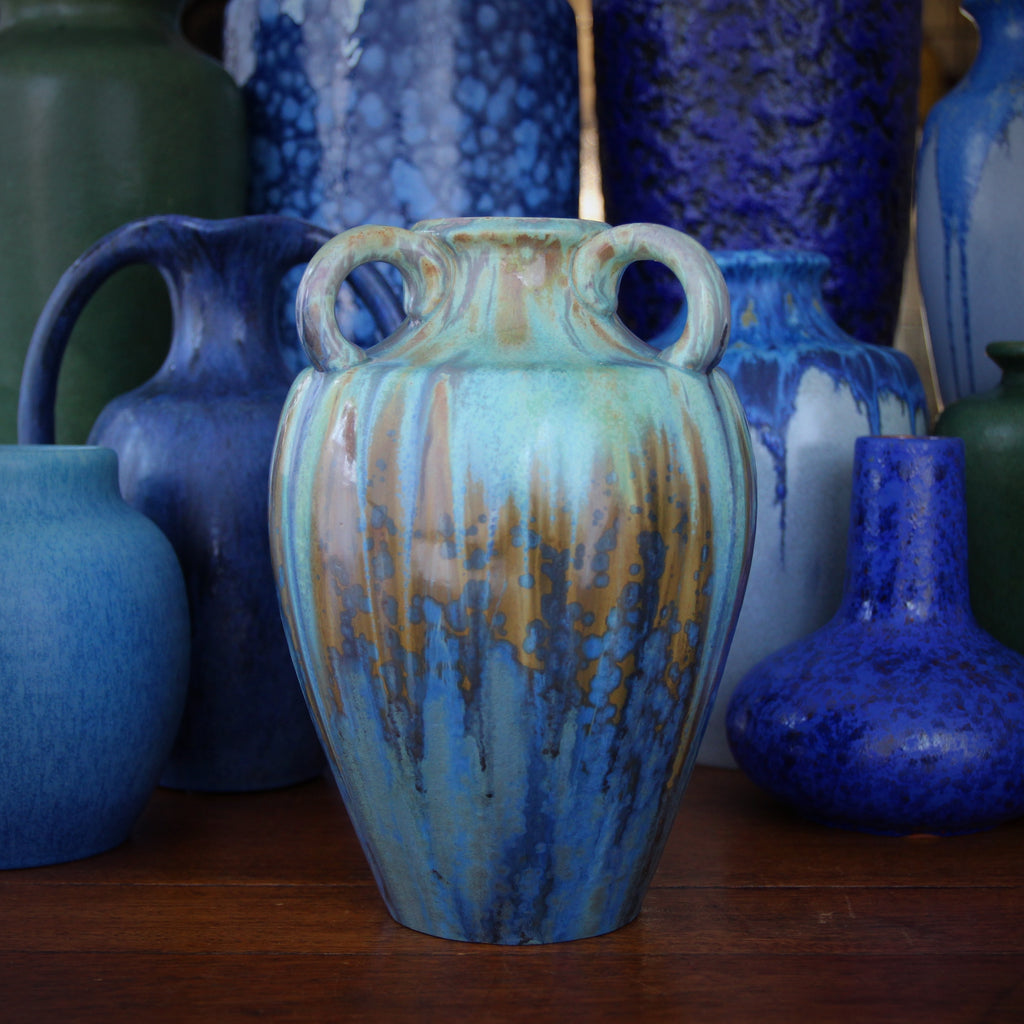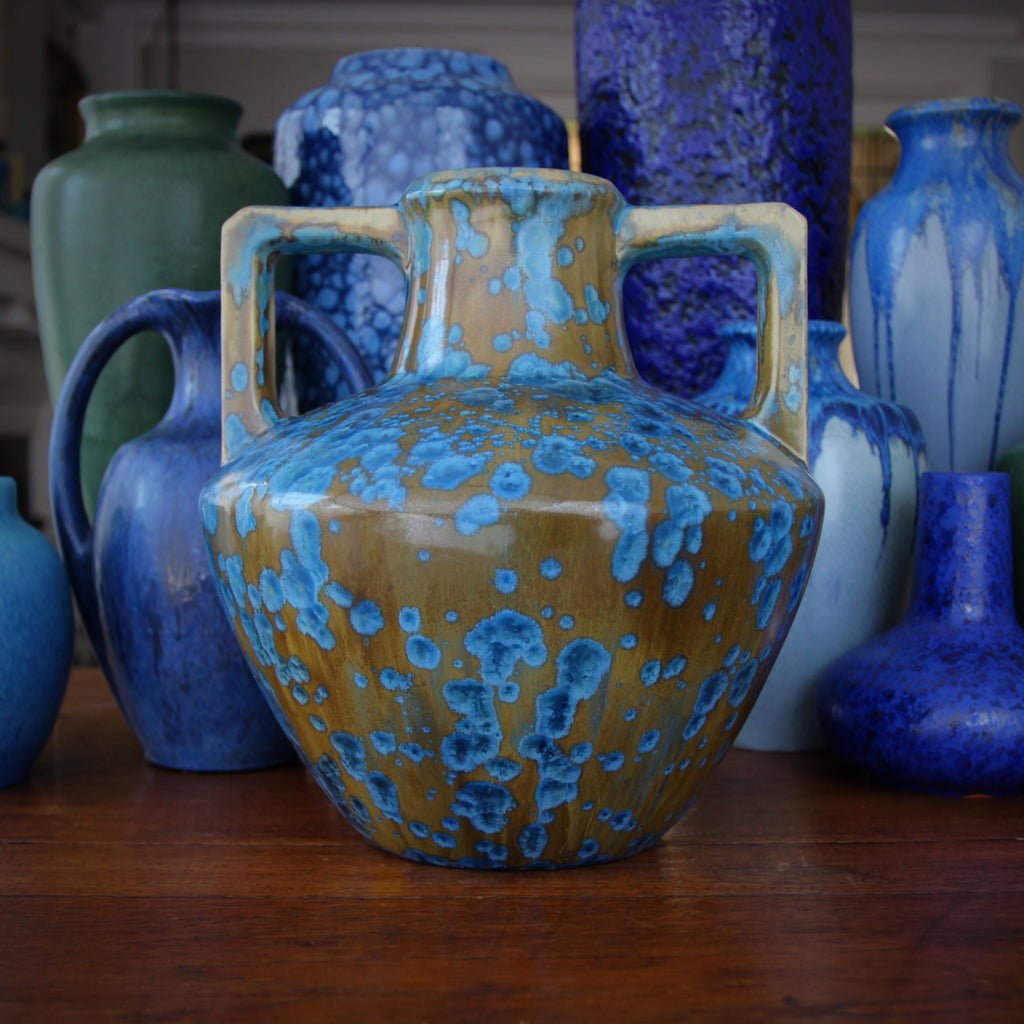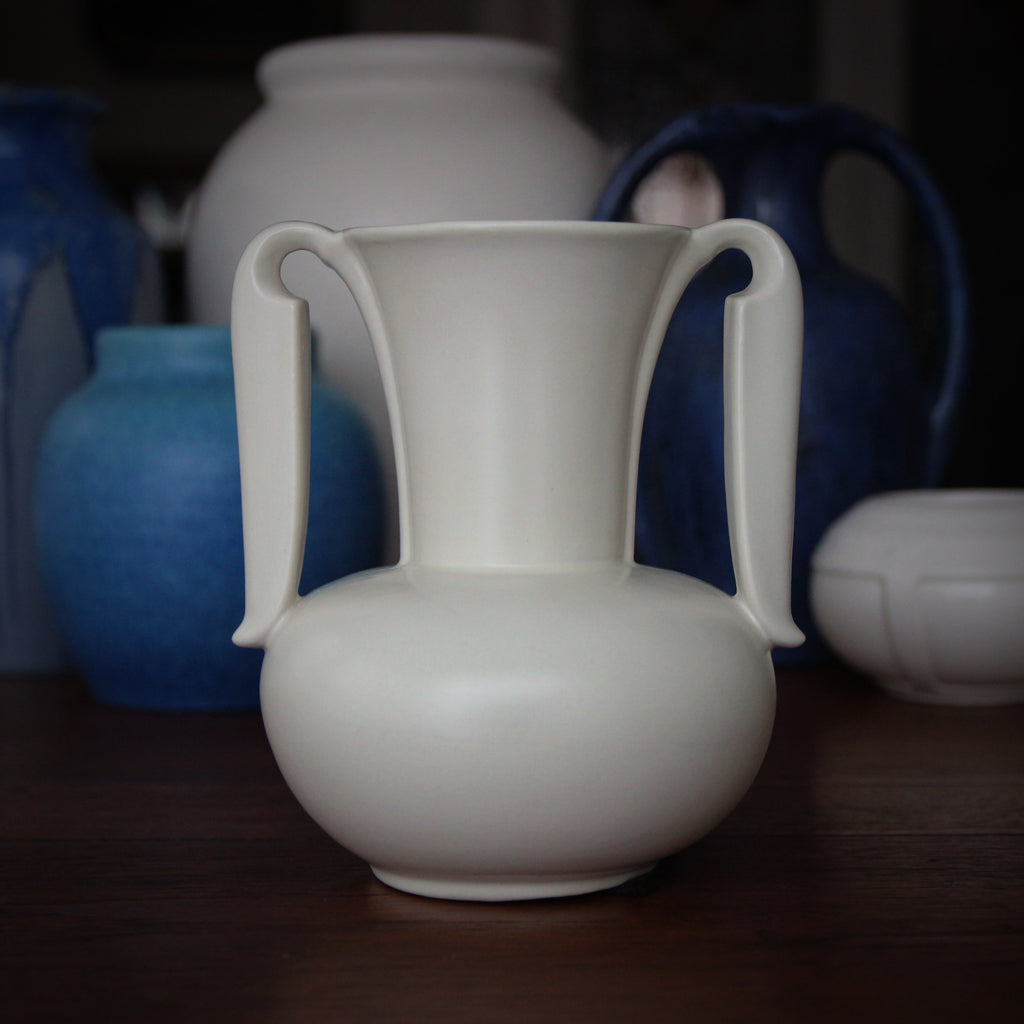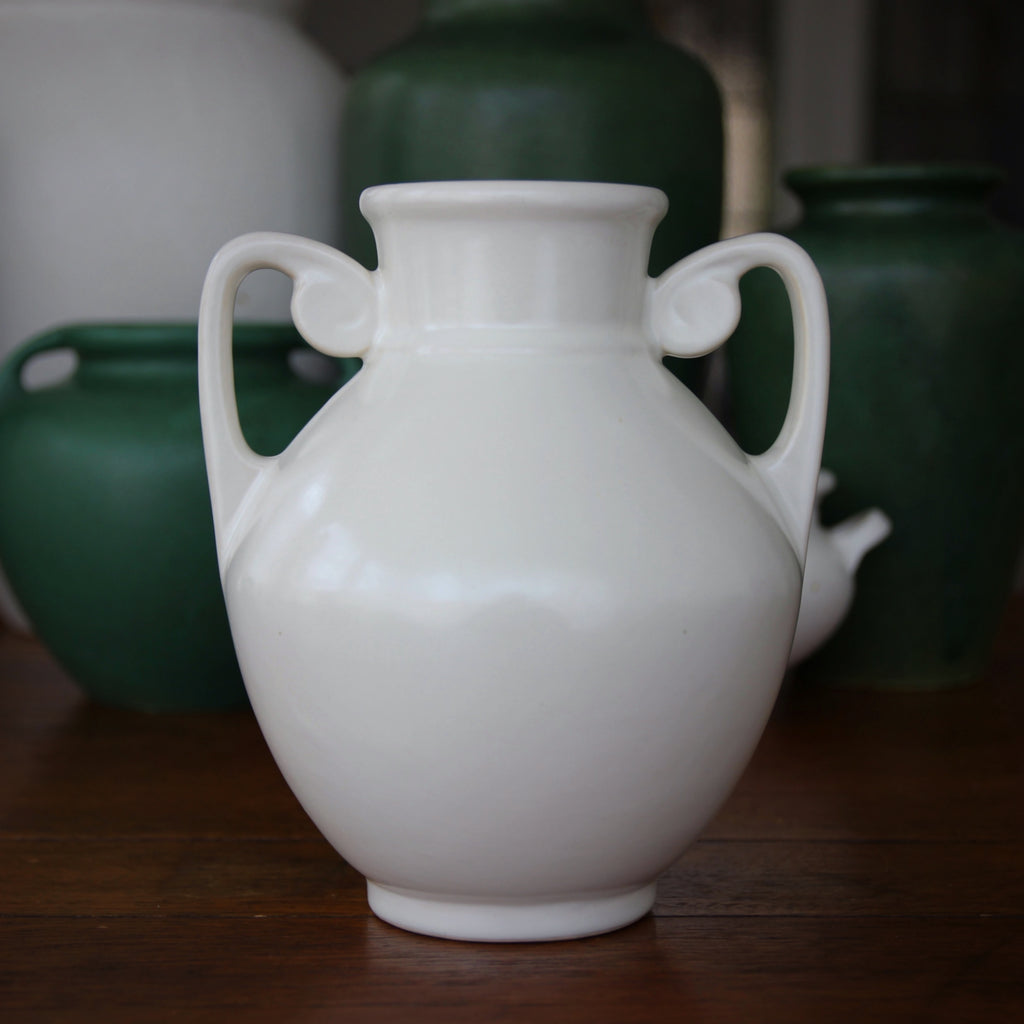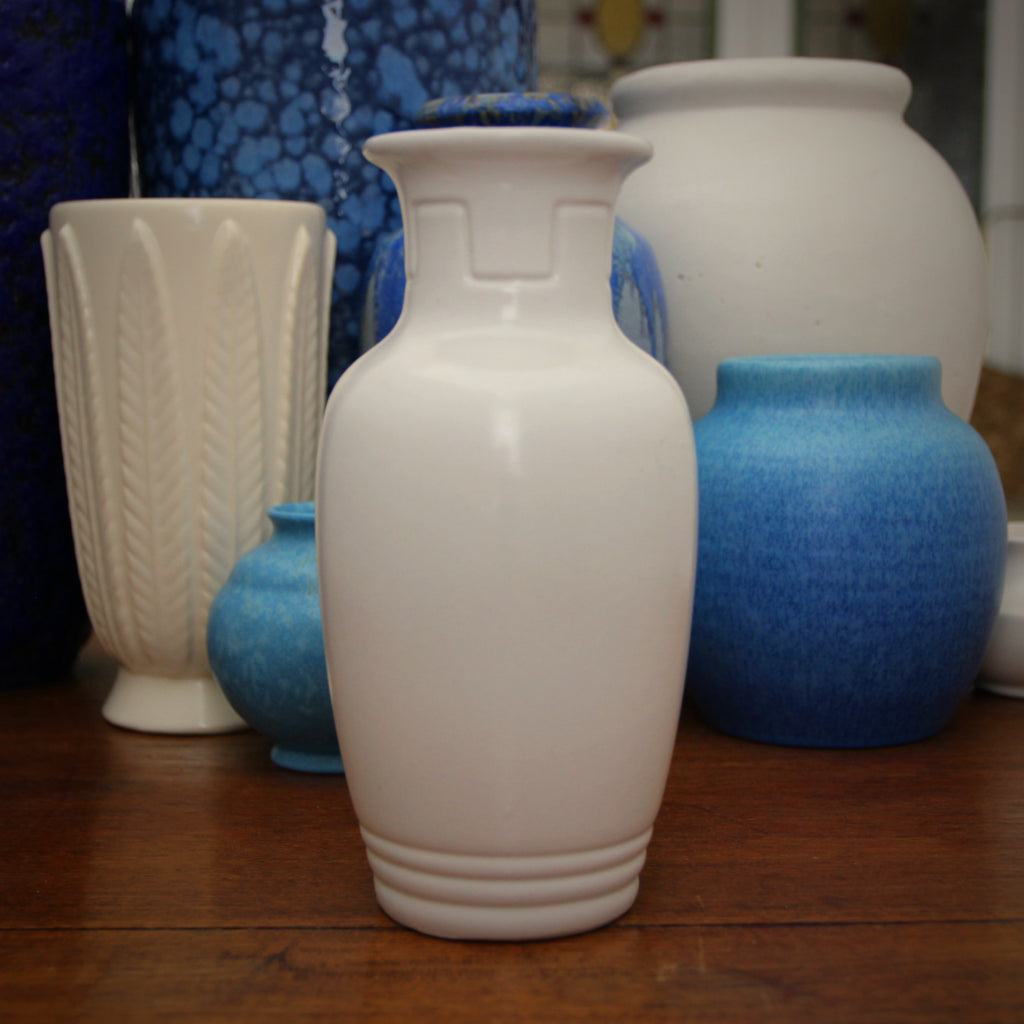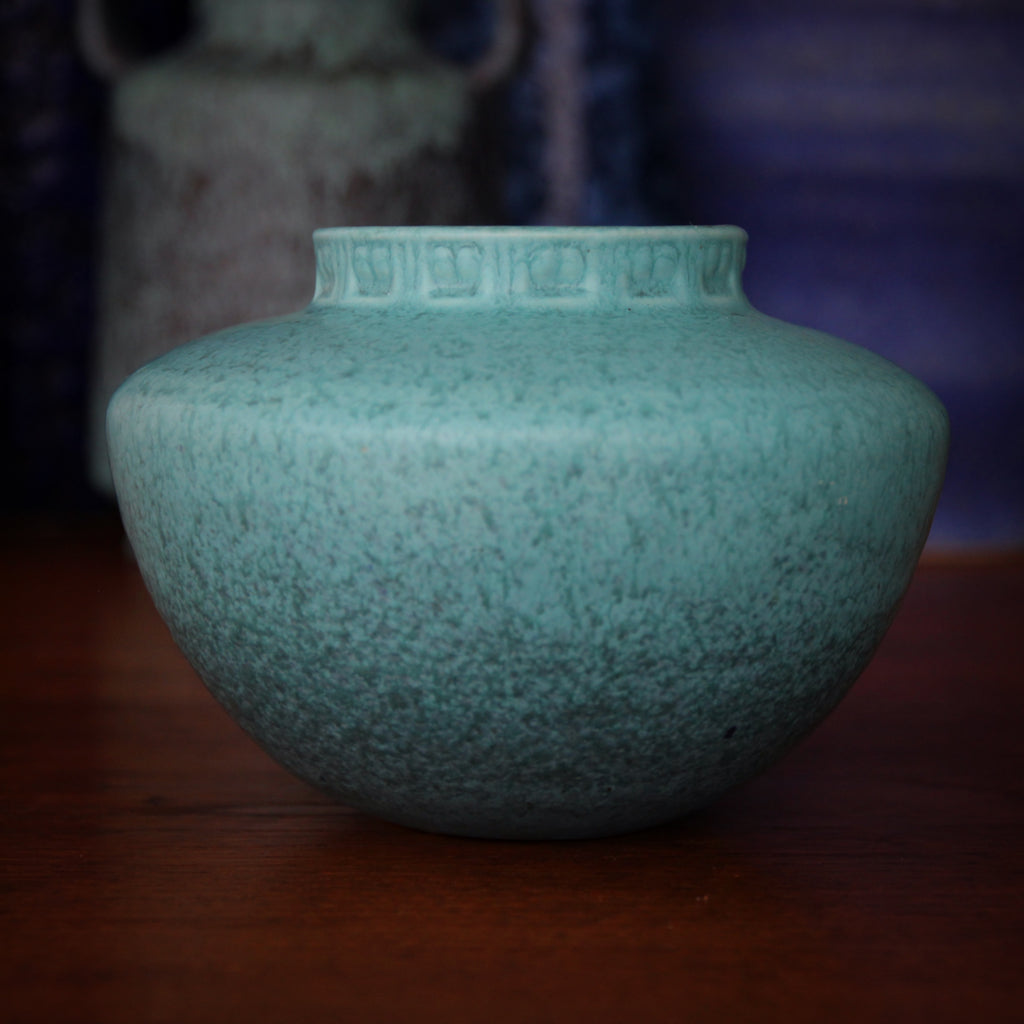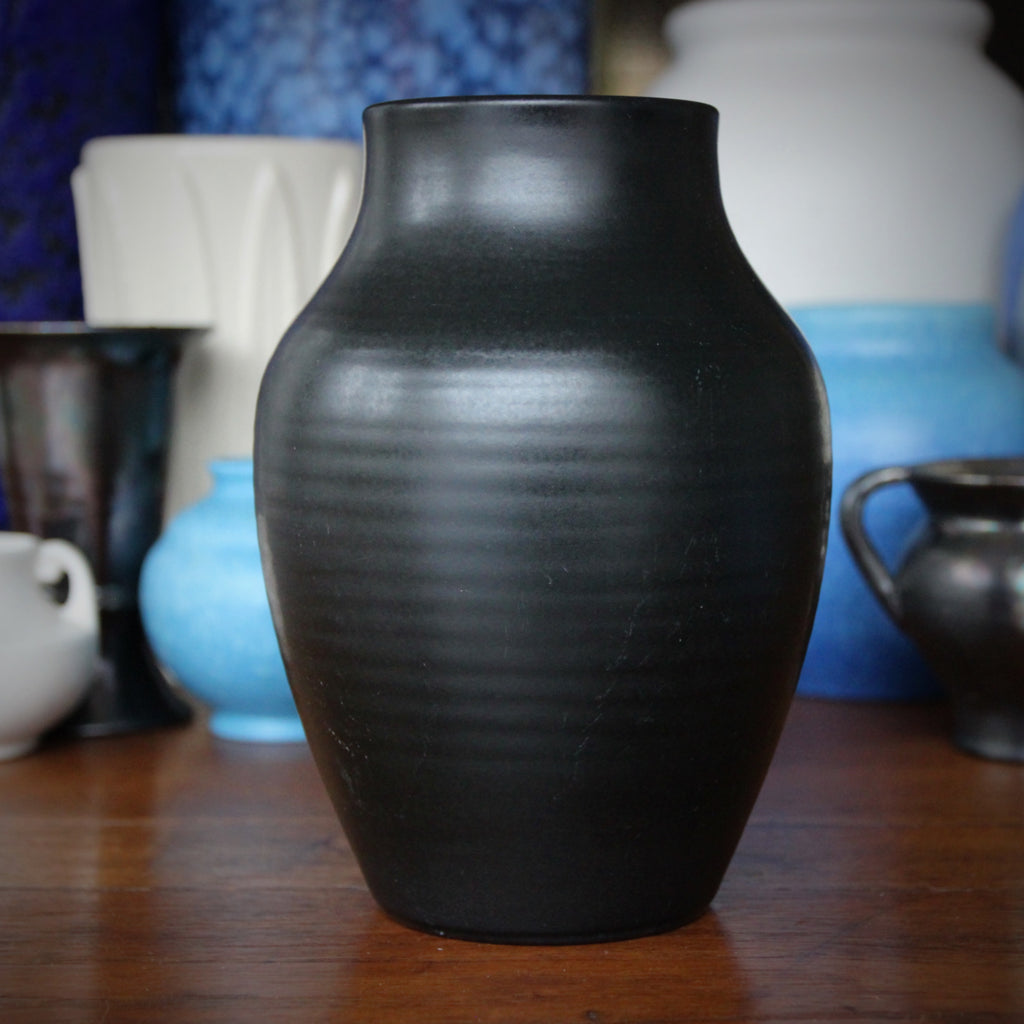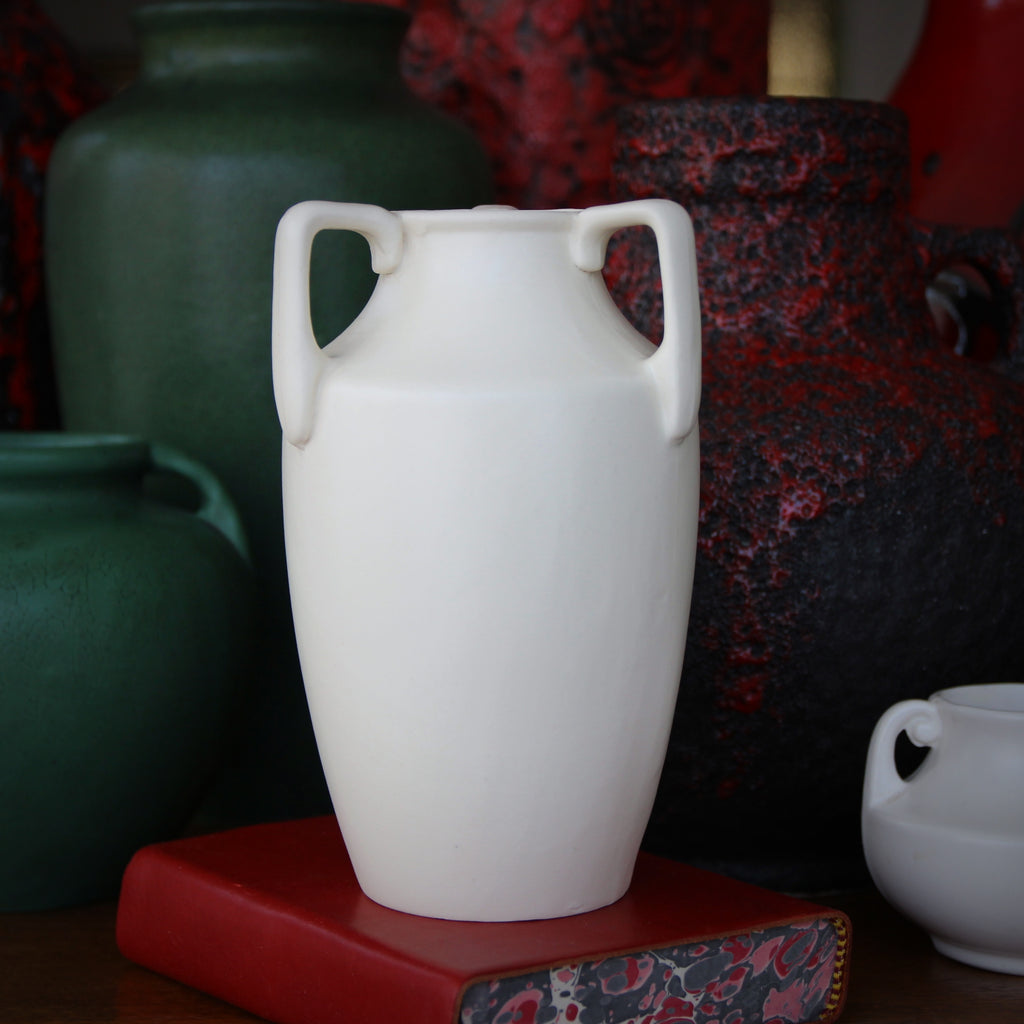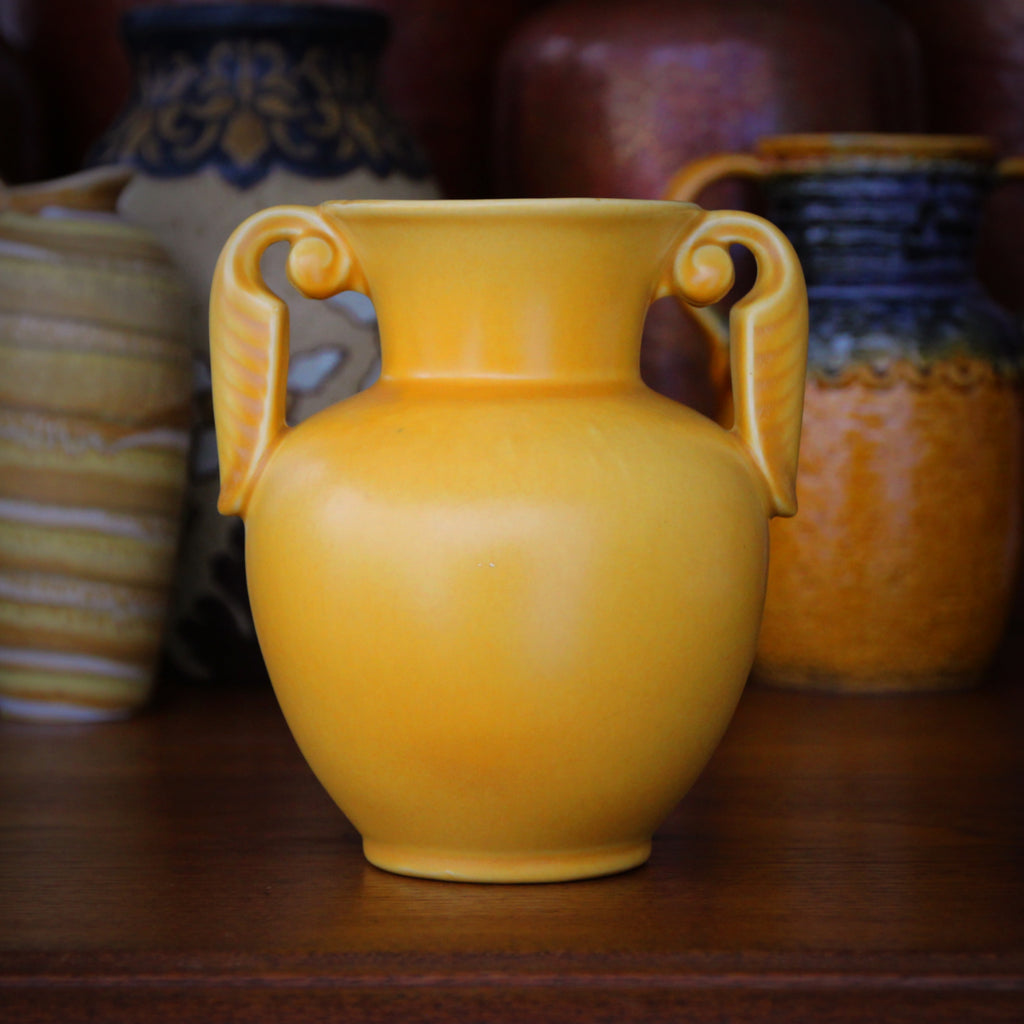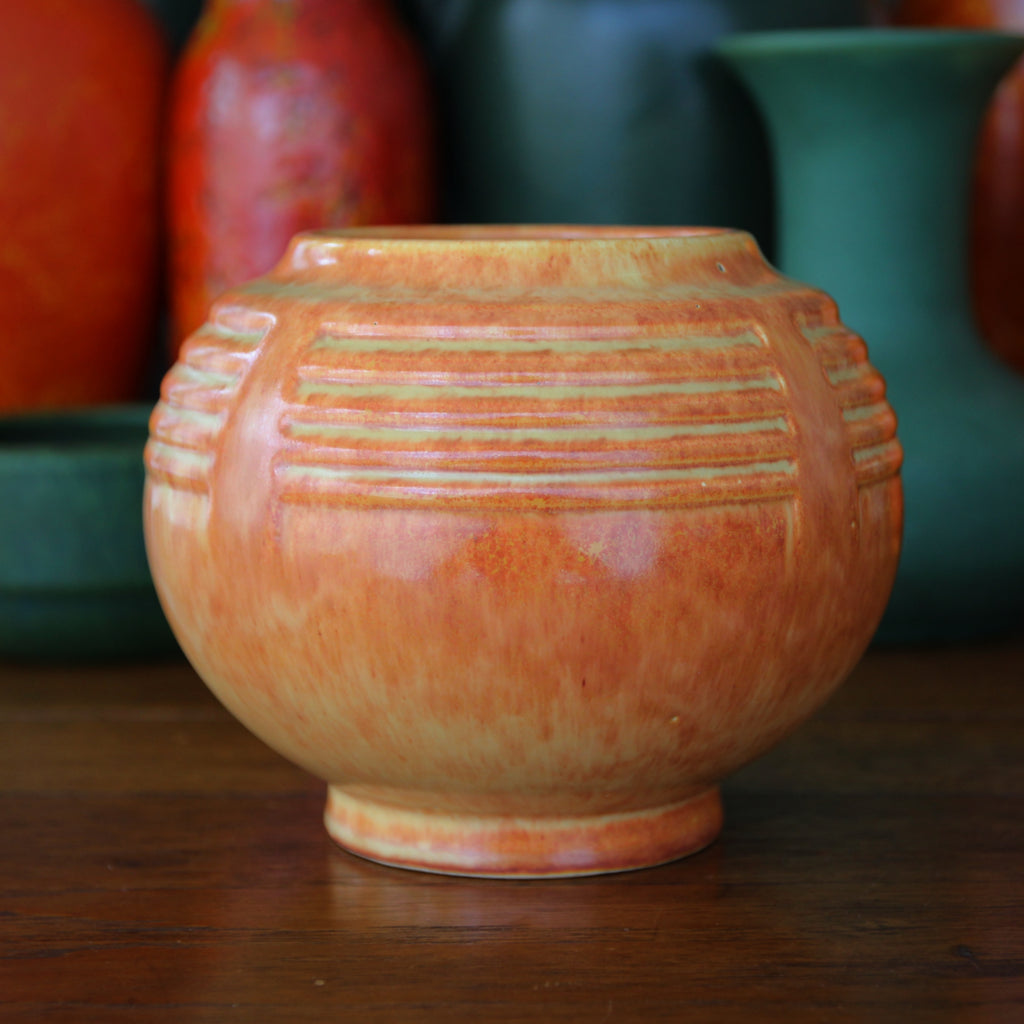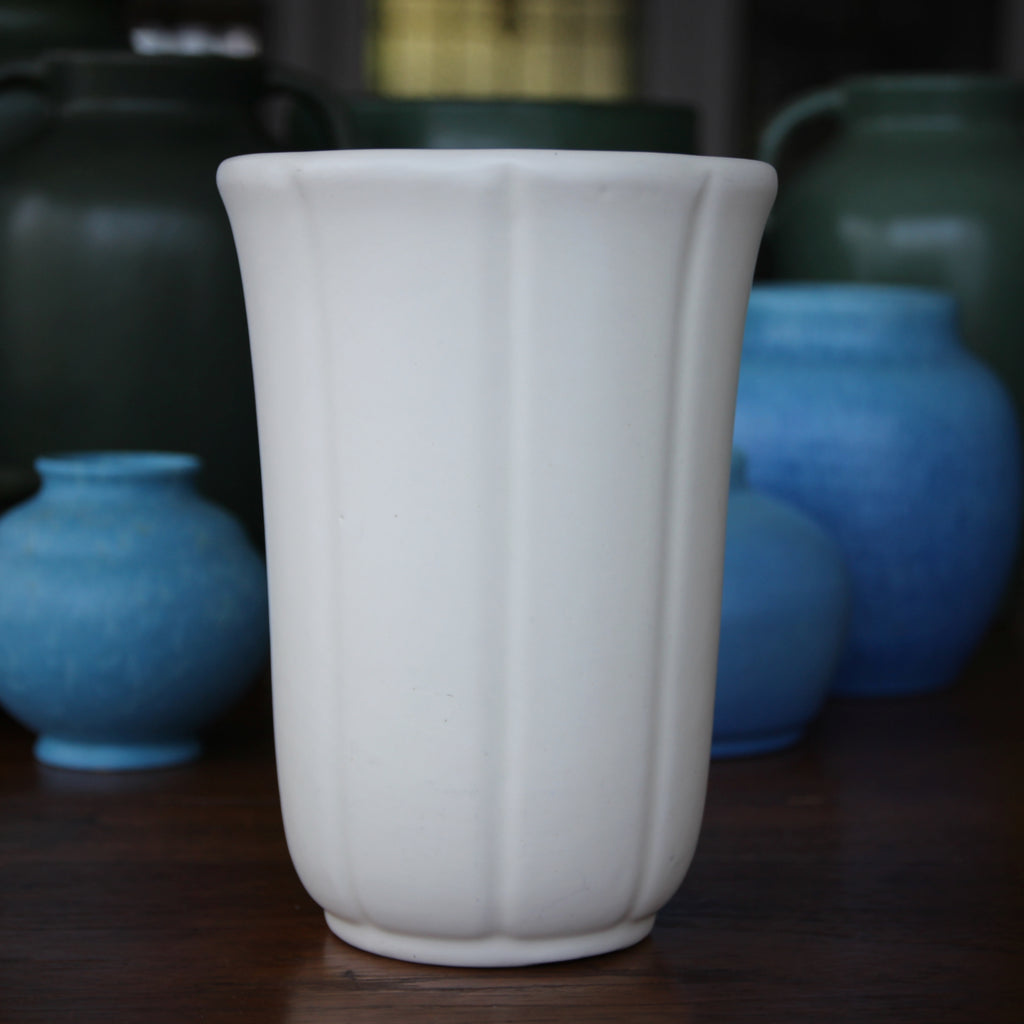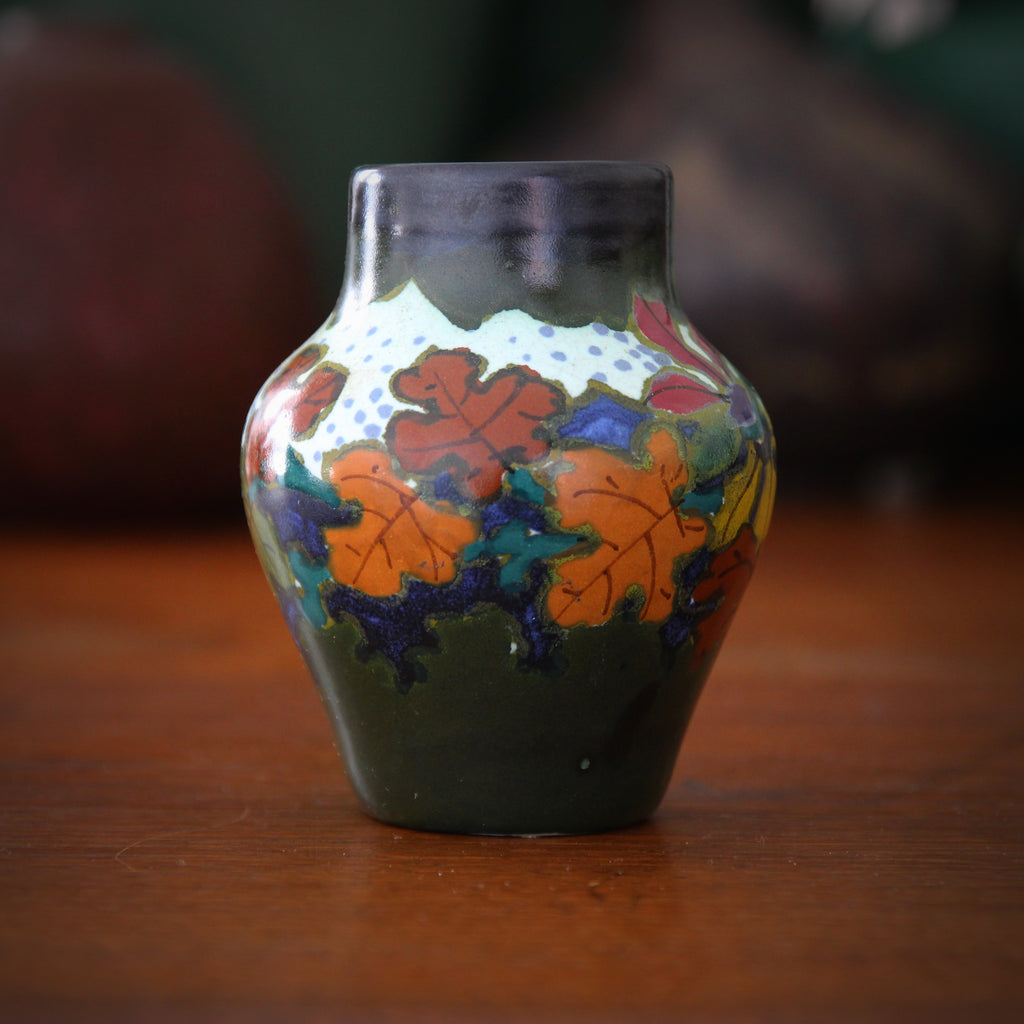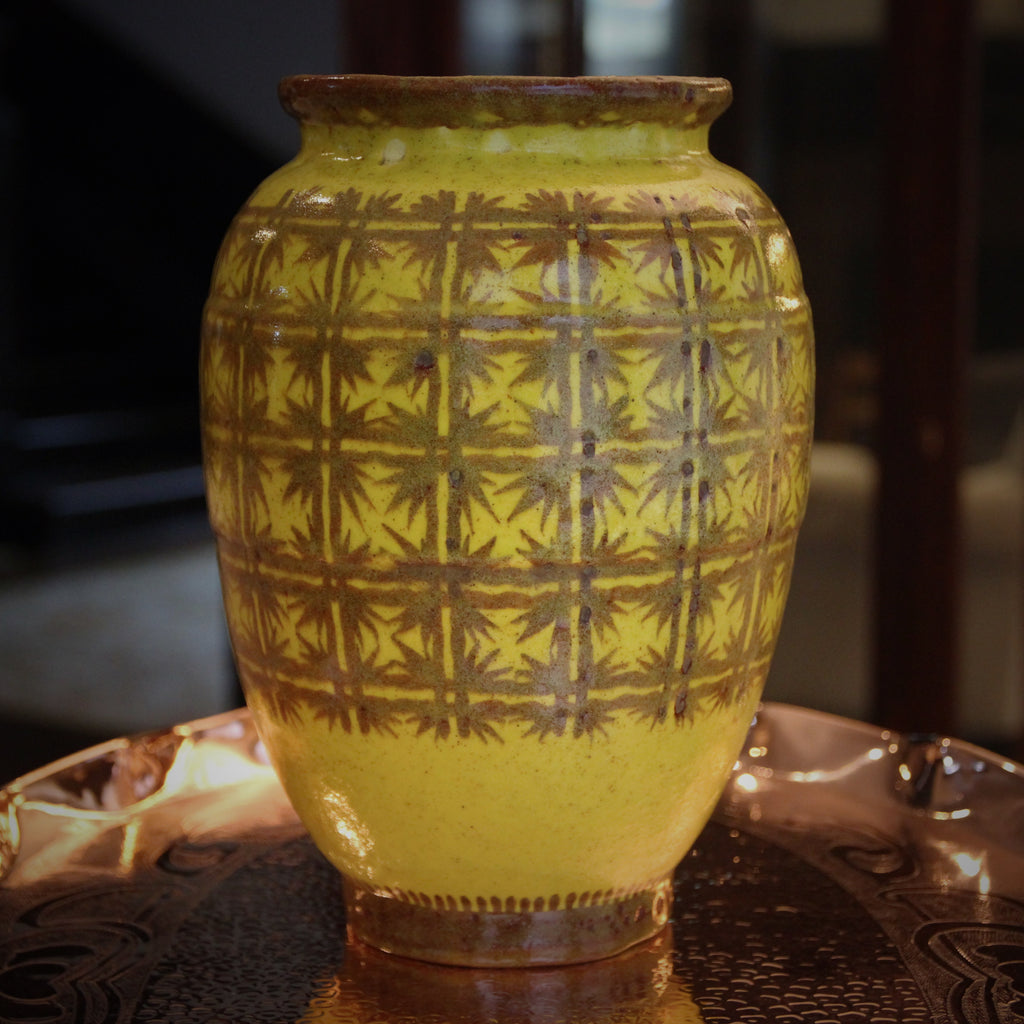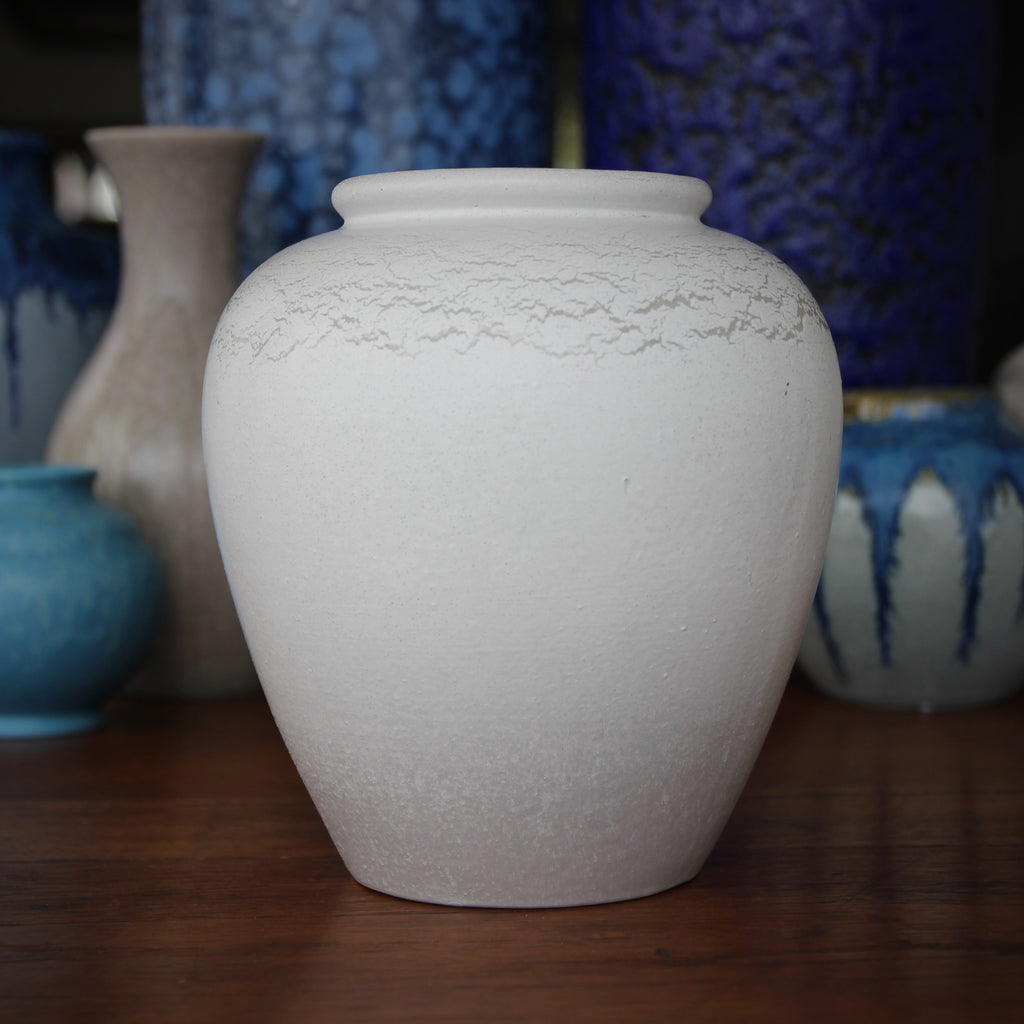JOURNAL — Vases RSS
Squirrels aren't the only wildlife wreaking havoc in my urban garden. Deer—over-populated and starving in the forested, nearby Schenley Park—have begun to cross into the city streets in-search of food. Since the mountain lions (which once roamed the area) are now gone, the deer population has exploded and they have stripped their wooded domain of grass, leaves and bark. As they venture out of the forest, they bring numerous problems with them. Automobiles hit them. Ticks (possibly bearing Lyme Disease) drop-off the deer, lying-in-wait for the next dog or human to pass-by. (A colleague of mine is currently battling the devastating effects of Lyme Disease—and not well.) And the starving creatures devour my lovingly-tended plants, sometimes just as they emerge...
Autumn is Here - part XI
The Art Deco ceramic rosebowl, shown here, made by Roseville in the Thirties, is an amalgamation—an artful melding—of two very different aesthetic sensibilities. First there is the form: a high-concept, industrio-mechanical sculpture, reminiscent of the vents on a piece of machinery (if not the gills on a robotic, Jules Verne shark). It's a hard, cold structure—practical, technical, efficient. (And a little scary, like a piece of equipment on the Star Wars Death Star.) Laid upon that is the second factor, the glaze. Its soft, mottled, earthy and organic coloration belies the hard, industrial form beneath. This juxtaposition of the gentle and the stern provides a wonderful contrast—a tension—in the final piece. And, as one can see, the glaze...
Autumn is Here - part VIII
October is here! And with it comes the marigold—birth flower for the month of October.
Marigolds originated in Mexico and eventually spread South into Central and South America. This pungently-scented plant has been used medicinally, sometimes drunk as a tea, and it is also employed as a culinary herb. In South Asia, marigolds are used decoratively—strung into garlands or arranged as a carpet—for celebrations and Hindu religious ceremonies.
Over many years, the marigold has been developed into an easy-to-grow garden plant. Its fragrance, which some find unpleasant, is repellant to certain insects (thus marigolds are sometimes planted alongside other plants which require protection from infestation). And many varieties of marigolds have been produced by specialist gardeners.
Autumn is Here - part V
Arts & Crafts movements—around the world—sought to "revive" (or "pay homage to") the ancient cultures, histories, art or literature of their particular countries. It was a way of "going back to the older, better times" which haunted the memories of contemporary people. The Brits referenced Medieval literary figures in their Arts & Crafts creations: knights, maidens, monarchs and heraldry. The Germans revived their Gothic folklore and fairy tales. The Celts restored their ancient, Viking-inspired decorative elements (knots, crosses, dragons and hearts). While in America, Arts & Crafts designers paid homage to the ancient, native cultures which populated the country before the arrival of Europeans: Native Americans.
Autumn is Here - part II
Autumn leaves are the surest (visual) sign of the Fall season. Hilltops blush—first with a tinge, then with a flame of color. Sidewalks, eventually, are blanketed with crispy, desiccated leaves. Before long, the skeletal "arms" of trees—trunks, branches, twigs—will lay bare against the silvery winter sky. It's all part of the seasonal cycle of trees, and their leaves, which reminds us that the year moves-on, with or without our consent. But not to worry; the soft green buds of spring will be back in a matter of months. And the whole cycle will begin again.
Autumn Equinox
This morning at 2:50 Eastern Daylight Time, the Earth will undergo the Autumnal Equinox. The Earth spins on an axis which runs through the center of the Earth, from the North Pole to the South Pole. This imaginary "stick," on which the Earth spins, tilts toward and then away from the Sun over the course of its annual cycle. When the Northern Hemisphere of the Earth is tilting toward the Sun (as it does during the Spring and Summer), the days in the North are longer and warmer. When the Northern Hemisphere of the Earth leans away from the Sun (as it does during the Autumn and Winter), the days in the North are shorter and colder. This cycle of...
Last Days of LEO - Part II
The Minoan Civilization—centered on the Mediterranean island of Crete—is considered the first civilization in Europe, which coalesced some 5,000 years ago. Around 1450 BC, they came under the domination of the Mycenaeans (Ancient Greeks) and a hybrid culture developed. But the art and society of the Minoans (as can be seen at the Palace of Knossos) was lively, energetic and wonderful. The island boasts a small but terrific museum. The vase above, made in Art Nouveau Belgium by potter Antoine DuBois, is inspired by ancient ceramics such as those found in Crete. A Minoan or Greek-inspired lion leaps beneath a band of Greek Key fretwork. On the reverse, a Greek stylized palm leaf can be found, similar to those found...
. . . And a Sublime Summery Sky
We're sharing selections from our collection of art pottery, now in-stock at LEO Design, which reminds us of the Summer: the sea, the sky. This English Art Deco piece, made by Beswick in the Thirties, is a delicious combination of aqua glaze, topped with sponged-on cornflower "tendrils." The bright, optimistic coloration can only mean Summer. And the form—reminiscent of a fat penguin—adds to the piece's happy mien. It's large enough to make a statement on its own. It would also look wonderful anchoring a collection of aqueous ceramic vessels.
Summer's Last Tide . . .
The Summer ends six weeks from today—on Saturday 23 September. While six weeks of Summer sounds like a good, long time, in fact, the kids will be heading back to school in a matter of days (if they're not in-class already). The snap of Autumn (along with apples, sweaters and pumpkin spice) will be with us before you know it. So, let's bask in the glory of Summer warmth for a few more days. This impressive West German Modernist vase is tall, topped with four "strap-ring" handles, and is dressed in a foamy, aqueous glaze—like turquoise seawater churned with traces of foam. Its bright, optimistic color certainly reminds me of Summer. Perhaps it will take us back to those wonderful,...
Earlier Aesthetics
In the world of design and aesthetics, rarely is anything truly new. Designers, staring at their empty sketchbooks (and, perhaps on-deadline) have been "borrowing" other artists' good ideas since the Mesopotamians (and maybe before that). And this is not a bad thing. In my book, novelty is never as important as taste, beauty and craftsmanship. Appropriation—of dress, cuisine, architecture or artwork—is acknowledgement of someone's else's good choices. In the Arts & Crafts period, for example, designers and artists around the world sought local references from the artists (and the culture) which came before. Part of this was to honor the culture in which the (contemporary) artists were working. Additionally, Arts & Crafts designers were attempting to "go-back" to an...
A Desert Drive
At about this time last year I visited my mother in the Southwest, where she lives. Though she inhabits a fairly large town, which is part of a larger cluster of towns, her community remains "amenity-free"—meaning, in this case, that the nearest operating airport is 4 hours away by car. (By the way, there also are no arthouse cinemas or comprehensive bookstores in her town, either). I surmise that few people in her region of 100,000 people ever go anywhere by plane (or see foreign films or read secular books). So I flew to the nearest airport, rented a car, and drove the additional 4 hours to join her. Despite my annoyance (and travel exhaustion), it was a beautiful...
Going Dutch - Part V
Let's end our summer tour of Gouda with this sunny, summery piece made in the 1920's. With just a whisper of Mediterranean chic, this Dutch vase is embellished with bold flowers and leaves in marigold, burnt orange, mossy green, aqua blue and white. A serpentine border provides a meandering edge to the painting. This happy vase will certainly take you back to sunny days during the coldest weeks of the Winter.
Going Dutch - Part IV
Of all the Gouda pieces I've bought, sold and collected over the years, this one may be my all time favorite. The size is impressive. The shape sublime. And the hand-painted Art Nouveau florals are boldly handsome. But it's the color that delights me the most: a sophisticated blend of varied, saturated blues set against an earthy olive green (with small pops of golden embellishment). The color palette is an exercise of sophisticated restraint. It's date-marked 1922, a few years after the Great War, during the waning days of the Art Nouveau movement. In a couple of years, the Art Deco movement will coalesce. (Though the movement will go by a different name for a while, "L'Art Moderne." The term...
Going Dutch - Part II
This week we are sharing a collection of nice Dutch pottery from Gouda, the inland city in the Netherlands. I have always liked these hand-painted ceramics, especially those Art Nouveau pieces which seem to be inspired from Oriental ceramics (in this case, pottery and tiles from the Near East: Persia and the Arab lands). Such "exotic" ceramics, made in Holland, would be more accessible and less costly to middle class consumers in Europe. While the carriage trade could afford real Persian ceramics (or, better yet, vases from China or Japan), working people—desiring a little taste of Orientalism—could better afford something less rare, made closer to home. The genie bottle, shown above, has the feeling of Persian ceramics work—with the inclusion...
Going Dutch - Part I
Gouda (pronounced "How-dah") is a Dutch inland city—known for its local cheeses, bisque clay pipes, Stroopwafel and hand-painted ceramics from the Art Nouveau and Art Deco eras. Built on marshlands in the Medieval era, Gouda had all the things needed for ceramics production: clay, a heat source for firing (peat), a manner of transport (waterways, then railways), and labor for crafting the objects. Although some solid-colored pottery was made in Gouda, local potters are best know for the detailed, fanciful, hand-painted designs which ran the gamut from folk art to the sophisticated. The Golden Age of Gouda pottery was from the 1880's to the 1920's. Like many Gouda products (including pipes, cheese and Stroopwafel), Gouda pottery soon developed a worldwide...
Independence Day
Happy Independence Day! On this day in 1995 (I remember it well), I was on my hands-and-knees, belt-sanding the floor in my first shop, 413 Bleecker Street. The shop was to open in a month—and there was no time for a day off. But it didn't matter: I was independent, I was my own boss, I was taking the first few steps off of an interesting and fulfilling career as a shopkeeper. This year—twenty-eight years later—I probably still will spend (at least) a little time at work. I'm leaving on vacation in five day's time and need to make use of the time. I guess some things don't change! As in 1995, I still live a life on-deadline. But...
Time for Rubies
Welcome, July, and your birthstone, the Ruby. The ruby—called "The King of Gemstones"—is one of the four "cardinal" gemstones (alongside diamonds, emeralds and sapphires). It is a variety of Corundum, as is the sapphire (the blue variety of the same stone). Rubies get their color from chromium and the deepest, darkest-red stones are the most valuable (called "pigeon's blood rubies"). Pink rubies can also be found, however, in the United States, they must be sold as "Pink Sapphires" (not rubies). The ruby is also the third hardest gemstone (after diamonds and moissanite). All natural rubies have imperfections called "rutile needles" which give the appearance of threads or silk fibers within the stone. Such imperfections can be reduced through heating—though an...
The First of Summer!
Today is the First Day of Summer! It is also called "The Summer Solstice"—the "longest day of the year." Technically, the Summer Solstice occurs today at 10:57 am (Eastern Time)—the precise moment when the Northern half of the Earth is most-tilted toward the sun. Because of this maximum tilt, the Earth gets maximum sunlight (thus, it's the longest day). Going forward, the Northern axis will slowly tilt away from the Sun and each day will get a little shorter (until the Winter Solstice—the shortest day of the year—when the Northern axis begins to resume it's annual crawl-back toward the sun). Shown above, a summery Dutch vase. Made in Gouda, Netherlands, in the Twenties, it boasts a wonderfully-sunny hand-painted floral decor—a perpetual...
Spring Green
Spring treats us to a palette of wonderful soft green shades—from the yellowish to the bluish. And, as the seasons progresses, the colors deepen, become richer, stronger and "more serious."
This English Art Deco vase was hand-thrown by the potter Edward Thomas Radford for Pilkington Royal Lancastrian. A whisper of cool, pale celadon glazing recalls the tenderest of new spring leaves. Beneath this glaze, one can still see Radford's fingermarks, left permanently behind from the day the vase was turned on a wheel.
Such a soft green glaze looks best when juxtaposed against a complimentary (or contrasting) color. An aqueous wall or a collection of blue and green ceramics will bring-out the best in this handsome, delicate glazing.
Cinco de Mayo
Cinco de Mayo—the Fifth of May—commemorates Mexico's victory over the French at the Battle of Puebla in 1862. The celebration was short-lived, however. Within months, the French were back (with increased troop strength) and took Mexico City. In 1865, once the American Civil War was concluded, the United States began to support Mexican independents and pressured France to withdraw—which Napoleon III did in 1866.
Today, Cinco de Mayo has become a celebration of Mexican-American heritage, culture and cuisine. The feast actually is more popular in the United States than it is in Mexico itself. Though, today, other international locales are beginning to celebrate the holiday, too.
Emeralds for May
Welcome, May, and your majestic birthstone, the Emerald! Emeralds are one of the four "cardinal" gemstones, alongside diamonds, sapphires and rubies. Perfect emeralds are very rare. Because they are so susceptible to flaws, the industry allows them to be graded with the naked eye (that is, without magnification). This allows them a bit of a "reprieve" from the harsh standards of other rare gemstones—as almost no samples would pass muster under rigid scrutiny. It an Emerald looks perfect to the naked eye, it is considered flawless. The most valuable color is a deep green, but one that is very clear and bright. Emeralds are a variety of Beryl and its green coloration is due to chromium "impurities" trapped within the...
April Showers - Part Ten
During the British Aesthetic Movement and Arts & Crafts periods, designers sought inspiration in numerous places—including from the Middle East. Medieval Persian and Iznik (Turkish) tilework provided rich influence for Western designers who were looking for fresh and natural design which suited the Art Nouveau aesthetic. Middle Eastern ceramists incorporated botanical naturalism and graphic energy in their works, two elements well-suited to the Arts & Crafts. Westerners favored the distinctive historicism of Middle Eastern design, not to mention an "Orientalist" exoticism which was extremely popular in Eighteenth and Nineteenth Century Europe.
April Showers - Part Eight
In the earliest days of the French Art Nouveau movement, Clément Massier opened his ceramics workshop in the South of France, in Golfe-Juan along the Côte d'Azur. Even as a young boy, he was intrigued by the ceramics of Ancient Egypt, Greece and Rome. And, by hiring the best ceramicists and glaze masters, he was able to revolutionize the world of Turn-of-the-Century ceramics. He (and his staff) developed wonderful metallic lustre glazes—and enjoyed strong sales amongst the smart set who visited the French Riviera's seaside resorts. Artists, aristocrats and European royalty patronized his gallery. And soon his work was being sold in the most exclusive shops in Paris and New York. Today, Massier's work can be found in museums such...
April Showers - Part Two
In honor of the Spring, we are sharing some of our florally-inspired items over the next several days. Enjoy the season—including the flowers which delightfully distinguish the Spring. This has always been one of my favorite vases. Stylized dandelions are carved and hand-painted upon the classic body of this heavy, stoneware vase. The Aesthetic Movement decoration provides a glimpse of the Art Nouveau movement to come. It was made in 1896 by the little ceramics workshop, Revernay, in Digoin, France. Revernay seems to be an "offshoot" of the older Alsace (France) ceramics workshop, Utzschneider & Cie. Utzschneider had been founded in the Eighteenth Century and counted Napoleon I amongst its customers. Alas, not much is known about the Revernay ceramics firm—except for...
Pilkington Royal Lancastrian
This is one handsome vase! A robust shape, punctuated with bold, tapering vertical ribbing, and finished with a mottled vermillion glaze—this piece is a knockout whether standing alone or as part of a larger collection. It was made by Pilkington Royal Lancastrian during the Art Deco Thirties. Pilkington's, the company, had planned to go into the coal mining business in Lancashire, England. But the company owners found very little coal while digging—all they managed to turn-up was clay! So Pilkington began to make ceramic tiles in 1893—a time when decorated tiles were much needed in the building trades. Before long, Pilkington added ceramic vessels to its production: bowls and vases. Pilkington received international acclaim for its works as well as recognition...
The Font of Civilization
Even today, the civilizations surrounding the Mediterranean Sea are astounding: the food, the cultures, the art and craftworks. But the Mediterranean's rich heritage extends back for millennia: the Mesopotamians, Egyptians, Phoenicians, Minoans, Greeks, Etruscans, and Romans—just to name a few of them. Even today, the art and antiquities of the Mare Nostrum are inspiring artists and all who love beauty. This Belgian vase, made by Antoine DuBois in the 1920's, is decorated with an incised "rampant lion" who looks like he may have leaped off the frescoed wall (or mosaic floor) of an ancient Mediterranean palace. On the reverse side, a stylized incised palm leaf continues the Greco-Mediterranean aesthetic. That this motif inspired an Art Nouveau ceramic artist shows...
Bright Monday
The day after Easter—called "Easter Monday" or "Bright Monday"—is a national holiday in many Western countries (though not in the United States). Banks and government offices are closed and families relax together or participate in customary activities specific to their locale. Many of these celebrations involve eating special foods, often out-of-doors. Italians and Spaniards picnic in the countryside or barbecue outside. Coptic Christians in Egypt eat fermented mullet (also outdoors!). Sporting activities are popular elsewhere. In Australia, horseraces and rugby games predominate. Germans play egg-rolling games (Catholics joining-in after Mass). And some Austrians organize walks called Emmausgang—recreating the walk of the disciples along the Road to Emmaus (on which two of the disciples recognized the resurrected Jesus when he appeared...
Happy Passover!
Chad Pesach Sameach! Happy Passover!
Passover is the annual Jewish celebration commemorating the Israelites' escape from enslavement in Egypt. In the Book of Exodus, God sends the "Angel of Death" over Egypt, directed to kill every firstborn child and animal. But the captive Israelites were instructed to mark the lintels of their dwellings with lamb's blood, thus marking their homes for preservation. The Angel of Death would then "pass-over" the homes of the Jewish believers, thus sparing them.
Like many Jewish festivals, it begins at Sundown on the previous evening—today, 5 April. This year, Passover concludes on the evening of Thursday 13 April.
Palm Sunday
Palm Sunday—one week before Easter Sunday—marks the start of the Christian "Holy Week" which culminates with Easter, the most important day of the Christian calendar. In the Gospels, Jesus entered Jerusalem to great celebration, welcome and fanfare. Many of the revelers waved palm branches, laying them on the ground before Jesus. Within days, He would be condemned by the authorities, tortured and crucified. This rollercoaster of adoration and renunciation provides the dramatic prelude to Jesus's death—a tragic but necessary passage which had to happen before the Resurrection. Why palms? Palms have a long history of importance and symbolism in many cultures. In the arid climes surrounding the Mediterranean, palms provided life-sustaining food, shade and building materials. In Ancient Egypt, the...
Spring, Soon
Spring is here. With luck, the Spring weather will follow shortly. Until then, a cheery reminder of the seasons to come: Spring, Summer and Autumn. This Dutch vase, from Gouda, Holland, was made in the Twenties. Hand-painted decoration includes flowers, leaves and graphic embellishments—all in rich shades of marigold, rust, greens and blues.
Welcome, March
March is here—and he brings with him the month's birth flower, the Daffodil. March is derived from the name "Martius," the first month of the Ancient Roman calendar. Martius was named after Mars, the hot-blooded God of War. Daffodils are a member of the large Narcissus family which also includes paperwhites, jonquils and a very wide range of narcissi. While there are numerous natural varieties, they have been vigorously cross-bred by humans, resulting in countless hybrid cultivars. Daffodils grow from bulbs, from which the flowers emerge—a trumpet-like "corona" surrounded by six petals—usually in the Spring. They are believed to have originated some 25 - 30 million years ago in Southwestern Europe: Spain, Portugal, Southern France, Italy and along the Mediterranean...
Clews Blues - XII
This week we have been sharing pieces from our collection of George Clews "Blue Chameleonware" Art Deco ceramics made in England in the Twenties and Thirties. Let's end our "parade of pottery" with this perfect pot—a handsome piece, just the right size, with broad shoulders, a little spout of a mouth, and an attractive, hand-painted "Indian Flame" design around its shapely body. Because of the color palette chosen by the decorator, this piece really leans-in to its Persian Iznik aesthetic roots. The color combination has a certain "freshness" to it—cool and clean, crisp and precise. And since the sidewalls "return" to the center (and the mouth), this piece looks wonderful whether viewed from the side, from the top down, or from...
Clews Blues - XI
This two-handled, trophy-form "loving cup" vase makes the perfect home for your tiny handful of flowers—perhaps three, five or seven stems. And the piece is an excellent addition to a collection of blue vases and bowls—for it gives unique variety of shape and size to a group of more traditional vases. The cornflower blue undercoat is mottled with an organic, dripping mossy green top glaze. The spontaneous, random glaze "softens" the otherwise crisply serious, ancient form. Made in the Twenties or Thirties by George Clews "Chameleonware" in Art Deco England.
Clews Blues - X
The classic, timeless form of this English Art Deco vase makes it a favorite of mine. "Pleasantly plump," this vase has a slightly distended look—as though the potter had blown a small gust of air into the vessel but not too much). And the hand-painted, "Indian Flame" pattern—in blues and browns—are laid perfectly upon the vase's body to complement its shape and show the graphic pattern to its greatest advantage.
Made by the George Clews Pottery in Tunstall, Stoke-on-Trent, England, it has graced some British home for nearly 100 years—that is, until it came back to the States with me.
Clews Blues - IX
Just before World War One, George Clews created their new, decorative Chameleonware line—whose roll-out had to be delayed due to the onset of the fighting. After the war, production resumed and proved enormously successful through the Twenties and Thirties. In fact, at times, Chameleionware represented 80% of George Clews's total sales. In the 1930's, the company added a line of sculpted ceramic animals including a frog and a chameleon (which is extra popular amongst collectors today). It was a war which delayed the Chameleonware line at the start. Alas, it was another war which killed Chameleonware altogether. When World War Two began in 1939, the production of discretionary items (like flamboyantly hand-painted vases) was restricted. George Clews was allowed to continue...
Clews Blues - VIII
In 1926—America's 150th birthday—Philadelphia held a Sesquicentennial Exposition, a World's Fair championed by Pennsylvania merchant-retailer John Wannamaker. Among the various historical, sporting, religious and artistic exhibitions, foreign nations, U.S. states, government offices and private companies were invited to sponsor a display, perhaps a pavilion, exhibiting their work, products, art, food and other cultural objets. The English were represented by (amongst other companies) the George Clews Pottery Works—who took-home a gold medal for "Originality of Design."
Vases such as the onion-form bud vase, shown above, were included in the award-winning Clews exhibition. The flamboyant, hand-painted designs created a sensation and helped broaden the Chameleonware product beyond the British Isles.
Clews Blues - VII
This week we are sharing pieces from our collection of George Clews "Blue Chameleonware" Art Deco ceramics made in England in the Twenties and Thirties. Not all of George Clews's production boasted ambitious, exotic and highly-decorated graphic design. A more understated, Modernist look was produced, too. In an attempt to emulate the expensive, hand-thrown studio pottery of the day (like Ruskin), David Capper developed simpler, organic glazes which looked random and spontaneous. The piece above, made in the Twenties or Thirties, has a triangular, "pinched-top" opening, like a handmade art piece might have. It is finished with dripping, organic glazes in cornflower blue and mossy green. This interesting glaze provides a unique, "studio pottery" look on a slip-cast form at...
Clews Blues - VI
From the time that Europeans and Asians first began crossing-paths—traveling the world and trading this for that—all parties along the trade routes had things that others wanted to buy and saw things that they wanted for themselves. To the Far East, Westerners supplied manufactured goods, steel objects, woolens, furs, cattle, honey, lots of gold & silver (not to mention slaves, opium and disease). In return, Europeans purchased silken textiles, tea, certain spices and lots (and lots) of porcelain and ceramics. Not only did the "Oriental Style" ceramics intrigue the Europeans, but the technical proficiency of their pottery-making was a compelling mystery to the Westerners (especially considering the rather primitive kilns and technology that was available in the East at the...
Clews Blues - IV
We've spoken about David Capper before, the artistic force behind George Clews's unique glazes and painted patterns. His attempt to broaden the company's offerings—developing more decorative art pottery—started in 1913 with his production of Clews's "Jet" line: redware ceramics finished with a cobalt glaze which turns jet black under firing. The first "Chameleonware" pottery, like the jug shown above, was designed in 1914. It has been speculated that the name is a reference to the way glazes change color in the kiln—like a chameleon changes color based on its environment.
Clews's new products, promising as they were, were cut-short with the outbreak of World War One (1914-1918).
Clews Blues - III
David Capper was the George Clews works manager who also developed the company's unique glazes and hand-painted surface decorations. Capper, and the other executives at Clews, recognized a growing English middle class which had a taste and a desire (and a modest budget) for handsome but affordable art pottery. This "aspiring" social class might not be able to afford the pricier works of a Ruskin Pottery (hand-thrown in small batches as they were), but they could afford slip cast (moulded) pieces which were then embellished with intriguing patterns a la mode. This provided a happy medium in the workshop: well-priced mass produced forms which were carefully (and artfully) embellished by hand (often painted by women, a respectable and desirable job...
Clews Blues - II
This week we are sharing pieces from our collection of George Clews "Blue Chameleonware" Art Deco ceramics made in England in the Twenties and Thirties.
The first George Clews products in 1906 were utilitarian in nature—mostly teapots. One of their groundbreaking (and profitable) designs was an Art Deco cube-form teapot in which the handle was recessed into the cubic shape of the pot and the spout was formed out of the opposite corner. This cubic shape allowed the teapots to be packed snugly together, a practicality in the hotel, restaurant, or (especially) the cruise line trade. Clews supplied these square teapots and tea services to the Cunard Line for use on their passenger ships—practicality and efficiency meet streamlined Art Deco modernity.
Clews Blues - I
Recently, two long-time customers visited, interested in adding another piece of English Art Deco "Chameleonware" to their collection of other pieces, purchased from me in the past. While they perused the collection, I decided it was time to shoot the nicest pieces and make them available in the LEO Design on-line shop. Over the next several days, I will be sharing a few of these most interesting pieces. The George Clews company was founded in 1906 in Staffordshire, England—"Ground Zero" of the British ceramics industry in the English Midlands. The region, sometimes called "The Potteries" is more formally known as "Stoke-on-Trent"—a confederation of six pottery-manufacturing towns including Burslem and Tunstall (both of which the George Clews Company inhabited at different times)....
On-Track for Spring
True, we are still weeks away from Spring—precisely two months from today—but tiny signs of that blessed season occasionally emerge before us: a muddy squish, an earthy smell, the tender, emerging daffodil buds (already!). Therefore, eager for the promise of Spring, we present this exceptionally sunny Art Deco vase, made in the Thirties by Stangl of Flemington, New Jersey. The form is inspired by Ancient Greek amphora—the bulbous form, corseted neck and flaring rim, punctuated with drooping acanthus leaf handles. And the deep yellow glaze seems to radiate sunshine. Displayed with or without flowers, this vase is sure to be a happy reminder of lovely days—Spring and Summer especially.
New Year's Day: A Fresh Start
The changing of the year always encourages a fresh start. Quitting bad habits. Turning new leaves. I always like the stripped-down freshness of January. Once the Christmas decorations (as much as I like them) are gone, the spare, angular shape of rooms returns. Space is broadened. Everything looks cleaner.
A collection of matte white pottery has a spare, clean look, quite suited to the January chill. The Art Deco vase, shown above, was made by Stangl in New Jersey.
Happy New Year!
Looking-Back for Inspiration
One of the signature features of the Arts & Crafts Movement—no matter where in the world it occurred—was the "revival and employment" of important cultural references from the local past: aesthetic elements, literary or folkloric references, historic milestones, or other relics of that specific culture's past. In England, the Arts & Crafts Movement sometimes incorporated Medieval Literary themes: knights in armor, heraldry, "Olde English" phrases. Scandinavian countries would utilize Viking ships, shields and other elements. And the Scots & Irish would freely apply Celtic design motifs—crosses, knots, thistles or shamrocks—into their Arts & Crafts designs. When designers "touched-back" to the culture's past, they were seeking to imbue their works with the patina of time—back to the culture's fundamental origins, back to...
November is Here
Welcome, November, and your birthstone the Citrine.
The Citrine is a pale yellow variety of quartz. It owes its sunny color to the presence of iron within the chemical structure of the gemstone. And Citrine's sunniness was not lost on Greeks—who first used the stone around 300 BC—who believed that the gemstone could help alleviate depression. At the time, Citrine was very rare, thus expensive, opulent and luxurious. As larger deposits were later discovered and mined (notably in Brazil), the gemstone became more common and fell within reach of more and more admirers.
Welcome, October
At one time, back in the Ancient Roman Period, October was the eighth month of the year. This is readily apparent because the prefix "Octo-" refers to the number eight. At the time, the year had only 10 months. September was seventh, November was ninth and December was tenth. Then, around 713 BC, January and February were added to the calendar, in an attempt to lengthen the year—to better represent the actual length of time required for the earth to encircle the Sun. (This "elongated year" at 354 days, was still incorrect. It takes 365.2422 days for the Sun to complete its Solar circuit. This is why nearly every fourth year is designated a "Leap Year.") Those born in October—mostly Libras and...
Welcome, September
Welcome, September, and your sublime birthstone, the Sapphire. Sapphires are one of the four "cardinal" gemstones, alongside diamonds, emeralds and rubies. Though it is best known as a deep, pure, saturated blue color, it can come in a variety of colors (or even be bi-colored). It is a variety of the "Corundum" family and it achieves its heavenly blue coloration from the presence of aluminum oxide in the stone. A red sapphire is called a ruby. From the Middle Ages, sapphires have symbolized loyalty and trust. People would wear sapphires as a talisman to protect against danger or other harm. Italian superstition believes that sapphires will protect the wearer from eye disease and melancholy. A 45th wedding anniversary is known...
Independence Day
On this day in 1991, Ukraine issued its Declaration of State Sovereignty of Ukraine—essentially, its Declaration of Independence from the Soviet Union (which would, itself, collapse four months later). This wasn't the first time Ukraine had declared its independence from Mother Russia. On 22 January 1918, during what would be the last months of World War One (and the lives of the Romanov Dynasty), Ukraine declared itself free and independent. This date was formerly celebrated as Ukrainian Independence Day, especially amongst the diaspora.
Today, 24 August, is Ukraine's most important state holiday. Military parades, aviation flyovers, and presidential speeches are held in Kyiv. Unfortunately, the Russian invasion of Ukraine has made such celebrations difficult, if not impossible.
Simply Handsome
It's hard to go wrong with simplicity. Well-designed, good quality simplicity. In the case of this vase, the simple trumpet-form shape is functional while not distracting from the main event—the profusion of flowers above. It's tall, too, over 12 inches high. This provides a dramatic elevation, allows plenty of room for stems and ensures a good supply of water to refresh the flowers. And the fairly narrow top rim serves to hold-together the flower stems, creating a naturally dense, luxurious arrangement. The vase was made by Haeger, in Dundee, Illinois, in the 1960's or 1970's. A satiny matte white glaze completes the purity of aesthetic.
Blessed Hands
The Prinknash Abbey (pronounced "Prinidge" or "Prinnish") is a Benedictine monastery founded in 1096 in "The Vale of Gloucester," about 100 miles northwest of London. In 1539, as Henry VIII was stripping the Catholic churches and closing their monasteries, he seized the abbey to be his hunting lodge. In 1928, the abbey and its grounds were returned to the Benedictine monks. In the 1940's, a supply of red clay was discovered on the property and a pottery workshop was built. Monks would throw little pots and bowls, decorating them with their signature metallic gunmetal glaze. These vessels would be sold to help support the work of the abbey. But producing hand-thrown vases, by monks, was a labor intensive business—and, naturally,...
Breaking the Rules
Decades ago, I made the decision to prioritize antique and vintage ceramics pieces in my store. Although contemporary studio ceramics were often superior to the older, mass-produced pieces (in terms of finish, execution and attention to detail), I simply did not have the shop space to display both types properly. I had to choose and I sided with the antique pieces.
Nevertheless, intriguing "new pieces"— by living ceramicists—would occasionally cross my path. I recognized their quality, artistry and rarity (as they usually were made in very small batches, and were sometimes a "one-off" specimen). So I make the very occasional exception and spring for a contemporary piece (when I cannot help myself).
Transition to Summer
Summer begins today at 5:14 am (Eastern). It's the Summer Solstice—and the longest period of daylight in the Northern Hemisphere. Technically speaking, the Earth's Northern Pole is most-tipped toward the Sun, which accounts for the long period of sunshine (in the North). Tomorrow, the Earth will have begun slowly "tipping-back," as Summer progresses and we move (unhurriedly) toward the Autumn and Winter to follow. Of course, our friends in the Southern Hemisphere are experiencing the opposite pull of the seasons; today will be their first day of Winter (and their shortest day of sunlight). Just in time for summer: soft and restful blues and greens. This English Arts & Crafts vase, date marked between 1902 and 1922, was hand-decorated (and...
In Black & White - VIII
Though, over the decades, I have occasionally come across a black vase—usually from the 1970's and usually with rather uninspired, unsophisticated glazes—they are never as nice as this handsome English specimen from the period between the Wars. Hand-thrown by Edward Thomas Radford and date marked 1920 - 1938, it is finished with a sublime satin black glaze—a thrilling example of good taste and dramatic self-confidence. One can still appreciate the horizontal "finger ribs" which Radford left in the still-soft clay. It was made for Pilkington Royal Lancastrian.
In Black & White - V
Black and white becomes—or can become—a shade of grey. Such is the case with this West German Modernist pitcher made by Emons & Söhn: foamy white dappled over black. I find such a simple coloration and texture endlessly fascinating. Very understated. Very elegant. It reminds me of the planet Mercury, whizzing quickly around the Sun, some 90 million miles from Earth. What a wonderful addition this piece would be to a collection of black, white and grey ceramics!
In Black & White - I
As we straddle the seasons—that unpredictable period between Winter and Spring—let us shine a little light on another sensory counterpoint: the interplay of black and white. Over the next few days, we'll share part of our collection of black, white and black & white merchandise—all for sale in our on-line store.
A simple, Modernist shape surges to life with the addition of a dynamic, mottled glaze—foamy white dappled over black. This West German vase, made by Scheurich in the 1960's or 1970's, looks sensational alone—or even better as part of a black and white grouping.
Flowers for Mom - VIII
If you'd like to give mum some flowers for Mother's Day, you couldn't do much better than this. This sublime French Art Nouveau vase was made in the South of France in Golfe-Juan—along the Mediterranean—by the unparalleled ceramicist Clément Massier. Massier pioneered the production of lustrous metallic glazes, often artfully combined with underlying hand-painted decoration. His contribution to the French Art Nouveau includes an installation at Maxims de Paris and the inclusion of his works in the Musée d'Orsay and the Metropolitan Museum of Art. As a young artist, Massier worked in his family's ceramics workshop, at the side of an Italian ceramics master, Gaetano Gandolfi. The young man was especially fond of Ancient ceramics—Egyptian, Greek and Roman—as well as...
Flowers for Mom - VII
Here's another sublime Gouda Dutch vessel: an Art Nouveau "genie bottle" vase, decorated with a quartet of stylized, hand-painted tulips. The tulips, which have a real Arts & Crafts graphic sensibility, float before a "wall" of hand-painted circles and dots—a Secessionist wall paper, if you will. The corseted gourd-shaped form lends an additional measure of exotic romance.
Flowers for Mom - III
This French Art Nouveau vase, made by Revernay in 1896, enjoys an interesting ancestry, at least as ceramics manufacturing goes. About a century earlier, in 1790, Nicolas-Henri Jacobi opened a ceramics workshop, Utzschneider et Cie, in Sarreguemines, France (in Moselle, not far from the Bavarian border). When an early customer, Emperor Napoleon Bonaparte, started placing orders, the company's fortunes were boosted considerably. Decades later, in 1871, Bavaria (and Prussia and several smaller Germanic regions) consolidated to form modern Germany—which promptly preceded to annex the Moselle region of France. When this happened, Utzschneider opened a second workshop in Digoin, about 280 miles deeper into central France. Here they began producing works under the Revernay name.
Flowers for Mom - I
Every now and then I find a piece—a mystery—that is quite unlike anything else I've collected in the past. I'm certain that the piece "has age." I perceive that it has quality. And I know that I like it aesthetically. But the questions remain: who made it, where and when? In time, I've learned to trust my intuition and make the leap. Only rarely have I come to regret such a purchase. This vase, which I found in America, is the second such piece I've uncovered in 30 years. The first, purchased 25 years ago, is identical except for its matte chocolate brown glaze, a bit crazed (and it's safely ensconced in my private collection—alongside the other chocolate brown...
Countdown to Mother's Day - VI
Decorating pottery is an age-old art form. The Ancient Egyptians, Greeks, and Romans were hand-painting pottery thousands of years ago. Add to that list the Chinese and the Pre-Columbian Americans (North, Central and South). In the last 500 years, stunning examples of painted ceramics were to be found in Italy, Spain, Portugal, France, and Germany. Bohemia, Austria, and England produced great decorated pottery in the Nineteenth Century. And the Dutch had a centuries-long practice of well-painted ceramics. One immediately thinks of the Netherland's blue and white "Delftware," their attempt to duplicate the sublime and fashionable (and costly) Chinese ceramics which the Dutch might otherwise have imported from Asia.
Transformation
The Roseville "Carnelian" line was introduced in 1926. It came in two color ways: a medium blue drip over light blue, and a dark golden drip over light wheat. Apparently, the line did not sell well, prompting Roseville to "re-glaze" some of the overstock with mottled, organic, curdled glazes: gold with rose and blues with greens. In many cases, one can still perceive the original dripping glaze around the shoulders of the form. The combination of glazes—done at different times—leads to a great deal of variability within the output. Truly, no two pieces are the same. Nevertheless, the Carnelian II pieces have a strong aesthetic identity. Until I was informed of the curious circumstances of the Carnelian II line, I...
Easter Monday
For many, Easter is understood as a single day: the Sunday on which Christians celebrate the resurrection of Jesus. But Easter (or Eastertide) is actually a fifty day period of celebration—from Easter Sunday to the Pentecost ("penta" derived from the Greek word for "five" -- in this case, five periods of ten days). The first eight days of Eastertide are called The Octave of Easter (Easter Sunday through the next Sunday). And the day after Easter is called Easter Monday. The name "Easter Monday" has been in-use since the Early Renaissance (the 1400's). It has never been much-celebrated in America, however, it is an important national holiday in many predominantly-Christian countries around the world. It extends the Easter holiday, allowing...
Good Friday
Good Friday is the day on which most Christians commemorate the condemnation, torture and execution of Jesus. It is the most solemn day of the Christian calendar. For the faithful, however, the brutality and iniquity of the events are tempered by the truth to come: it is only after Jesus has died that He will rise from the dead. While Good Friday is a somber remembrance of Christ's loving sacrifice, Easter is the event which provides Christian salvation.
For Christians, may you have a Blessed and Holy Easter. A Happy Pesach to the Jewish faithful. And a warm Ramadan Mubarak to Muslims who are celebrating their holy month of prayer, fasting and good works.
Palm Sunday
It's Palm Sunday, one week before Easter. Palm Sunday commemorates the day when Jesus entered Jerusalem—to great fanfare—knowing that much was to happen over the coming week. On Holy Thursday, He celebrated the Passover with his apostles. On Friday He was condemned, abandoned, tortured, executed and quickly laid in the tomb before sunset. Then, on Sunday morning, He rose from the dead—appearing first to His follower, Mary Magdalene, who had come to the burial site to finish preparing His body for interment. At Christian celebrations today, congregants hold-aloft blessed palm leaves (or whatever greenery is available and affordable in their particular region). After services, the greens are taken home and mounted in places of prominence—for example, behind a cross or...
The Wearing of the Green!
May the road rise-up to greet you. May the wind always be at your back. May the sun shine warm upon your face and rains fall soft upon your fields. And, until we meet again, may God hold you in the palm of His hand. A hearty greeting on Saint Paddy's Day! And an Irish Blessing, too. For such a small country, Ireland has certainly dispersed its countrymen far-and-wide. Most of this, of course, reflects the Emerald Isle's tortured history—and the need for the much-oppressed Irish to seek better conditions and futures. Isn't that the reason most people move far from home? Two of my grandparents, barely out of their teens, left their humble dairy farms in Ireland to seek work...
Dreaming of Summer
Summer is still months away. In fact, Spring has not yet begun. But we can begin to dream of the idyllic Summer season: the warmth and the smells, the buzz of insects and the long, carefree afternoons. On reflection, I'm not quite sure when I last enjoyed a "long, carefree afternoon." Considering the news, the virus and the General National Tension, "carefree" has been a rare indulgence since . . . about . . . 2016. But the point isn't to have an idyllic day; the point is to dream of one. And that's where this piece of pottery comes-in. This "Empire Ware" English Art Deco ceramic jug was made in Stoke-on-Trent and is dated September 1933. The form is pleasant enough....
A Real Gem
Lush "pools" of color—emerald, jade, forest green and turquoise—dapple and slide-down the walls of this Brush-McCoy vase from the 1920's. The company called this glaze treatment "Onyx" and it was produced in various shades of reddish-browns and bluish-greens. The name, Onyx, is apt. Like the namesake gemstone, each piece is a unique and random (mostly uncontrolled) blend of colors. No two pieces are the same. The piece above really presents the rich and complex coloration and depth of the polished gemstone. The process involves multiple applied glazes which "activate" during the firing process, running, blending and creating new and unplanned color effects.
More English Deco
A bas relief bouquet of flowers and leaves rises from under a mottled melange of glazes—greens, blues and browns—on this English Art Deco flower vase from the 1930's. This is another good example of the "soft side" of the British Art Deco Movement. Whereas Art Deco often exhibited a streamlined, industrial and sharp-edged aesthetic of Futurism, the Brits seemed to develop the gentler, comforting side of the movement, as shown in the vase pictured here.
The vase, though indistinctly marked, exhibits the hallmarks of British Art Deco.
That Ol' Thirties Feeling...
British design from the Thirties—the English Art Deco movement—has a certain comforting "roundness" to it. Whether looking at graphics (like period Underground transit signage) or industrial design (like electrical household appliances) or ceramics works (like the decorative pitcher above), the British take on Art Deco mass production seems to have accentuated the "softer side" of the movement. Other countries, France and America come to mind, communicated a more angular, streamlined and "bold future progressiveness" in their Art Deco design—which is beautiful, futuristic and hopeful. English Art Deco—with its gentle plumpness, soothing colors, and the safety of no sharp corners—often puts me into a warm, relaxed and nostalgic mood. The "vase" above, fashioned in the form of a large pitcher, bears a softly-overinflated appearance—distended...
Spring Thaw
It's been a rather cold Winter, at least here in Pittsburgh. Lots of snow—which melts and refreezes into sheets of ice. But, despite the unpleasantness of the season, there is a cleanness to the Winter which I find refreshing (especially after the blinking energy of the Christmas Holiday Season). Nothing looks more innocent and pure than newly-fallen snow. Sound is muffled under the frosty, thick white blanket. The cold quells the smells which waft in the other seasons. And the chill drives many people indoors—making the streets and sidewalks just a little more peaceful.
The turquoise and white glaze on this West German Modernist piece—which appears to melt and drip down the sides of the vase—wears a certain wint'ry look.
Two Days Away
Saint Valentine's Day is a mere two days away. How about a lovely piece of art pottery for the lovely love of your life? This German piece, made by Otto Gerharz for Ruscha, captures the essence of Modernist beauty. A corseted, gourd-form shape—with two small handles—is a classic. Indeed, the form looks like it might have been excavated at an ancient archaeological site. The sensational glaze, however—crusty, dynamic, organic—is pure Modernism.
Following the Sun - X
For the last several days, we've been sharing a few of our favorite pieces of sunny, orange pottery. Nothing chases away the Winter Blues quite as well as a sideboard full or radiating orange ceramics! Let's end our parade of favorite orange ceramics with this handsome and commanding English Arts & Crafts piece by Pilkington Royal Lancastrian. This classic, high-shouldered vase was made in the 1920's. A curdled, deep orange glaze—over a brighter marigold—suggests molten lava running-down the sides of this vase. Its size, shape and coloration is certain to make it the center of attention—wherever you place it.
Following the Sun - IX
So far we've shared ceramics offerings from West Germany, England and the United States. Shown above is a Modernist piece from Hungary, made by the Toféj Kerámiauzem in Bodrogkerestzúr, a small village about 140 miles East of Budapest. It was made in the 1960's, in the decade after the Soviets invaded and decided to turn the previously small village into a center of industrial production (which included ceramics manufacture). It has a uniquely thick, mottled glaze and is finished with the workshop's signature yellow interior.
Following the Sun - VIII
The Arts & Crafts movement—indeed the entire Art Nouveau movement—employed various elements of nature in its designs: animals, botanical motifs, natural materials and glazes with earthy, organic sensibilities. Through the voluptuous curves of this English Arts & Crafts vase, shown above, peek the curling "fiddleheads" of fern fronds, seemingly ready to unfurl. The sensuous bas relief is dressed in a mottled glaze of orange and yellow. The piece was made by Pilkington Royal Lancastrian in the 1920's or 1930's.
Following the Sun - VII
Here's something a little different: a Dutch Modernist vase, finished in a matte burnt-orange glaze. But look closely. The glazing nearly throbs with life and texture. It's not "earthy" like terra-cotta, baked mud or a substance harvested from the environment. It's a masterful attempt to meld art and nature.
But there's more to this handsome vase than its coloration alone. The vessel's form is wonderful, too. It has a beautifully-conceived shape which appears distended—ever so slightly—as though it's been gently inflated with air, like a balloon. This tension of form gives the vase energy and life. Add a radiant glaze and you have a sensational piece which will look great either as part of a collection or standing alone.
Following the Sun - VI
This modestly-sized piece—about the size of a softball—provides the perfect counterpoint while sitting along the front row of a nice collection of orange ceramics. It's the right height and volume to provide variety of shapes and dimensions to your collection. And its deep orange glaze, mottled with a rich yellow underglaze, amps up the piece's presence.
Following the Sun - V
Matte glazes have always been my favorite, especially those which are organic, complex and highly-textured. This two-tone glaze—bright orange over vermillion—provides a random and dynamic finish to an otherwise streamlined (and unemotional) form. The color looks good enough to eat! It was made by Scheurich in West Germany in the 1960's or 1970's.
Following the Sun - IV
The organic, caramelized glaze—which drips languorously down the neck, shoulders and sides of this large English Arts & Crafts vase—only serves to heighten the molten sensibility of the underlying glaze. A mottled, rich orange seems to flow and curdle over the yellow glaze below. The effect is like the Sun, being coated in a dripping, cosmic sauce. And the impressive size of this vase ensures it will be a handsome "statement piece" wherever it is displayed.
Following the Sun - III
When I've travelled in German cities, I've always enjoyed taking the subway—the U-Bahn—to get around town, quickly, cheaply and enjoyably. In the German subway stations, two things never fail to catch my attention: 1. the fact that there are no turnstiles at the station entrance (fare payment is based on the honor system) and 2. the stations are often clad in fabulous Mid-Century Modern glazed tiles, not unlike the vases and other ceramics I've collected and sold over the decades. After Germany's defeat in World War II, the country was desperate to get its economy going and its people back to work. Labor was plentiful, under-utilized and cheap. Ceramics production—which is a highly labor intensive industry—took-off in Germany after the war. And the Germans...
Following the Sun - II
Sunny orange pottery was not only to be found on the other side of the Atlantic. The Thirties Art Deco urn, shown above, was made by Stangl in Flemington, New Jersey. The classic urn form, dressed with two drooping, foliate handles, combines Classicism with strong Deco style. The deep orange glazing adds additional weight to the piece—which will create a strong statement wherever it is displayed.
Following the Sun - I
Have you had enough of winter, yet? The Beijing Olympics have yet to begin and, already, I have seen enough snow. And let's not start talking about the cold!
Here's a little antidote: a collection of orange-glazed ceramics from LEO Design. For the next several days, we'll be sharing a few of our favorite pieces of sunny, orange pottery. Nothing chases away the Winter Blues quite as well as a sideboard full or radiating orange ceramics!
My favorite glazes boast organic, one-of-a-kind glazes. The nature of such glazes makes them hard (or impossible) to control.
Three Day Weekend - Part III
Let's end our three day French getaway with this handsome Art Nouveau vase, topped with three "ring-form" handles and dressed in a dynamic olive, turquoise and blue crystalline glaze. It was made around 1910, in the shadow of the Château de Pierrefonds in the Commune de Pierrefonds.
Crystalline glazes are difficult to manage. Since they cannot be controlled easily, they do not lend themselves to commercial production—where speed, consistency and predictability result in greater profitability. Also, small variations in kiln temperature or firing time can produce wildly different (and unpredictable) results—sometimes resulting in manufacturing loss.
Three Day Weekend - Part II
We're in the middle of a three day holiday in France—specifically in the Commune de Pierrefonds, about 50 miles Northeast of Paris. It was here, in the shadow of the Château de Pierrefonds, that the monumental urn, shown above, was crafted. Although the castle was first built in the 12th Century, the Pierrefonds ceramics workshop was not founded until 1903. While the company is not ancient, it was founded just in time to capitalize upon the Art Nouveau and (coming) Art Deco movements. The pottery maker got off to a rocky start. It was founded by the French Count d'Arros, Olivier de Sorra—a wealthy man who was also a painter. His idea was to open a small ceramics workshop within the Medieval castle,...
Three Day Weekend - Part I
Let's take a three-day holiday to Paris—and enjoy a little celebration of handsome French ceramics from the early Twentieth Century. On the way, we'll reminisce about a previous trip to The City of Lights and take a little detour into early Twenty-First Century French politics.
It's amazing how an acquisition—a special souvenir—can trigger so much memory of time, place and circumstances. The piece here brings-back memories of a wonderful and exciting trip at a special time of my life.
Shown above, a Pierrefonds French Art Deco urn with a sensational multi-colored, dripping glaze: olive, turquoise and cornflower blue. Furthermore, the glazes are crystalline—creating seemingly-random "bursts" of crystal formation, an uncontrollable process which makes every piece unique.
Clean Form
Here's another amphora, though this one has been pushed-beyond the classic form, known to antiquity, and into the streamlined energy of the American Art Deco movement. Long handles—reminiscent of a lop eared rabbit—droop lazily from the narrow mouth, coming to rest on the bulbous body below. The satiny matte white glaze adds a clean, modern and satisfying spin to the urn-form vase. It was made by Stangl in New Jersey—the sister company to the highly-collectable Fulper workshop, maker of top-line Arts & Crafts ceramics a the Turn-of-the-Century.
Classic Clean
Some things never get old. Or, perhaps a better way of phrasing this is, "Some things are so old, they are now timeless."
Amphorae are the narrow-necked ceramic vessels—with two vertical handles—which were used in ancient times to store and transport foodstuffs like wine or oil. The name "amphora" derives from the Mycenaean Greek, meaning "to be carried on both sides." The oldest existing amphorae are Phoenician, from the Eastern rim of the Mediterranean, dating from 3,500 years BC. The Greeks later used amphorae (or the amphora form) for highly decorated artistic ceramics—and the Etruscans and the Romans did likewise, later.
Clean Lines
With the Holidays behind us, it's nice to embrace the "clean start" of the New Year and the Winter Season which comes with it. This simple vase features a sophisticated (though subtle) flair at the rim and vertical ribbing which suggests the stems of the flowers which will fill it. A fresh, matte white glaze further enhances an immaculate aesthetic.
Winter White
Before I started my professional retail career in 1985, I had never heard the term "Winter White." Why would I have? I grew-up in Hawaii—where white was blithely worn 365 days year (whether the temperature was 75° or 78°). Now, beginning my professional work life in a department store in chilly Hartford, Connecticut, I was expected to get behind the Big Company Push of Winter White!
It wasn't hard to do. Actually, I rather liked the color. And I had only just absorbed the whole "White Pants-Labor Day-Memorial Day" rule. But the name, "Winter White," struck me as having been coined by a salesman—by someone scratching to find something new to sell.
December is Here!
December is here! The final lap of 2021! Experience the Winter's chill, the Holiday bustle, and the sublime Turquoise—the birthstone for the month of December.
Ancient civilizations in Egypt, China, Persia and North America have been mining, collecting and using turquoise for millennia. In the American Southwest, turquoise has been used in jewelry-making and other decorative arts for centuries—and continues to be popular to this day. The name derives from the French word for "Turks"—for it was through Turkey that the first turquoise came to Europe from Persian (Iranian) mines. The Persians used the stone for important decoration in architecture and other objets. They created celebrated ceramics and tilework glazed in a glorious "Persian Turquoise" hue, a color which represented "Heaven on Earth."
Black Friday
Though I have been working in retail since high school, Black Friday only became an annual milestone in my professional life during the autumn of 1985. I had recently graduated from college and was working in my first grown-up job, as an "Executive Trainee" at the May Company Department Stores. It was my first Christmas and I was posted in Hartford, Connecticut at (what was then) G. Fox, Westfarms Mall. I was the Department Manager in the Women's Department: dresses, sweaters and blouses. After weeks of pre-holiday anticipation, racks-and-racks of garments, mountains of cartons from Asia, and brutal incursions from the (perpetually unhappy) buyers in the main office, Thanksgiving was almost here! My final task on Wednesday night, Thanksgiving Eve, before leaving for the holiday: to...
Czech, Please
Even during the tumultuous years of the Czechoslovakian Nation, the art and craft of the Bohemian people was still appreciated by—and exported to—the rest of an eagerly awaiting world. This Art Deco matte white vase is one such little treasure. Czechoslovakia was established as an independent, democratic republic in 1918, two days after the collapse of the Austro-Hungarian Empire. Twenty years later, the Nazis invaded, claiming a healthy portion of its land for themselves—while Hungary and Poland took territory for themselves, too. Shortly thereafter (1939), Slovakia declared its independence from the still-young (and struggling) nation. After World War II, Czechoslovakia largely returned to its original size and shape (minus a portion which remained with the Ukraine), however, the whole country...
Welcome, November
It's the First of November: "All Hallows' Day" and the day when the Citrine struts to centerstage, front-and-center amongst its fellow birthstones.
Citrine is a pale yellow variety of quartz. It's lemony color is thanks to the iron content within the chemical structure of the gemstone. The Greeks first began to use the stone around 300 BC, believing that the sunny gemstone could help to alleviate depression. In Ancient times, citrines were still very rare, thus expensive and luxurious. But, as larger deposits were later discovered (notably in Brazil), the gemstone became more common and affordable for more admirers.
From Success to Success
William Moorcroft (1872-1945) was one of the great English potters of the early Twentieth Century. Fortuitously, he was born in Burslem, Staffordshire—"ground zero" of the British commercial ceramics industry. After studying in London and Paris, he returned to Burslem at the age of 24, where he was hired to work as a designer for the James MacIntyre & Company pottery factory. He set-about designing the company's "Aurelian Ware" line of decorative porcelain in 1897 and was promoted to chief designer for the entire art pottery division within a year. The Aurelian Ware line was inspired by the Aesthetic Movement with an exotic Orientalist spin. Porcelain vessels were decorated with Asian-inspired transfer designs, a bit of hand-painted decoration, and applied gold embellishment....
Egypt's Long Aesthetic Influence
Designers are constantly searching for inspiration. In truth, completely novel design is rare (and, in fact, often overrated). Throughout human history, most design (including good design) has been an adaptation of an earlier idea, object or aesthetic. Ancient Egyptian design has been an evergreen source of inspiration for Western artists and designers for at least 200 years. Napoleon Bonaparte, before he crowned himself Emperor of France (and Italy, and Germany), lead an army to Egypt (1798-1801). His intention was to foil the British (whom he could not defeat at sea) by blocking their Egyptian route to India (and its lucrative trade). Additionally, France sought to "claim" Egypt as a French colonial possession. In short order, Napoleon was defeated and sent...
Welcome, October!
Let us greet October—now the tenth, but once the eighth month of the year!
During the Early Roman Empire, October was the eighth month of the year (as demonstrated by the "Octo-" prefix, which indicates "eight." Back in those days (which started with Romulus, first King of Rome, circa 700 BC), there were 10 months, many of them named with prefixes indicating the month's numerical order: September (seven), October (eight), November (nine), and December (ten). The second King of Rome, Numa Pompilius, added two new months (January and February), thus lengthening the year by 60-ish days—in order to better approximate (though not perfectly) the Earth's annual orbit around the Sun. Even today, in France, October is sometimes abbreviated as "8bre."
Simple Clean
I cannot have too many nice, matte white vases. The simplicity of the coloration really focuses the eye upon the form—and the form, good or bad, has nowhere to hide. A collection of matte white vases always makes a strong, clean impact. And the utility of the vessels is another plus. I have a grouping of matte white vases on the wide window ledge behind my kitchen sink; I am often grabbing a vase to suit a large or small handful of roses clipped from our garden. Every time I add a new piece to the window ledge, a re-shuffle is required (which gives me a good excuse to wipe-down the quartz slab).
Autumn Is Here
Today—at 3:20 pm Eastern—we experience the Autumnal Equinox, that moment when the Earth's "tilt" toward the Sun is dead-even with the Equator. As a result, the night and day will be equally long today. As we move forward into the Autumn and Winter, the Northern Hemisphere of the Earth (where the U. S. is located) will tilt further and further from the Sun. The days in the North will be shorter and the temperatures will be colder (since that hemisphere is further from the heat of the Sun). Conversely, people in the Southern Hemisphere will enjoy longer days and shorter nights as their part of the World spends more time closer to the Sun.
Summer, Au Revoir
Relish this final day of Summer, for Autumn begins tomorrow afternoon. After tomorrow, the nights will be longer than the days. Temperatures will begin to drop. And the trees, plants and animals will prepare for their winter hibernations. We know that summer will return—eventually—but it does seem like a long, cold, dark winter. Cheer yourself through the winter gloom with this sunny "remembrance of Summers past." This hand-thrown Lachanal French vase is glazed in lemon yellow and decorated with a hand-painted, caramel-colored "grid iron." The form and surface of the ceramic body even suggest the shape and texture of a summer-fresh lemon. It is signed "Piece Unique," indicating that it was a "one-off" creation—not part of an established line of designs by the Lanchanal...
Moon Glow
A "Full Moon" describes that period of time—usually a day or two—when the Earth is directly between the Moon and the Sun (which illuminates the moon), thus making the moon appear perfectly round. Technically, any Full Moon only lasts a moment—which, this month, is at 7:54 pm today (Eastern). But that moment of "total fullness" is not distinguishable to most naked, laymans' eyes. Instead, the moon appears to be full all night long (or sometimes for a couple of nights). This month's Full Moon is also called the "Harvest Moon," which is always the Full Moon closest to the Autumnal Equinox (which, this year, is in two days). Traditionally, it was during this period that many farmers were hustling to...


